With waters like these, it's no wonder that Syvota is known as the Caribbean of Greece
© Sakis Gioumpasis

The West Coast: Greece’s Best-Kept Summer Secret
An hour’s drive from aktion airport, syvota in thesprotia boasts gorgeous landscapes, exotic beaches and a wealth of experiences..
Olga Charami | January 27th, 2017
1. The Caribbean of Greece
Syvota has been promoted as the “Caribbean of Greece” thanks to its enchanting mix of pristine shores , narrow inlets and lush green islands which grace the area, as well as the diverse experiences this destination can offer. Sailboats are available for rent with or without a skipper. The well-known beaches are equally charming. One of the most popular is Bella Vraka on the islet of Mourtemeno, which you can reach by walking across a thin strip of sand. Another is Piscina , a sand and pebble beach on the islet of Aghios Nikolaos. In Syvota itself, there are a number of hotels, restaurants, coffee shops, a marina and a marvelous promenade.
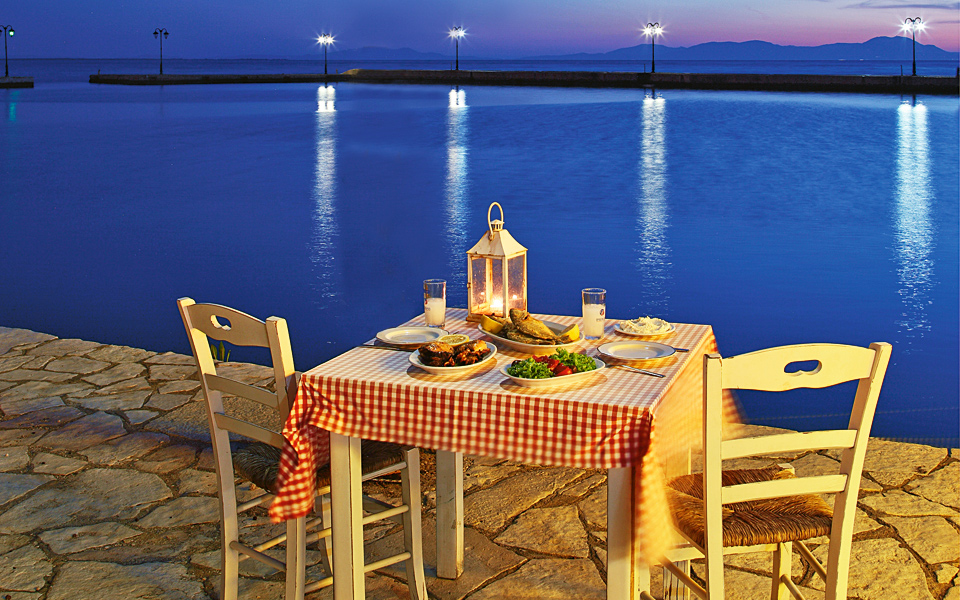
© Olga Charami
2. Fresh fish in Sagiada
(43k | 1 hour from Syvota)
A short promenade, a long beachfront, a spectacular sunset and a view of Corfu await visitors to the fishing village of Sagiada , just 10k from the border with Albania. The beaches of Keramidi and Strovili further north, along with the old settlement with its traditional stone houses, are reason enough to visit Sagiada, but most people will send you here for the delicious food . That’s because the fish served at the tavernas in the tiny harbor are all freshly caught. Not surprising when you consider that at least 50 of the village’s 700 residents are fishermen!
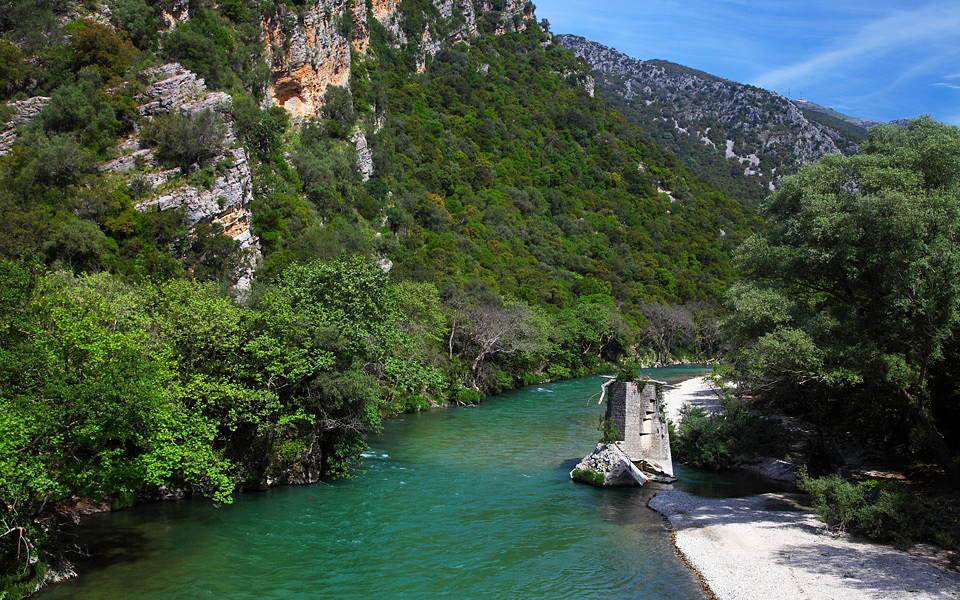
3. Along the river Kalamas
(60k | 1h20m from Syvota)
Running for approximately 115k, the Kalamas is one of the longest rivers in Epirus. It rises near Nemertsika Mountain in the Ioannina region and flows down to the Ionian Sea, forming an impressive delta between Igoumenitsa and Sagiada. Among its most stunning and easily accessible stretches are the area around Stena (i.e., “gorge”) and its estuary. At Stena, there are the ruins of the Boliana Bridge and, on a mountain slope nearby, the Byzantine citadel of Osdina where you can visit the beautiful churches of the Holy Archangels and the Dormition of the Mother of God. At the river delta, the maze of dirt roads can be tricky to navigate, but the beautiful scenery of riverside woodlands and lagoons makes it well worthwhile.
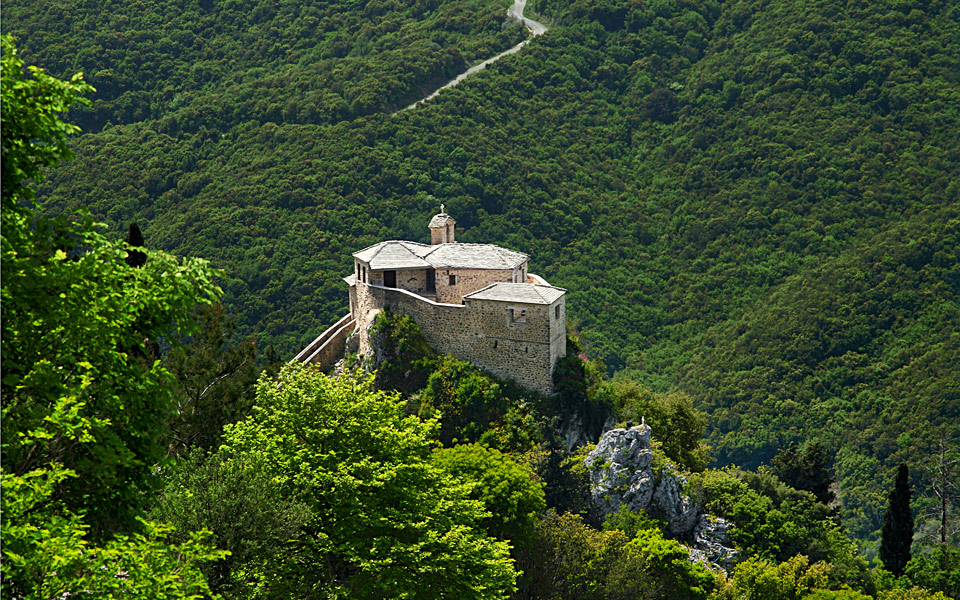
4. Intriguing monasteries
(45-50k | 1h10m from Syvota)
The Monastery of Giromeri, the Monastery of St. Minas at Kokkinolithari and the Hermitage of St. Nilos are noted for their unusual settings and much beloved by the locals. The hermitage is a humble cave dwelling where the saint himself lived for several years; below it, there is a small chapel. This same St. Nilos founded the Monastery of Giromeri in the 14th c. The interior of the Katholikon (main church) is decorated with wall paintings from the 16th and 17th centuries. The Monastery of St. Minas at Kokkinolithari is a dependency of Giromeri. The monastery perches atop a small rock, earning it the nickname “Meteora of Epirus”. The locals can all tell you stories of the miracles they credit to their venerated monastery.
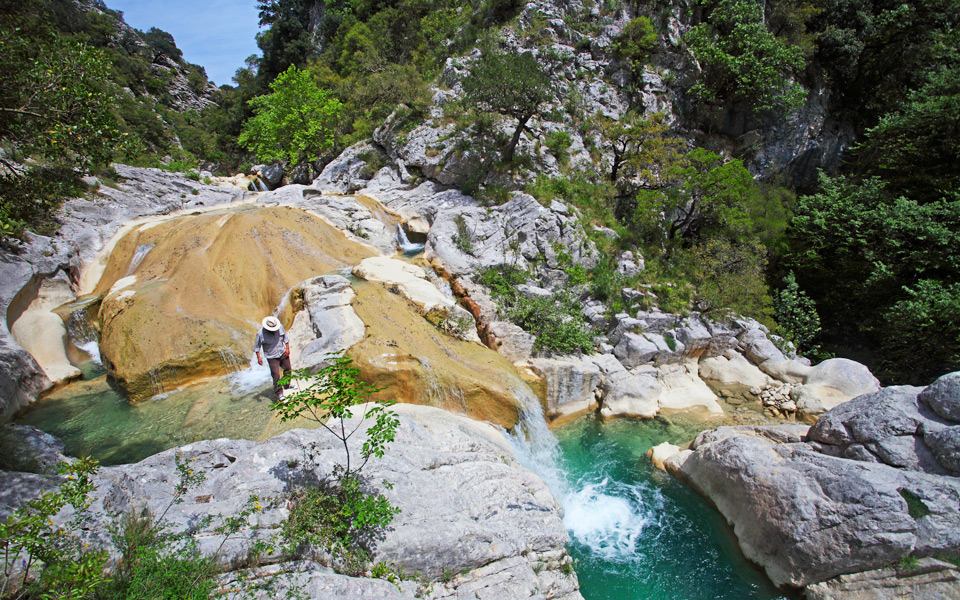
5. Hike through stunning scenes
(50k | 1h15m from Syvota)
A dramatic gorge, large river pools with crystal-clear water, a succession of waterfalls, streams flowing everywhere, lush vegetation. In the bed of the Dafni River , Vothnes pools are formed and provide truly stunning scenery for a hike. The deeper you proceed into the gorge, the more delightful it becomes. To enter the gorge, you need to walk for about an hour along the Laggaris , a beautiful stone path that starts just before the village of Kokkinolithari. Built during the Ottoman occupation, this path was used by the nomadic mountain communities of Epirus, as well as for the transport of the famed salt of Sagiada across to Ioannina.
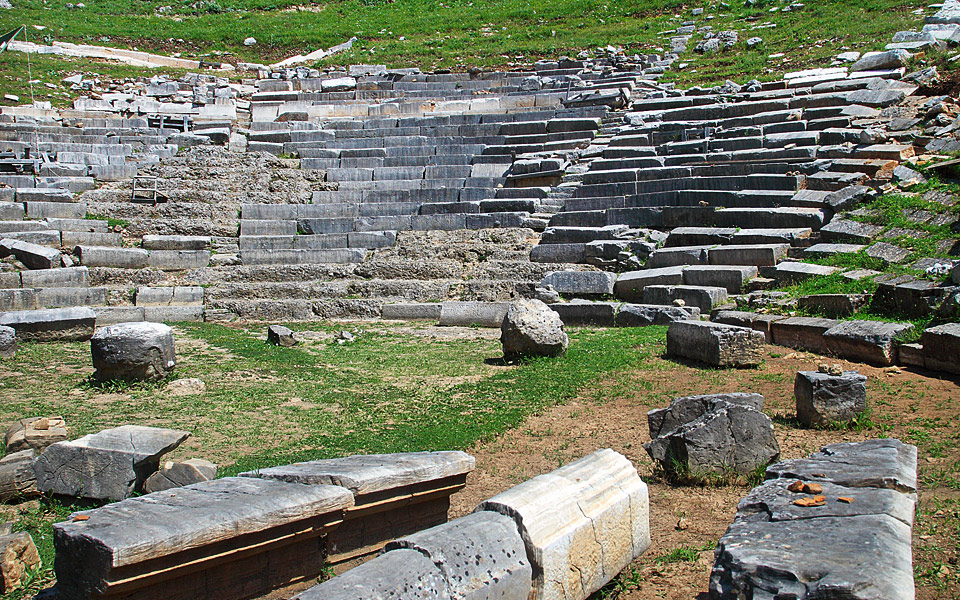
6. The ancient theaters of Gitana
(40k | 1 hour from Syvota)
Socrates , Armodika, Nikomachos, Alexandros, Nikophon: these are some of the names inscribed on the stone seats at the ancient theater of Gitana (or Gitanae). This theater, rare even by Greek standards, was built of limestone in the mid-3rd c. BC and had a seating capacity of 4,000. The theater belonged to the once powerful ancient city of Gitana, the second capital of the Koinon (or ‘League’) of the Thesprotians from its founding in 330 BC until its conquest by the Romans in 167 BC. The city occupied a commanding position next to the Kalamas river. The Kalamas was a navigable river at the time, so it afforded access to the sea while serving as a natural defensive barrier for the city.
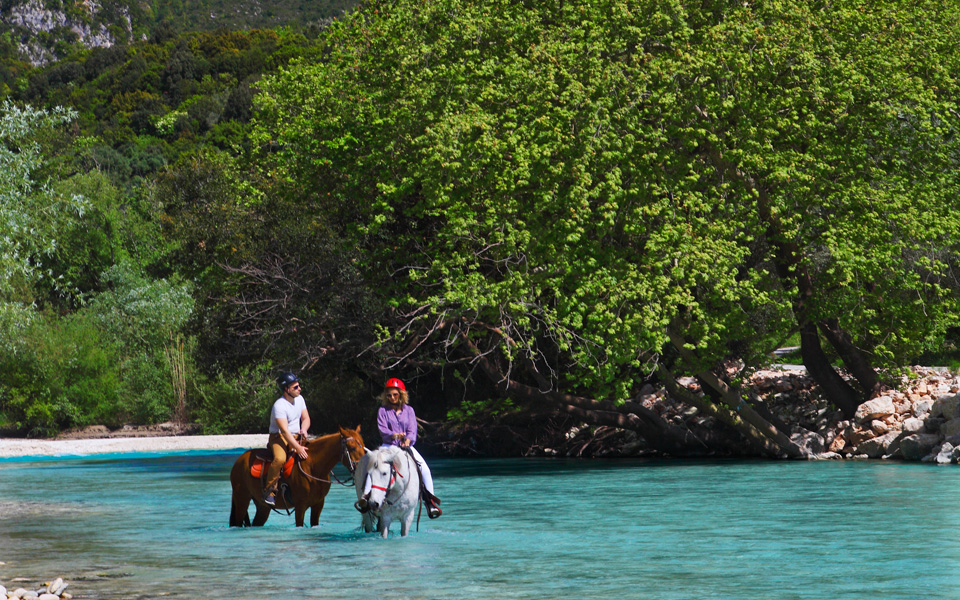
7. Gateway to the Underworld
(52k | 1h10m from Syvota)
In ancient times, Acheron was the river across which the souls of the dead were ferried to the Underworld. Today, at its mouth in the village of Ammoudia , modern-day “ferrymen” are on hand to re-enact these fateful crossings. Twelve kilometers to the east, the village of Glyki is the perfect base for discovering the “river of woe”. This is where the path through the Acheron Gorge begins; the walk takes 5-6 hours, but there are shorter ones, too. This is also where several rafting companies operate offering varying levels of difficulty, as well as horse riding. In summer, the area is full of tents, RVs, food trucks and hundreds of people, proving just how lively the gateway to Hades really is.
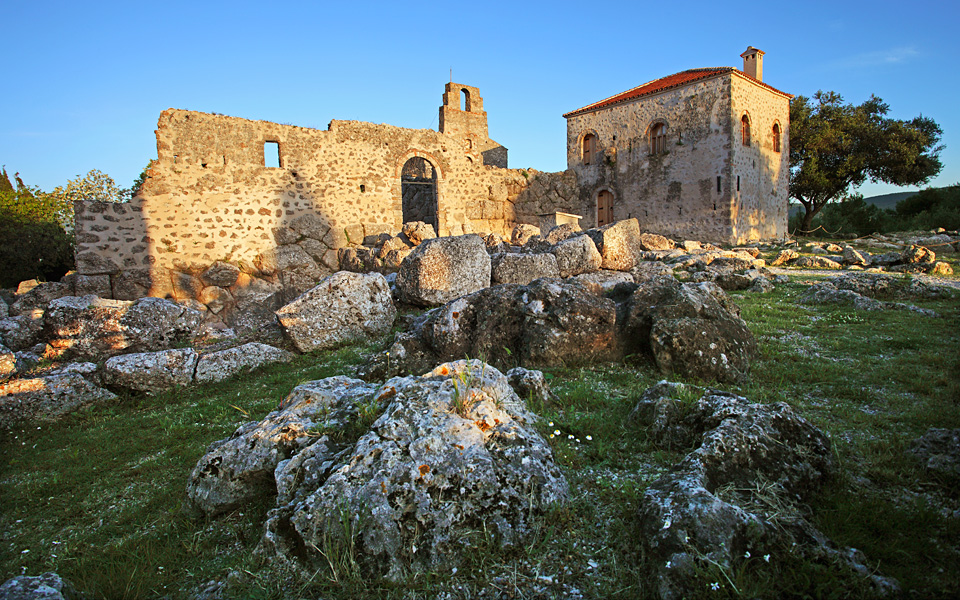
8. The Oracle of the Dead
(50k | 1 hour from Syvota)
They say that if you spend enough time in the underground hall of the Necromanteion (“Oracle of the Dead”) of the Acheron river, you’ll feel dizzy and your hearing will become impaired. No one knows if this is due to a lack of oxygen, the acoustics or something supernatural, but the guides at the archaeological site of the Necromanteio will be happy to tell you what they know. The sanctuary is thought to have been constructed in the late 4th or early 3rd c. BC, although the site was first inhabited much earlier. In the early 18th c., the Monastery of Aghios Ioannis Prodromos was built over the ruins. The Necromanteion is a fascinating structure, its most striking feature being the underground chamber carved out of rock, with 15 stone arches supporting the roof. It is believed it was here that visitors were brought to commune with the souls of the dead.
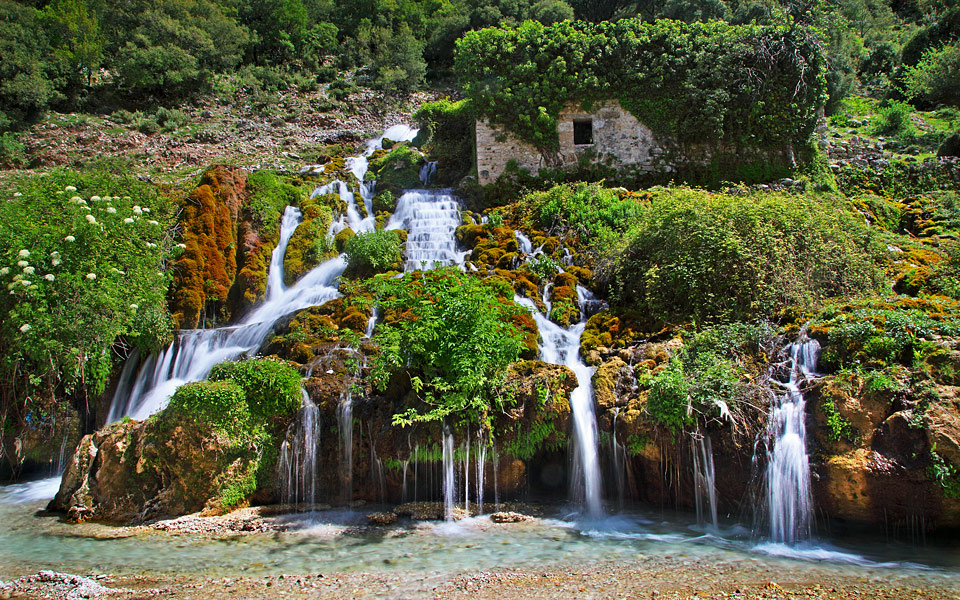
9. The legend of Souli
(68k| 1h30m from Syvota)
Rugged mountains that look like natural fortresses, arid and strewn with boulders. This is the location of a historical site known as Souli, famous for its role in the Greek liberation . It is particularly known for its valiant women, 22 of whom jumped to their death from the Rock of Zalongo in December 1803 to avoid enemy capture.
Today, there are happier things to see in this small farming village, including the stone houses of the local resistance leaders’ families. Sit at one of the two coffee shops to learn about the history of the place or, if you’re in the mood for a walk, make your way from here to Kougi. There, you will see the Church of Aghia Paraskevi and its amazing view. Across the way lies the fortress of Kiafa . Complete your excursion at Myloi Souliou . The fork in the road, leads to a ravine with running water, a restored watermill and a charming café right next to the river.
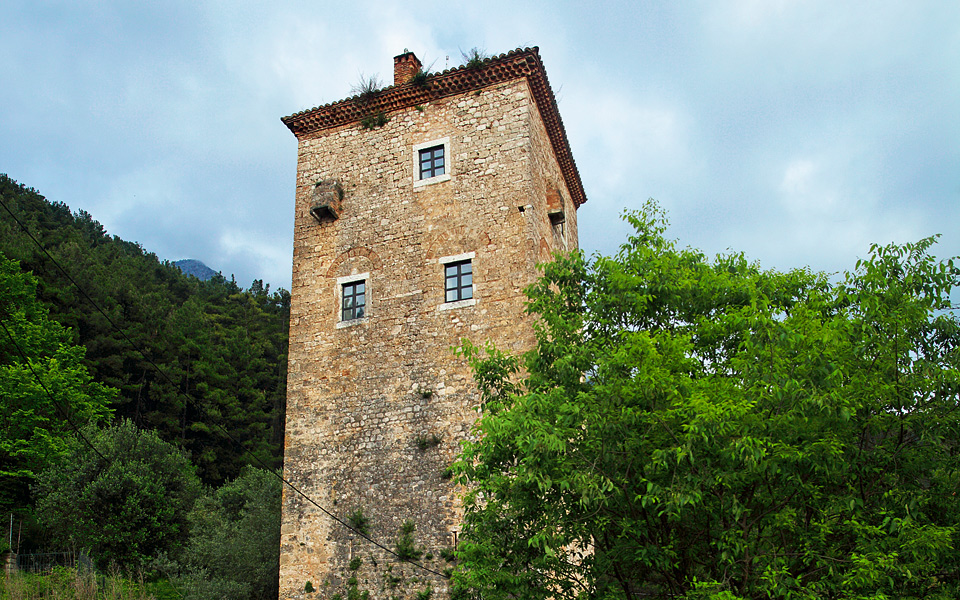
10. The Paramythia tower
(45k | 1 hour from Syvota)
Paramythia was one of the largest commercial and financial centers of Epirus. Nowadays, the Saturday street market may not be as grand and diverse but, along with the historic Lambovo Commercial Festival in October, it is still an important local tradition. Don’t miss the splendid tower at the top of the village. The Koulia , as it is called, was built in the late 18th to early 19th c. Standing 26m in height, the five-story tower has arrow slits for archers and holes through which boiling oil was poured on attackers. The Koulia is an outstanding example of a fortified tower house, among the finest still standing in northwest Greece. Thanks to restoration work, it is now also possible to tour the interior , which houses a permanent photographic exhibition of the monuments of Thesprotia from Byzantine times to the late period of Ottoman rule.
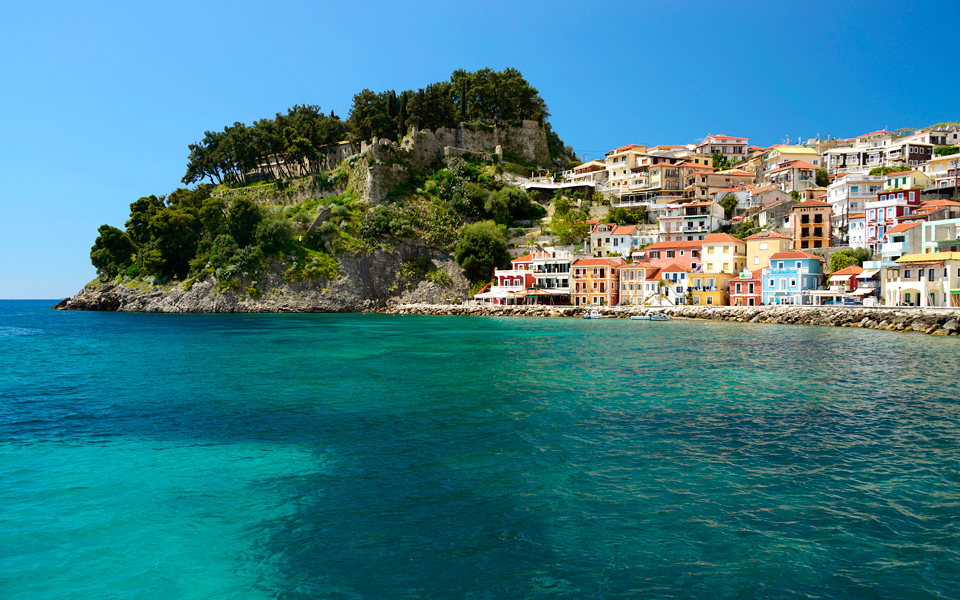
© Shutterstock
11. A stroll in Parga
(27k| 50 minutes from Syvota)
A true gem of the region, Parga has always been targeted by invaders. This is true even today, although the “conquerors,” sunbathers, swimmers and beachcombers, have more benign intentions. Here, visitors can enjoy the clear waters of its stunning beaches (Kryoneri, Piso Kryoneri, Valtos) and the picture-postcard beauty of its brightly colored houses laid out amphitheatrically, or they can indulge in leisurely walks through its narrow alleyways and down the lively promenade lined with ouzo bars and coffee shops. No one should miss a visit to the splendid Venetian castle at the top of the hill overlooking the town, where you can enjoy a drink at the café while taking in the incredible view.
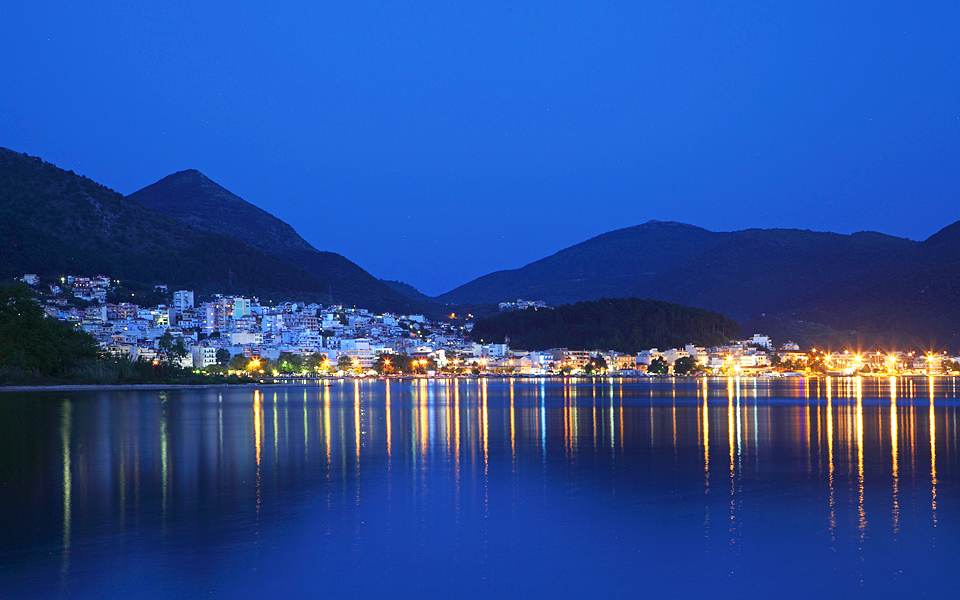
12. Coffe and Culture in Igoumenitsa
(24k | 35 minutes from Syvota)
Igoumenitsa, which was declared the c apital of Thesprotia in 1938 may be a relatively new town, but it is definitely worth a visit. Here, visitors can sip coffee in one of its numerous squares, take a stroll along its walk-cycle path next to the sea, climb up to the small castle on the lush green hill, or go swimming at nearby Drepano . Other options include a visit to the Museum of Culture and Tradition “The House of Rena” with its fine examples of traditional dress, embroidery and 2,000 other artifacts. The Archaeological Museum of Igoumenitsa is also not to be missed. It features exhibits that shed light on the customs and everyday life of the ancient Thesprotians. Finish the day by finding a spot to admire the amazing sunset.

SUBSCRIBE TO OUR NEWSLETTER
Thank you for signing up.
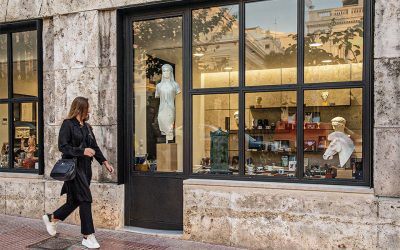
Places to Be: What’s Hot in Athens Now
Check out these exciting places to be, new arrivals, shows,...

Editor's Pick
This team of experts will help you live your own myth in greece.
"Boundless Life," a company from Montreal, is helping to relocate...
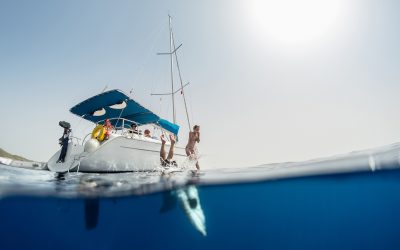
23 Experiences to Have in Greece in 2023
If there’s one thing we know, it’s this: there’s always...
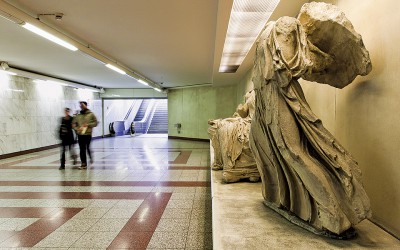
Things to Do in Athens on a Budget
Even if your bank balance is feeling a bit tight...
Share This Page
Greece Is Blog Posts
An ode to local products.
BY Yiouli Eptakili
No more avocado toast and croque-madames. From Thessaloniki to Crete...
read more >
How Can Greece Become a Gastro-Tourism Destination?
It’s about more than just taking a trip...
Leaving Room in Greece for Everyone
BY Greece Is
Labor Day, this year September 5, marks the...

Most Popular
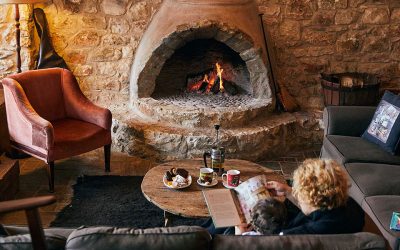
Peloponnese
five must-visit magical guesthouses in the peloponnese
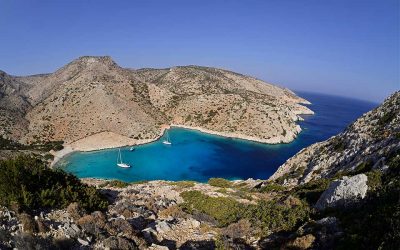
Aegean Islands
keros: the island of broken figurines
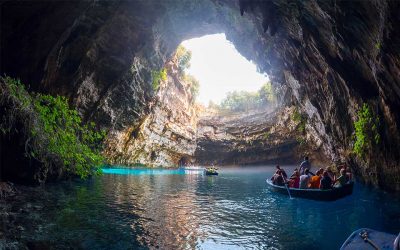
10 of the most spectacular caves in greece
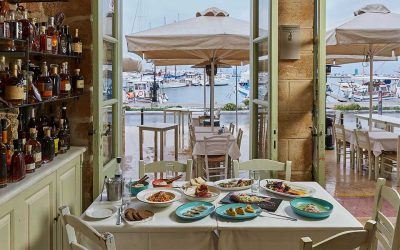
10 day trips to restaurants near athens
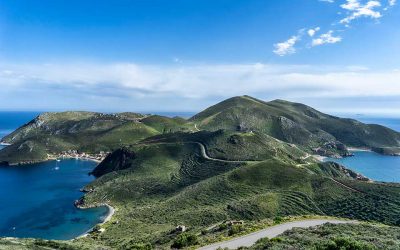
cape tainaron: gateway to the underworld
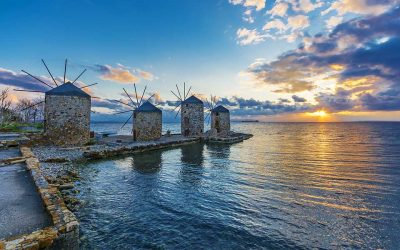
5 reasons to visit chios in spring

More Information
- Distribution
Publications
- Athens Summer 2015 Edition
- Santorini 2015 Edition
- Democracy Edition
- Peloponnese 2015 Edition
Sign Up for Premium Content, Special Offers & More.
- Terms of use
- Privacy Policy
Social Media

.© 2024 GREECE IS, NEES KATHIMERINES EKDOSEIS SINGLE-MEMBER S.A.
Powered by: Relevance | Developed by: Stonewave

Picturesque Towns of Western Greece You Should Visit
- Pinterest 611
- Flipboard 0
- Odnoklassniki icon Odnoklassniki
- Facebook Messenger
- LiveJournal
The mainland of Western Greece is comparatively less-visited by tourists. Yet you will find some really picturesque small towns in this part of Greece. This post follows our road trip route coming from Albania, and introduces you to a number of smaller towns worth a visit.
![west coast of greece travel The mainland coast of Greece has many picturesque towns you should visit by car or motorhome. These towns are cheaper to reach than the famous Greek islands. [Photo is of a sunset behind a large sailing boat in Plataria.]](https://dare2go.com/travel/wp-content/uploads/2020/07/west-greece-featured.jpg)
The mainland coast of Greece has many picturesque towns you should visit by car or motorhome. These towns are cheaper to reach than the famous Greek islands. [Photo is of a sunset behind a large sailing boat in Plataria.]
What you will find in this article:
The Bay of Plataria
Plataria is one of the first towns you will encounter when coming from the north. Whilst it is not as picturesque as some other small coastal towns, its location makes it worth a stopover. Sheltered inside a large sweeping bay, it has a long sandy beach and a nice port. There are still a number of plots left in town with no houses built on, showing that it’s a bit out of the way.
The title image above (with the sailing ship in front of the setting sun) was taken in Plataria.
The Beautiful Town of Parga
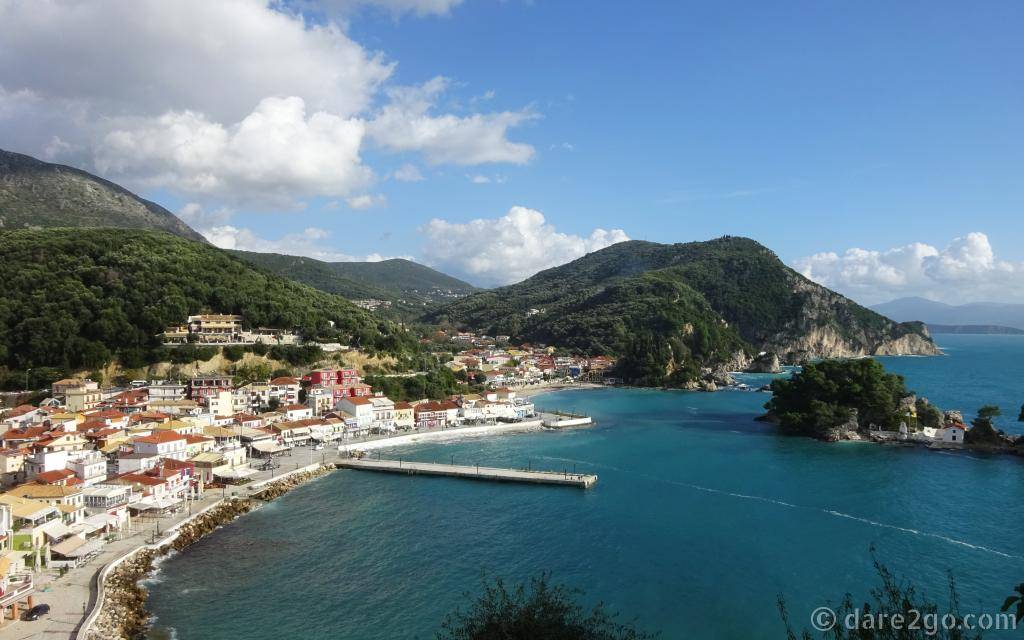
The waterfront of Parga as seen from the castle. On the right, the tiny island of Panagia with a small orthodox church.
Down along the coast you will come to Parga next. It’s a former, classic Greek fishing village with narrow, crooked lanes and shaded, steep stairways leading to houses further up the hill. The old town around the small fishing port is all pedestrianised and taken over by businesses living from tourists. The waterfront is lined with restaurants and bars – as everywhere else in Greece.
Parga has two landmarks, which make the town really photogenic. On the hill to the west are the well-preserved remains of a Venetian castle overlooking the horseshoe-shaped bay. You can visit the castle in season. (It was locked up when we first came through in November.) On Tuesdays it’s closed.
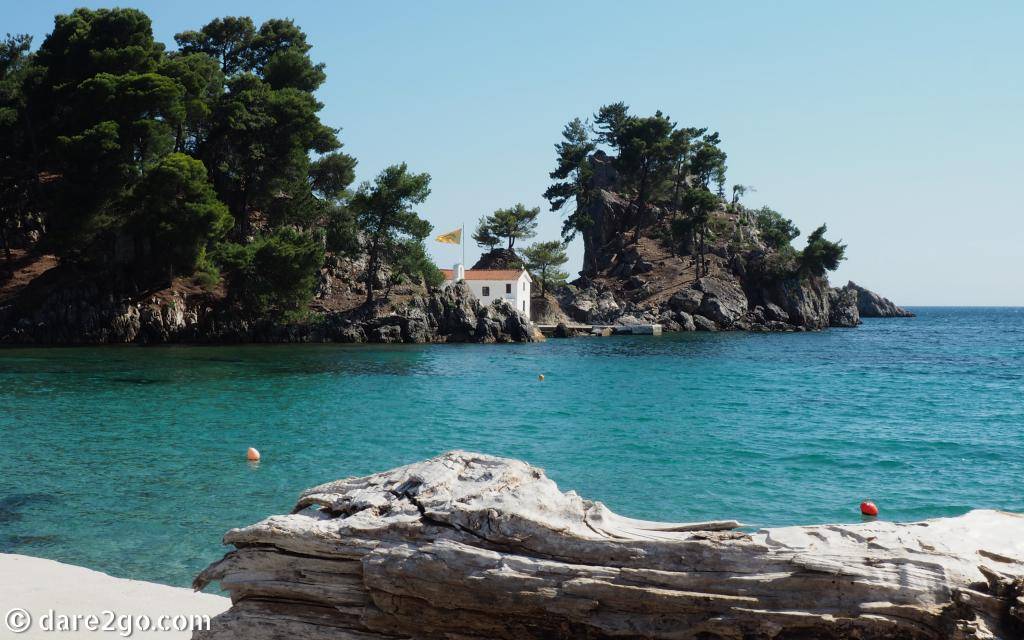
The island of Panagia seen from the waterfront promenade
Right across from the port is Panagia Island , with a small orthodox church on it. The island is so close that you can swim across to its tiny sandy bay (providing you are a confident swimmer).
There are two small sandy beaches near the town, which can be fairly crowded in peak season. Nearby, there are other sand beaches, but you will have to drive to them.
The Island and Old Town of Lefkas, or Lefkáda
Whilst not part of the mainland, strictly speaking, we include Lefkáda because you don’t need to take a ferry to get to this island; it’s connected to the mainland by a floating pontoon bridge. (When we re-visited in late June 2020, the original bridge had been removed for repairs and replaced by an anchored ferry stretching across the narrow waterway.)
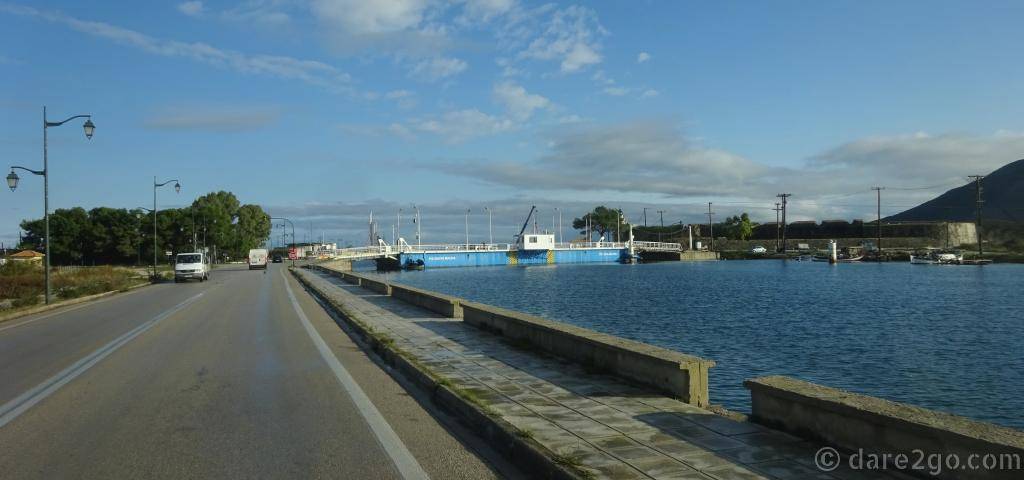
The blue barge on the right connects Lefkada Island with the mainland. In the background one of the old Venetian fortifications.
The direct road connection to Lefkas gives you the chance to explore a Greek island without having to take a boat ride!

One of the squares in the old town of Lefkas (Lefkada)
Although Lefkas is a popular tourist destination, it hasn’t lost its charm. We stayed several nights right by the main town. Lefkas or Lefkáda (same name as the entire island) has very unique and intriguing architecture: most of the houses were rebuilt after an earthquake and consequent tsunami in 1825, using galvanised iron or tin cladding on timber framing.
This is a style of architecture we are more familiar with from remote regions that are considered as “Pioneer Country”. We have seen many iron-clad buildings in Patagonia and in the Yukon, where the ease of transporting prefabricated houses into remote locations promoted this style of architecture.
We were surprised to find metal-clad houses in Greece, where normally older structures are built from natural stone. We had to search the internet for background information on this rare occurrence. Three factors contributed to this unique style:
- Lefkada was under British rule at the time of the earthquake in 1825; the British were in charge of the engineering
- the ease of rebuilding and obvious time-saving
- they are more flexible than stone houses, and therefore less prone to severe earthquake damage.
The town follows its ancient layout and is full of narrow lanes that no car can fit through. The advantage of this is that you walk in part shade most of the day. The older section is not laid out in an obvious grid pattern, so you might easily find yourself in a dead-end. Nevertheless, it’s a lovely place to wander around aimlessly and photograph the sometimes fairly dilapidated, or often beautifully renovated old houses. Three storey structures are mostly an exception in Lefkas.
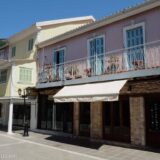
Around the Island of Lefkada
We drove around the island twice. Both times, we would have loved to spend more time exploring every nook and hidden small village. But sadly in early December, we had drizzling rain and low cloud; in June, we only had a handful of remaining Schengen Visa days before we had to leave Greece…
The Paralia Agios Ioannis beach to the west of the town of Lefkada is dotted with old windmills, an indication as to why nowadays, kite surfers are attracted to this part of the island’s coast. Lefkada has a large marina right at the edge of town. In the south the small towns of Vassiliki and Syvota also have sizeable marinas, encouraging yachts to visit the island.
Along the west side of the island, the main road winds through hills dotted with olive trees. Narrow dead-end side roads zigzag down to some of the prettiest sand beaches of the Ionian Sea . Several of these beaches are so picture-perfect that photos of them are often used to promote tourism in Greece . Of course, this contributes to the popularity of Lefkada Island as a destination.

An old windmill standing at the Agios Ioannis beach near Lefkas, with a kite surfer in the background.
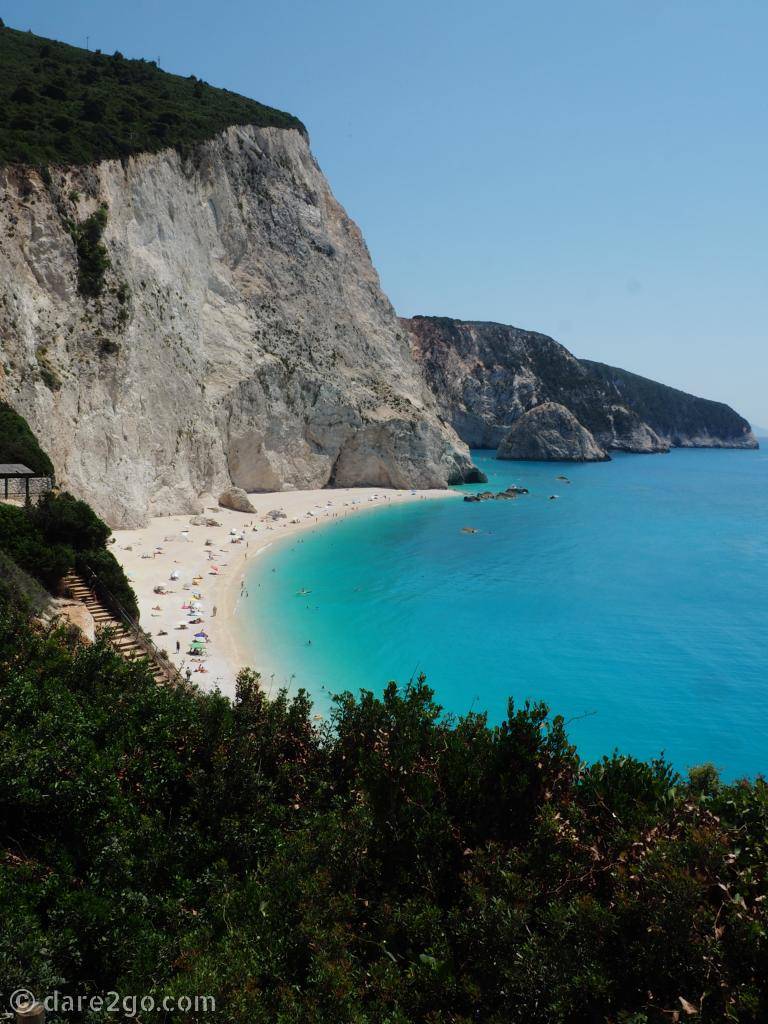
This is the beautiful white sand beach at Porto Katziki on Lefkada
The east coast is less mountainous, and nearly flat the closer you come back to the main town. Here you find a fairly sheltered inlet with a few small sandy bays and many more anchorages for yachts. This part of the island is also more built-up. The inland has retained its rural character with small olive farming communities, among which you will find some lovely hiking trails .
Historic Messolóngi and its Lagoon
You would probably bypass Messolóngi if not for its two unique attractions: the Garden of Heroes and the National Park of Mesolongi-Etoliko .

A very small section of the Garden of Heroes; in the foreground a French statue honouring their fallen citizens.

The statue commemorating Lord Byron, who died in Messolongi supporting Greece’s independence.
Among them is a statue of the British poet Lord Byron , who joined the movement and died here. Most are fairly ordinary statues, but a few stand out thanks to their style. Lord Byron is still held in high regard for his sacrifice and his statue is a centrepiece of the park.
The surrounding lagoons gave the town its name, which loosely translates to “amidst lagoons”. The 150 km 2 National Park of Mesolongi-Etoliko is recognised as an important habitat for the protection of hundreds of waterbird species. This makes it a great destination for bird watchers!
![west coast of greece travel Sunset behind one of the fishermen's huts in the lagoon of Messolóngi [photo credit ]](https://dare2go.com/travel/wp-content/uploads/2020/07/Messolongi-Lagoon.jpg)
Sunset behind one of the fishermen’s huts in the lagoon of Messolóngi [ photo credit ]
The Regional Centre of Nafpaktos

The Venetian fortress dominates the hill behind Nafpaktos
Of all the towns included here, Nafpaktos is the largest. It is located near the new Rio-Antirrio Bridge to the Peloponnese. The town is a busy regional centre with a lovely flair. There are a few sights, which make a visit worthwhile.
The first sight you’ll notice (after the enormous highway bridge) is a large Venetian fortress taking up most of the mountain above town, with its walls coming all the way down the steep slope. For the Venetians, this was an important strategic position, controlling all access into the Gulf of Corinth .
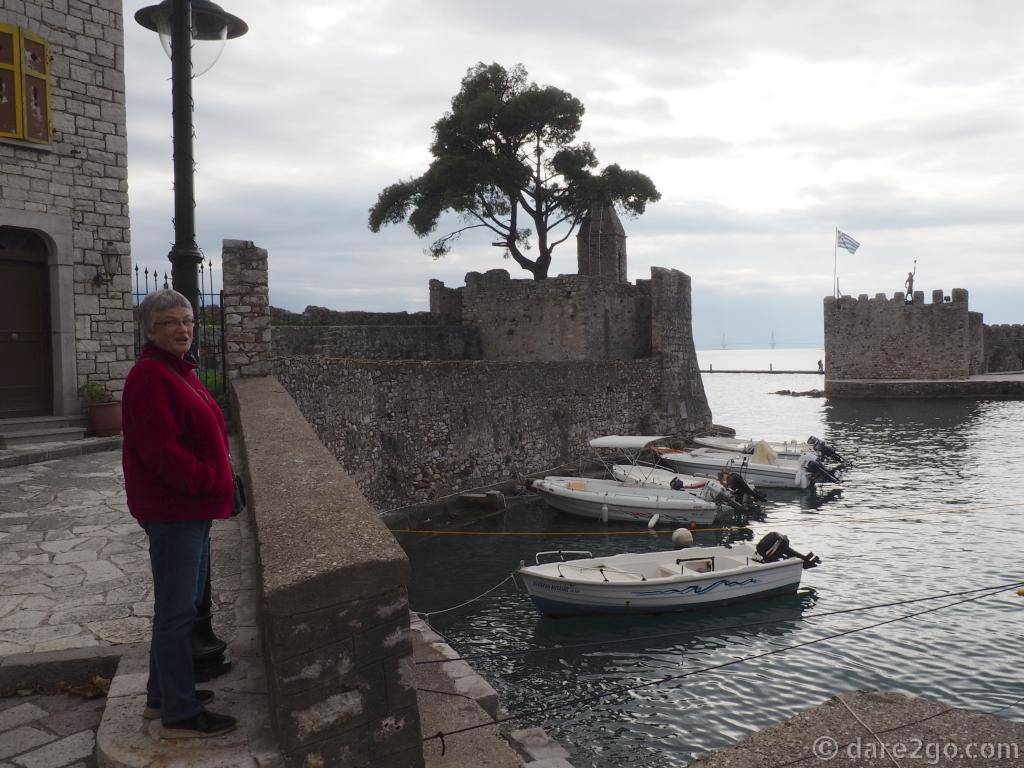
The old fortified Venetian port of Nafpaktos
In the centre of town, there is a small fortified port, just big enough for maybe a dozen regular fishing vessels. The port was constructed to harbour Venetian war and supply ships. Now it’s lined with outdoor cafes and restaurants. You will find Nafpaktos’ tourist information right opposite the old port. The Fethiye Mosque is a reminder of the city’s Ottoman past and the largest still-standing Ottoman-era mosque in Greece.
Along the town’s shore stretch its beaches, which are a little coarse with more pebbles than sand.
Galaxídi, famous for its Maritime History
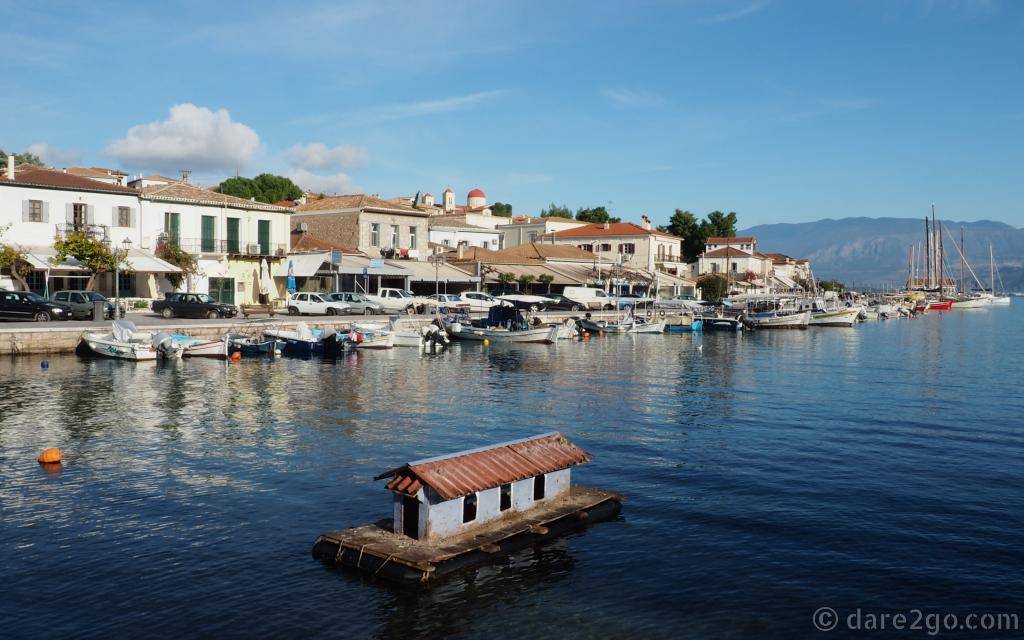
The laid-back, picturesque waterfront of Galaxidi
Until 1950, the small town of Galaxídi was not accessible by road; the only means to get to it was by boat. It’s hidden in a small bay by a hilly peninsular covered in pine forest. Once the whole town was surrounded by forests, which supplied the timber for the town’s then flourishing shipbuilding industry.
The skilled shipbuilders and captains from Galaxidi were highly respected, some worked as far away as Messolongi and Nafpaktos. In the 18th and 19th centuries, their fame reached well beyond Greece. Several captains from Galaxidi were respected members of the court of Ali Pasha of Ioannina . However, when steamships began to populate the seas, Galaxidi didn’t adjust and its sailing fleet lost its importance.
Today, many substantial Neo-Classical houses of the former shipbuilders and captains are still preserved around its two ports. Several of these protected buildings are now occupied by upmarket seafood restaurants. The compact Nautical Museum recalls the town’s glorious past.
To the north of the town is a long and narrow, mostly sandy beach.
TIP: It’s only 34 kilometres from Galaxidi, via the busy town of Itea , to the World Heritage listed site of Delphi . This is one of Greece’s most important archaeological sights. It’s an easy and attractive day trip.
Map of the Picturesque Towns in West Greece

Our road trip route along the coast of West Greece. We came from Albania (top left corner) and continued towards Thessaloniki in the North-East.
Additional Tips for Motorhomes
Greece has some truly picturesque places to stay a night or two with a motorhome. If you’re really lucky, you will find a spot away from houses and the typical barking dogs.
We visited the region out of season when most camping places were closed. Then the police are quite easy-going and tolerate free camping if you are not staying for days in the same location. Some ocean-front sites are under the jurisdiction of the Coast Guard of Greece, who seem to take a tougher stance on wild camping. During the peak summer season, you can expect to be sent to a campground.
Please leave all camping locations at least as clean as you find them! We sometimes pick up the rubbish others have left behind. To refill with water doesn’t seem to be a problem anywhere in Greece. You often find taps (faucets) in town squares or at cemeteries.
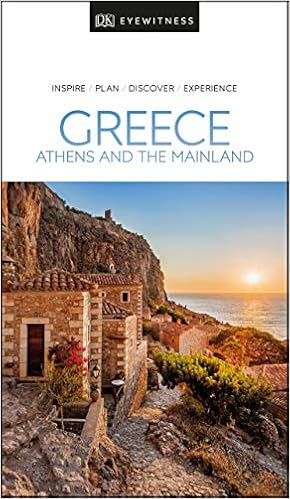
Practical Advice for Greece
Greece is part of the European Union and a member of the Schengen. As such you have the Euro as a currency and the normal Schengen entry requirements .
Museums and most archaeological sites are closed on Tuesdays (not Mondays as in other countries), so plan your sightseeing accordingly!
If you are not keen on ferry transfers back and forth to one of Greek’s many islands, you might want to explore the Western Mainland of the country. It’s less touristic than other parts and has many picturesque towns to visit.
Maybe hire a car and see these places on a round trip. This way you could pass by several of the famous orthodox monasteries in the inland, which cling to the tops of steep mountains like eagle nests.
Please share this post on Pinterest to show your friends or to remember for later:

Tags: archaeological site coast Nature Reserve roadtrip
webmaster, main photographer & driver, second cook and only husband at dare2go.com. Freelance web designer with 20+ years of experience at webbeetle.com.au
- Next story Visit the Superlative Fishbourne Roman Palace in Sussex
- Previous story Overlanding in Peru: Get Off The Pan-American Highway!
You may also like...
![west coast of greece travel Driving the Pan-American Highway – a dream of many. Our post summarises all the basic practical information you need to know before overlanding in Peru. [Photo: overland truck parked at the Nasca lines in Peru]](https://dare2go.com/travel/wp-content/uploads/2020/07/Overlanding-Peru-featured-1-520x245.jpg)
Overlanding in Peru: Get Off The Pan-American Highway!

Uruguay: Surprising In So Many Ways

A New Look at Paraná, Brazil after 8 Years
Leave a reply cancel reply.
Your email address will not be published. Required fields are marked *
Notify me when new comments are added.
"Keep up with Joneses" - sign up for our newsletter!
Hello & Welcome

Meet Yasha and Juergen. Our travel blog is atypical because we travel differently, not flying from one dream destination to the next. Our choice instead: to take it slowly, take side roads, discover places aside from the typical "bucket list" and guidebook highlights. We drive and live in our self-built overland camper, called [ "Berta" ] "Bertita" (little Berta since 2018 in Europe) . You can read more on our "About Us" page.
We love sharing our impressions and knowledge gained along the way. You will find a wealth of information on our site, especially if you love road trips. So stay around and explore with us!
NEVER MISS AN UPDATE
Join our mailing list and receive an email when something important is happening at dare2go.com!
*)required field [We will use your email address only to send our email newsletter and nothing else. OUR PROMISE: we will keep your address private and won't spam you either!]
Our Recent Posts

Not all attractions in Germany are historic cities or castles ruins. Explore with us the historic circular Rundling Villages of the Wendland in Germany’s north.
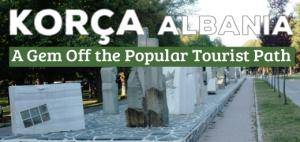
Korça is an undiscovered gem of Albania. Stroll through this city and you will find public art, green spaces, several museums, and plenty of cafes for a rest.

Bulgaria introduced the new electronic BGToll system for heavy vehicles and included motorhomes. In this post I explain how we dealt with this utter nuisance.

In April we asked overland travellers about the challenges they faced due to COVID-19 restrictions. 4 months later, we asked them: How are you doing now?

Superlatives to discover in Sussex: the largest Roman-style Villa in Great Britain with the oldest collection of mosaics and the first formal Roman garden.

Driving the Pan-American Highway – a dream of many. Our post summarises all the basic practical information you need to know before overlanding in Peru.

The ancient city of Butrint is a World Heritage Site in the south of Albania, where you can explore a history going back more than two-thousand years.

Our ultimate street art gallery from Colombia with photos taken in Medellin and Cartagena. 30 stunning murals, from nearly monochrome to really colourful.

How To Road Trip The West Coast of the Peloponnese
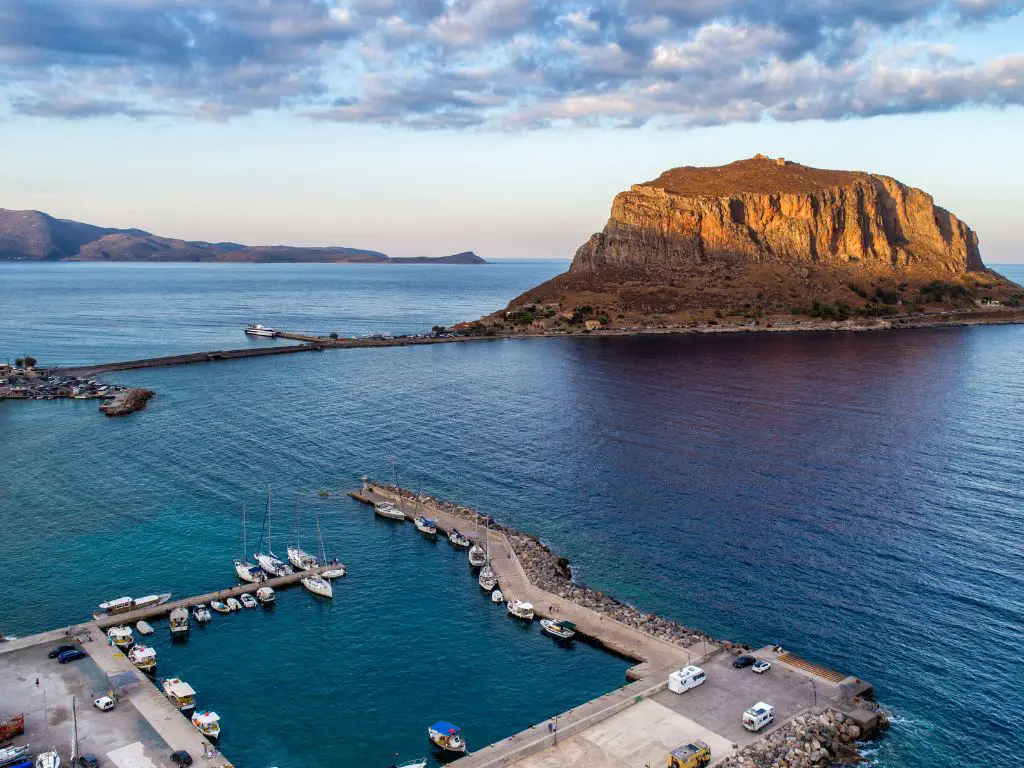
Related Posts

Your Guide to Dental Tourism in 5 Steps
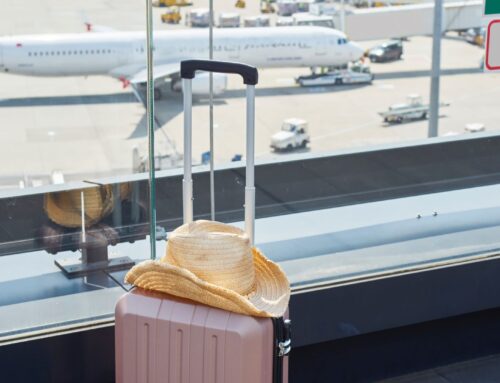
What is Dental Tourism and Is It Worth The Trip?
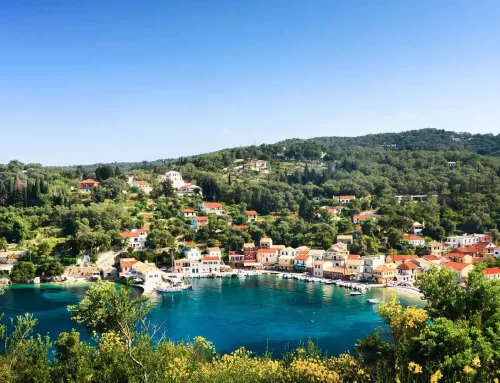
How To Get Around Greece

5 Museums in Greece That Will Amaze You

4 Lesser Known Greek Islands Known From Mythology
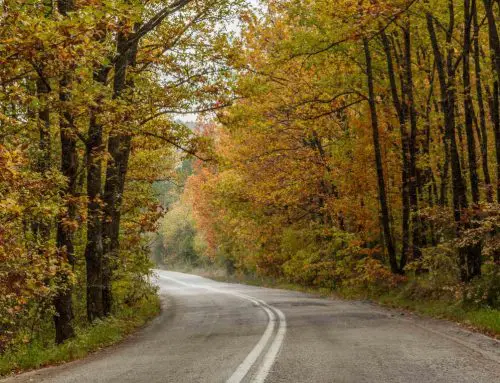
Visit Greece in the Fall: 3 Destinations You Will Fall In Love With
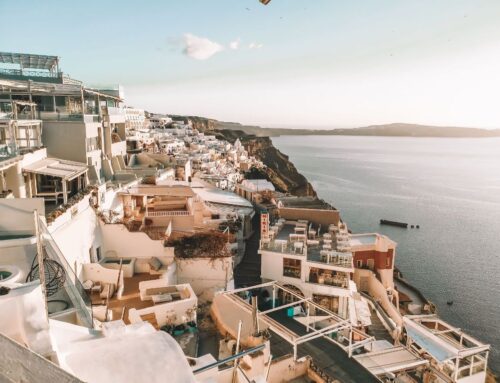
4 Greek Islands That Are Excellent Alternatives To Santorini
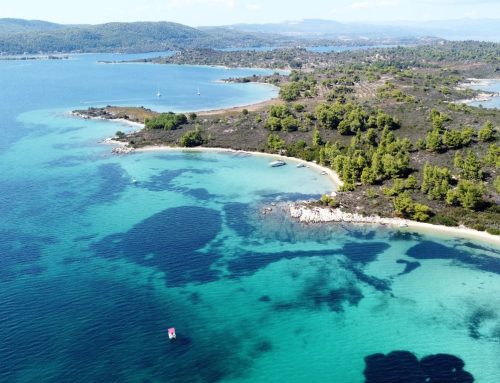
5 Reasons To Visit Greece in September
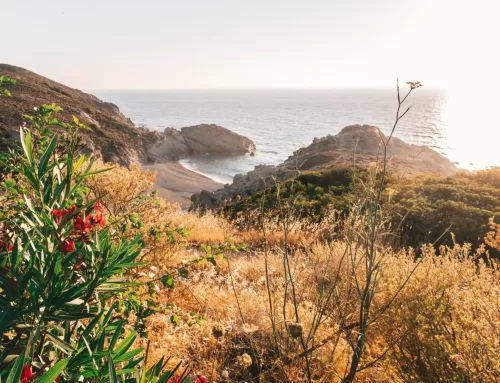
4 Crowd-Free Greek Islands for the Ultimate Slow Living Lifestyle
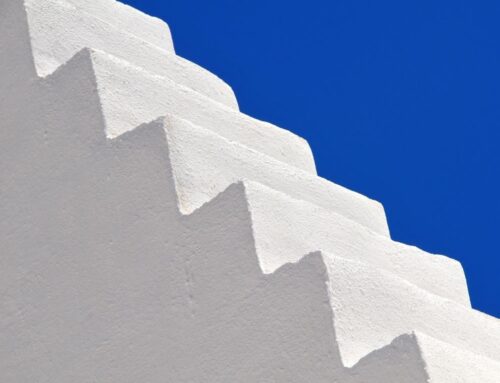
The Real Reason Behind Greece’s White Houses
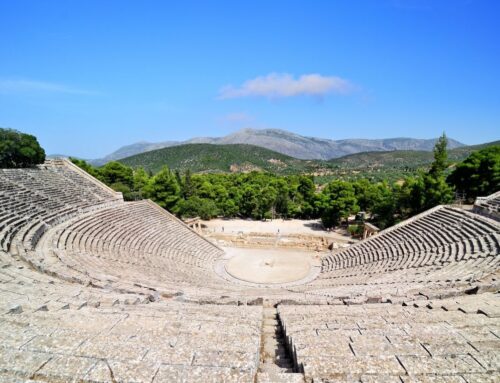
10 Fascinating Facts About The Epidaurus Ancient Theatre
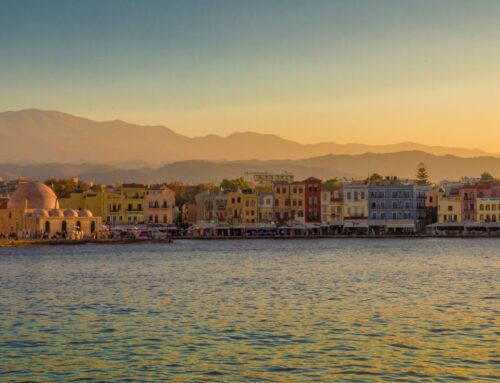
12 Facts About Crete You Need To Know Before You Go

10 Things To Know About The Assumption Of The Virgin Mary
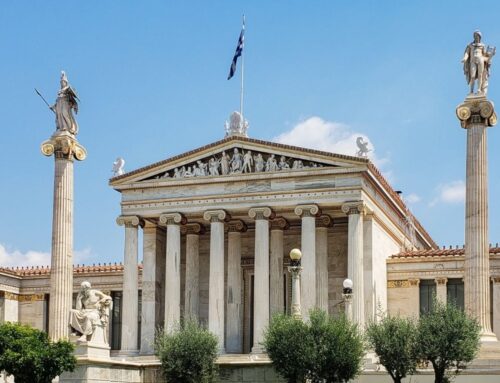
10 Of The Best Landmarks In Athens To See For Yourself

Everything You Need To Know About The Acropolis Museum In Athens
Search your next destination..., ☞ table of contents:, small villages & swimming.
- Ancient Olympia
Putting It All Together
Swimming options, cities/villages to stop at.
A road trip around the Peloponnese is the ideal way to experience the place!
Greece, is full of amazing places and this time I am writing about a special one, the Western part of the Peloponnese . I have been waiting to share my love for this land with you because that’s where my parents come from and I have spent many of my childhood and adulthood holidays over here. My experience on road trips around the Peloponnese, some times with family, others with groups of friends, has convinced me that this is the perfect place for a summer road trip. Let’s find out why shall we?
I will start with the city of Patras.
It’s the third-largest city of Greece and the largest in the Peloponnese. Only a two and a half-hour drive from the capital, Athens , Patra waits to be discovered. Although, Patra is really famous for the local carnival (not to miss if you are in Greece during this period- it varies from January to March), is also the best place to start your Peloponnese road trip. The most spectacular element of this city is the Rion-Antirion bridge. It is the connection of the Peloponnese with mainland Greece and has also become the emblem of the city.
The quarter of Rion is also the ideal place for a summer night out. All the bars, cafes and restaurants are spread across the shore, where the gentle breeze travels from the sea. Another option, if you do not want to leave the city centre, is the Riga Ferraiou pedestrian area. A huge variety of options is available there. DO NOT forget to try the local wine, its name is Mavrodaphne and it is one of the best Greek wines with a unique taste due to the ageing and maturation process. If you can, pick a bottle that has been aged for a while, to experience the truly decadent and complex flavours that come about.
Want to see more the next day? Visit the archaeological museum , with its impressive architectural style. The exhibits come from the city itself and the Western Achaea region. Afterwards, you can go to Saint Andrew’s Cathedral, the biggest one in the Balkans.
Patra, as a big city, has a lot of things to do, but we are going to move on with this road trip and head southwest. On our way to Ilia region, we stop at the sandy beach of Kalogria. It is, by far, the best place to swim in the whole Achaea region. Many kilometres of golden sand and turquoise water are found next to a paradise, Strofilia forest; a strip that separates the Ionian sea from lake Prokopos. The forest of Strofilia is a natural reserve of 22 km 2 in a tiny peninsula and is part of the Natura 2000 network. This combination of nature and deep blue water will take your breath away!!
The next place to visit is located on the north-western edge of the Peloponnese. Killini is a small fishermen village that became famous due to the port that connects Zakynthos and Cephalonia to the Peloponnese and mainland Greece. The nearby area is the perfect place to spend a few days. I suggest the following:
- Swimming! Killini has a beach of its own. But if you are up for a bit of adventure, choose Kafkalida beach; a beach that has not been changed at all by human activity. In the open sea, by the shore that houses the lighthouse, without the noise and crowds, you will enjoy the tranquillity of Kafkalida. If you are super lucky, you might see dolphins too! Another one is Analipsi beach; it has the soft golden sand that the region is known for being covered with.
- Visit Chlemoutsi castle! Only 6km away, this well preserved Frankish castle is totally worth the climbing. Get ready to be amazed by the view! (More Castles You Need To Discover In The Peloponnese)
- For lunch or dinner, eat in Sou-Mou restaurant, which serves traditional Greek plates, with emphasis on seafood.
Now, its time to move towards the south. The coast of Ilia is well-known for its really long sandy beaches. One of them is the beach at Loutra Killinis. Words cannot describe this exotic place. The beach extends around a huge area, with parts that are organized and offer amenities and water sports facilities, and more isolated ones, ideal for relaxing. The name, Loutra beach, comes from the thermal baths of the area. The area is wonderful, full of trees, like cedars, eucalyptuses, pine trees and tamarisk. Many come at Loutra to try inhalation therapy, mud therapy or balneotherapy. Even if you are not suffering from any problems, give it a try, you will feel much better afterwards.
Really close to Loutra is a village called Arkoudi. You can spend your day in the village’s beach or go to the neighbouring Glifa beach. Both are very nice with many facilities. Arkoudi is also famous for its cocktail bars. Thalassa café-bar combines tasty flavours with a spectacular sea view.
Kourouta, the next stop, is another famous summer spot in the Peloponnese .In a few words, we could say that this is the ultimate summer destination. Once more, kilometres of sandy beach, with sports facilities and many bars and restaurants to choose from. A word on safety though, this one has some dangerous water; it gets really deep really fast and due to the position (in the open sea), it has big waves quite often. Due to that there is always a lifeguard, to make sure you have the best experience. Kourouta, is also famous among the Greeks, for its nightlife So, if you decide to spend your night over there, you need to also go out for a drink!
The last place to visit before going to Ancient Olympia , is Katakolo. A popular cruise ship port, Katakolo offers access to Ancient Olympia for those who travel by sea. Apart from being the point of entry into the Peloponnese, Katakolo is a cute, seaside village, perfect for a quick visit. What to see? The Museum of Ancient Greek Technology, which exhibits inventions and mechanisms of the antiquity, and Pontikokastro, a Byzantine fortress built on the ruins of Ancient Pheia.
Now, it’s time to leave the coast, and for good reason!
It’s time for the “star” of the Peloponnese and Greece in general, Ancient Olympia , the birthplace of the Olympic Games. During ancient times, the most important event of the whole world used to take place here. Every four years, every Greek city, send the best athletes to participate in the games to honour Zeus, the father of gods and men. The games were of such importance, that every war or conflict ceased for the duration of the games. The prize? An olive wreath and eternal glory. A walk through the ruins of the ancient temples and stadiums will make you feel like you have stepped back in time, among the athletes and the ancient kings!
Today, Ancient Olympia is still the center and starting point of the modern Olympic Games. In front of the temple of Hera, the lighting of the Olympic Flame takes place. Afterwards, it travels the whole world, until it arrives at the host country. The ceremony is similar to what it would have been during ancient times, with the priestesses lighting up the torch with the help of a parabolic mirror.
The last goodbye in Ilia comes from lake Kaiafas and Zacharo. The lake is a natural beauty, positioned in between the Ionian sea and the Lapithas Mountains. The beach next to the lake, along with the Zacharo beach are of great beauty. I recommend you visit them both. Last but not least, take some time to visit the local thermal springs. The combination of sea, lake, forest and baths are something extraordinary and as a result, the area is listed in the National Natura 2000 network.
As we move towards the borders of Ilia and Messinia, changing region for the last time in our Peloponnese road trip, we come across a hidden sanctuary, the Neda waterfalls.
Leave the car in the parking lot, and start descending the dirt road. After a few minutes of walking, you will be at the entrance. Then, an amazing scenery awaits you. The gorge that houses the Neda river, offers an unforgettable hiking experience. The path is not extremely difficult, but you should still come prepared (shoes, water, hat, swimming suit etc). You can then choose in which one of the waterfalls you want to cool down in. Relax and enjoy it!
This Peloponnese road trip continues, as we enter Messinia, one of the most beautiful prefectures in the Peloponnese and in Greece. Elea is the first village that we meet on our way. The beach is dreamy and is really famous for camping. An organized camping facility is located on the beach, but if you are a true nature lover, Elea hosts many who choose to live closer to nature for a few days.
Just a few kilometres away,as we drive the E09 route, the small picturesque town of Kyparissia peeks out. Climb up the windy roads and take yourself to the old town. Tiny, paved alleys, cute souvenir shops, traditional Greek restaurants, café-bars with stunning views and a looming medieval castle, compose a must-visit destination! Kyparissia offers more options regarding accommodation, food, shops and entertainment.
After leaving behind Kyparissia, we head towards Voidokilia beach. It is certainly one of the most impressive places I’ve ever been to. The beach forms a circle around the sea and makes you lose all sense of direction. I for one also lost my sense of depth because of the unfamiliar circle shape. Voidokilia is located on the edge of Gialova lagoon, a wetland of paramount importance. It is the southernmost station in the Balkans for the birds which migrate to and from Africa. A Natura 2000 area, it hosts numerous species of birds as well as an observatory. The beauty of the landscape is insane!
The nearby village of Gialova, is a nice place to have a bite or a coffee.
Moving on to Pylos, another pretty small city, which was once known by another name. The name Navarino came as a result of the battle of Navarino, that took place in those waters during the Greek War of Independence almost 200 years ago. Built in an amphitheatrical shape, with a cosy small harbour, Pylos invites you to walk by the sea during sunset and enjoy your coffee in one of the traditional kafenia!
Methoni comes next. For one more time, another small city by the sea. What makes it unique? The castle that occupies the end of the city. After walking around a little bit, take the boat from the harbour, to visit the uninhabited island of Sapientza; a paradise on earth, with a heavenly, white-sand beach. Except for a few visitors during the summer months, Sapientza only hosts a number of friendly goats that love to come really close to humans!
Foinikounta is one of the last stops of our Peloponnese road trip. A village ready to accommodate the needs of everybody who visits it. With 4 camping spots, it has kind of become a favourite camping destination. Actually, those who camp in Foinikounta once, always come back. I am one of them, and have so far spend 3 of my summer holidays over there!
After a quick stop in the charming town of Koroni (it has an amazing shore for swimming and an enchanting city centre), we are close to our journey’s end. Polylimnio waterfalls are a little bit to the north of Koroni, in the mainland Peloponnese. The waterfalls are spread across different levels. The first one is easily accessible. While moving further inside, the hike gets more and more difficult. It’s up to you, to which waterfall you are willing to get. However, the scenery will be worth it.
- Loutra Killinis
- Neda Waterfalls
- Voidokilia Beach
- Polylimnio Waterfalls
- Strofilia Forest
- Lake Kaifas/Zacharo
*Disclaimer: This page includes affiliate links. If you decide to book something through one of them, I might get a little bonus, but it won't cost you anything extra.*
Related Articles
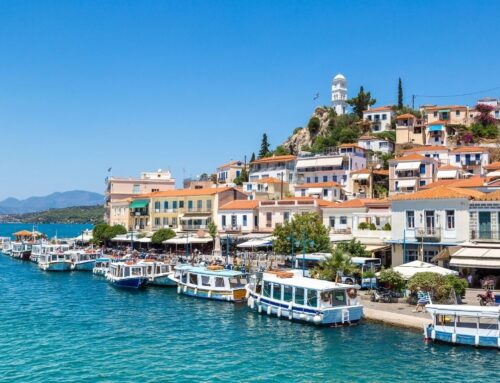
5 Islands Close To Athens For A Quick Getaway
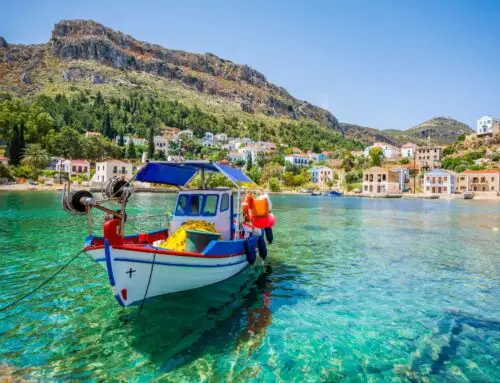
4 Small Greek Islands That Will Leave A Big Impression
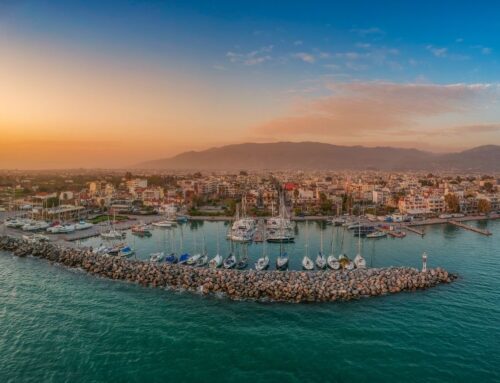
5 Magical Peloponnese Cities You Need To See

10 Of The Most Amazing Things To Do In Paros
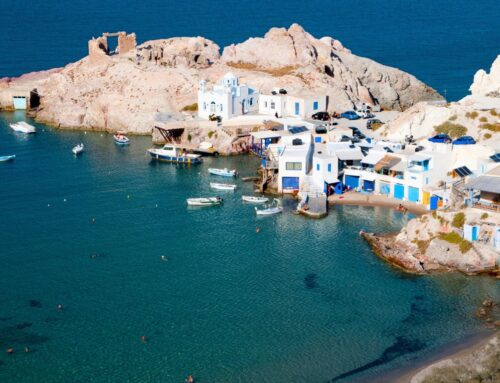
The Best Things To Do In Milos For Summer
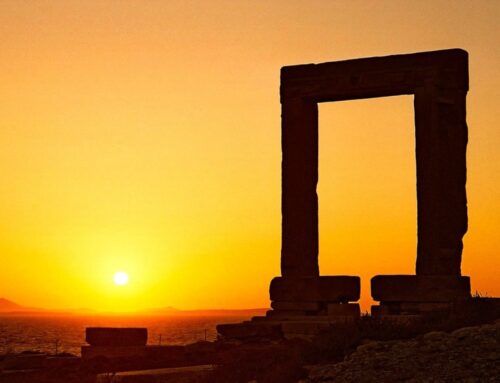
20 Impressive Landmarks In Greece You Have To See
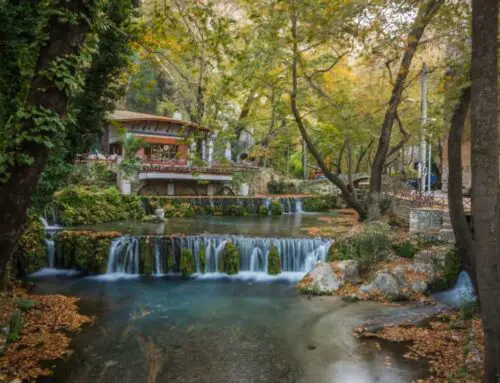
10 Things To Do In The Sweet Little Town Of Livadeia
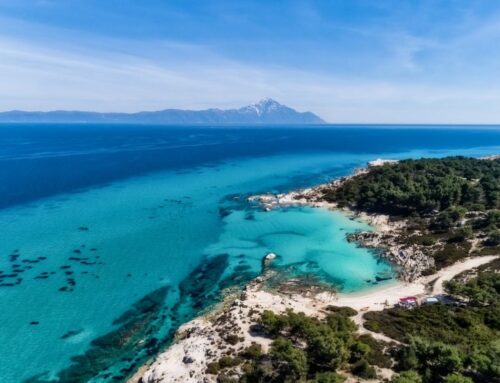
10 Places To See in Mainland Greece Before Leaving For The Islands
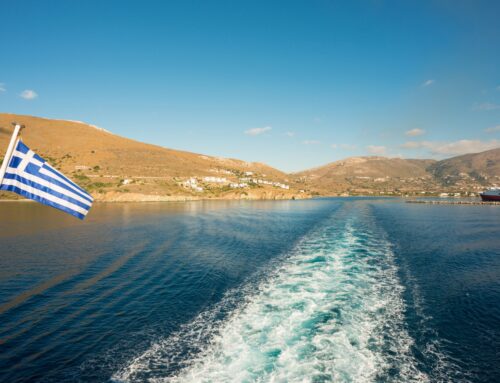
The Best Of Greece – The Perfect Greek Island Hopping Itinerary

10 Incredible Ancient Greek Sites To Add To Your Bucket List

One trip can last a lifetime. Let’s begin!
one trip can last a lifetime. Let’s begin!
INFORMATION
GET IN TOUCH
© 2024 – All rights reserved. • Powered by WordPress


Corfu – An Unspoilt Island Guide
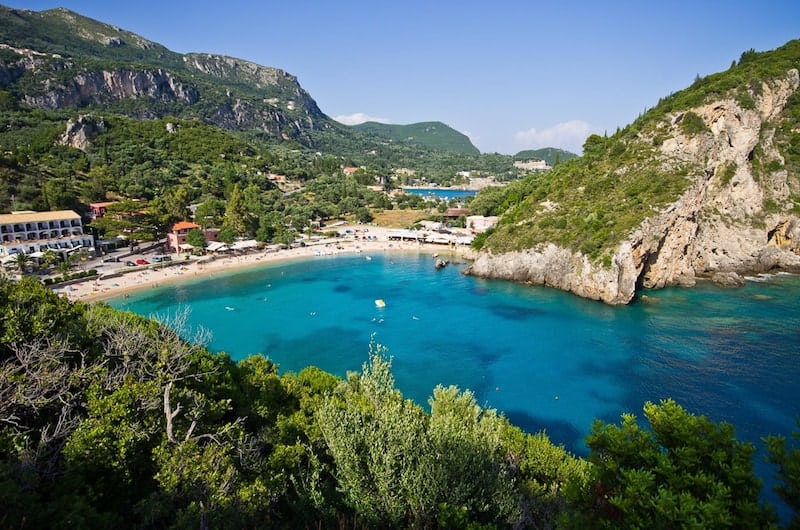
With countless beaches and secret coves, stunning mountain scenery, the Venetian streets of its historic capital, it’s no wonder that Corfu is one of the most popular destinations in Greece.
I happen to love Corfu. It was the first place I ever visited in Greece, on a family holiday back in my teens. I think the landscape is dreamy. One of the most northerly and greenest Greek islands, Corfu has an established tourist infrastructure – it was one of the first islands to embrace package tourism in the 1960s.
There a wide variety of resorts all around the coast, so there’s something to suit everyone here. And despite the number of visitors and developments, it has retained a wild beauty thanks to the rugged coastline which has charmed visitors for centuries (just look at the literature produced by the Durrells).
This travel guide covers:
- What’s the vibe like?
- Where to Stay on Corfu
- Food and Drink
- Best Beaches on Corfu
- What to Do and See on Corfu
- Hidden Gems
- Getting There and Around
WHAT’S THE VIBE?
The colours on Corfu are something else – from the aquamarines and emeralds of its seas, the dense inland evergreens, to the soft pinks and ochres of its weathered buildings which are echoed in the sunsets.
The beauty of the island is not confined to one part, and resorts are spread out around the island. But broadly speaking, the north of the island is more hilly and craggy with lots of little bays. The pretty stretch between Nissaki and Kassiopi is popular with wealthy Brits and Russians who like to hide away in discrete villas in the hills.
Safe sandy beaches attract package holidaymakers and families, particularly in the cheap and cheerful resorts that spread out along the coast in either direction from Corfu Town.
Corfu’s key strategic position – close to the mainland but controlling access to the Adriatic Sea – has ensured a rich and colourful history. Its Byzantine fortresses and are evidence of centuries of struggle against attacks. It was a key touch point between the Venetians and the Ottoman Empire.
The island never fell to the Ottomans, though, unlike many of the islands in the Aegean Sea. Instead, the legacy you see here is many Venetian and British – with a touch of French and Russian thrown in for good measure. Nowhere else in Greece will you find a cricket lawn and ginger beer.
Knarly olive trees dominate the landscape – thanks to a Venetian policy that encouraged its cultivation.
Corfu Town is a historical gem but also an administrative hub and home to the Ionian University, which keeps it lively even in the low season (in comparison to other island destinations, at least). Acharavi and Lefkimmi are two alternative options for winter.
The downside of its popularity is that the coastal regions aren’t exactly undiscovered – head to the mountainous interior if you want to escape tourism altogether.
One thing to note – Corfu has an ongoing issue with trash collection. The main landfill site is overflowing and illegal sites are popping up around the island. This isn’t a problem everywhere (you’re most likely to notice it on the roads leading into Corfu Town, and in the Lefkimmi/Kavos area) and it doesn’t affect the beaches – I suggest checking the Tripadvisor forums if you’re concerned. You can help by separating your waste whilst you’re there – recycling bins are available.

Don’t miss the chance to explore the UNESCO World Heritage-listed streets of the Corfu Old Town ; a unique part of Greece. Formerly known as Kastropolis – city of castles – this historic city upon first glance appears to have more in common with the fortified towns of nearby Croatian and Italian coasts than with its fellow Greek islands.
Corfu Town has a cosmopolitan and upmarket vibe. The nexus of the Old Town is the area around the Venetian Old Fortress, the Palace of Saint Michael and Saint George, and next to it the Spiniada (the bit with the cricket lawn) and the Liston (the French-influenced promenade).
For food and drinks try :
- To Dimarcho ,
- The Venetian Well .
- Rooftop drink at Cavalieri Hotel.
For evening vibes head to Bristol Cafe , 54 Dreamy Nights , or Sessions Cafe .
Read More: Exploring Corfu Old Town
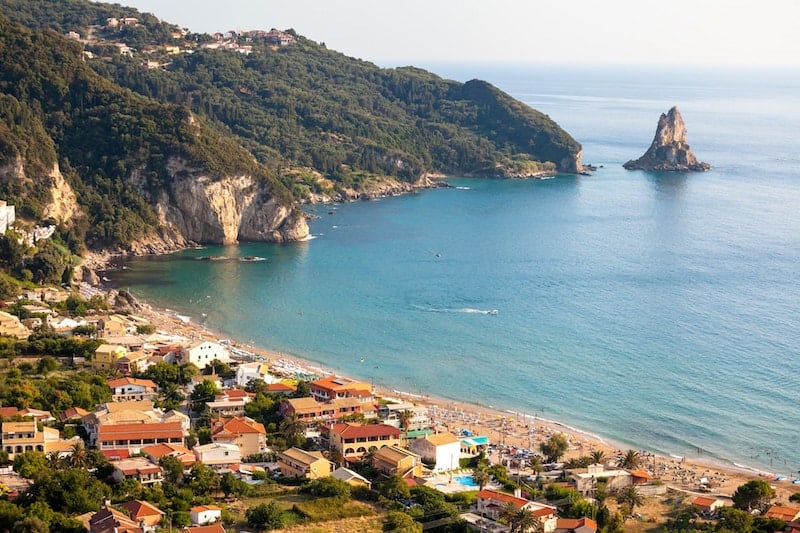
WHERE TO STAY
Corfu Town may seem like the obvious choice however accommodation is surprisingly hard to come by. It’s a popular (and easy) day trip from pretty much every resort on the island. As such, it hasn’t really developed an accommodation scene of its own – except the big resort hotels on the outskirts of town. The lack of budget accommodation is annoying if you have an early or late flight or ferry.
Top end choices in Corfu Town include classy boutique townhouses Siora Vittoria and Bella Venezia . Otherwise, it’s best to try Airbnb .
The best beach hotels on Corfu are MarBella , Ikos Dassia, Corfu Imperial Grecotel at Kontokali, and Mayor La Grotta Verde Grande at Agios Gordios. The blissful little beachfront Bella Mare Hotel is now an exclusive Simpson Travel property.
( read more – Corfu’s 10 Best Luxury Beach Hotel s)
The lush and rugged north of the island is where you’ll find upmarket little villages popular with the speedboat set, who stay in expensive villas up in the hills. This is also Durrells-country – Kalami and Koulouri.
And over on the west, Paleokastritsa is worthy of its popularity. The west is home to some dramatic coastal scenery, small resorts that are popular with independent travellers – Agios Gordios is the hostel epicentre with Pink Palace (for spring break vibes) and further up the coast is Sun Rock in Pelekas (for a more traditional family-run feel). Lovely Liapades around the corner is another good spot.
For good-value aparthotels and rooms check out the resort towns Kassiopi, Agios Gordios and Paleokastritsa, which haven’t lost their soul to development. Cheaper still are family favourites Acharavi, Sidari, Barbati, and Ipsos – the latter two are conveniently close to Corfu Town.
Check out Where to Stay on Corfu – The Ultimate Beach Resort Guide for a complete rundown on the coastal towns plus some accommodation picks in Corfu Town.

FOOD AND DRINK
There’s a strong Venetian element to the food on Corfu. You’ll find more Italian influences (and unique slow-cooked meat dishes) here than in other parts of Greece; pasta dishes, polenta, and tomato-based sauces are not uncommon.
A trio of traditional Corfiot dishes worth trying are pastitsada , bourdeto and sofrito . Pastitsada is a pasta dish made with rooster and a bright red sauce. Bourdeto is fish cooked in a tomato. And sofrito a dish made with veal or beef braised with wine and herbs. I’m also a fan of tsigarelli , which is a side dish of wild greens in a spicy tomato sauce.
Of course, you’ll also find all of the usual Greek taverna classics.
Corfu has its own microbrewery producing naturally brewed real ales. The brewery in Arilla is open to the public on Saturdays. I particularly enjoyed the Red Special Ale. Along with specialist Chimarios, they also make traditional Corfiot ginger beer, another legacy of British rule (the recipe was brought over by the army in the 19th century) and very refreshing in hot weather.
Kumquat trees (a type of tiny citrus) are common on Corfu and you’ll see kumquat liqueur in all the souvenir shops. I also once tried a delicious olive oil liqueur from Corfu but haven’t managed to find anything out about it (send me an email if you find it!).
And fig puddings ( sykomaida ) are a treat unique to Corfu – look out for small round bundles wrapped in leaves.
Don’t miss the seafood tavernas at Agni Bay.
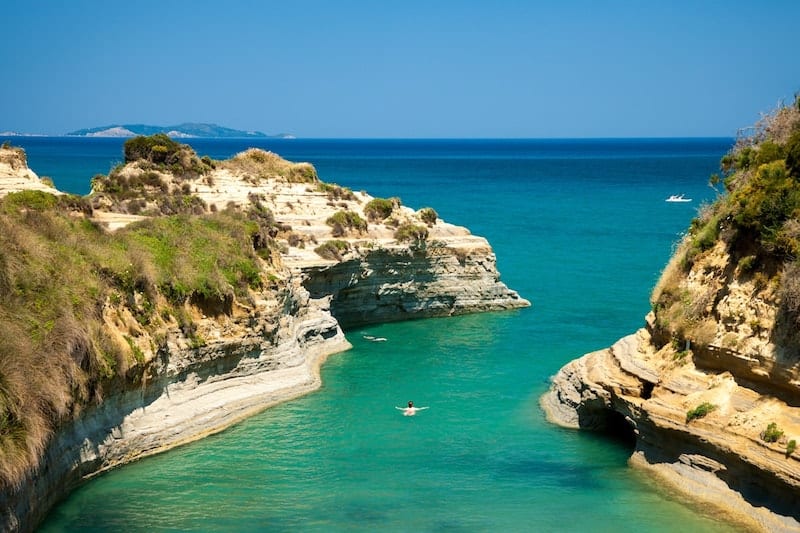
BEST BEACHES ON CORFU
Corfu has some of the best beaches in the Greek islands ; there’s a staggering variety – from white sandy beach to strange rock formations and idyllic coves. Here are the most beautiful worth checking out:
- Paleokastritsa . This popular resort town is built across a couple of bays and has a number of beaches; the sandiest is Agios Spyridon and the most Instagrammable is rocky La Grotta with its unique beach bar (be prepared for steps). Kastelli is cliff.
- Liapades and Rovinia . Two gorgeous pebbly beaches just around the coast from Paleokastritsa. This area of coast is full of hidden beaches and secret bays which are difficult to access.
- Agios Gordios . Perhaps the most versatile beach on the island, Agios Gordios has 2km of calm Blue Flag waters and soft sands surrounded by dramatic cliffs, excellent sunsets, and just enough watersports and entertainment without being overdeveloped. If it gets too crowded just head to Pelekas , Glyfada or the nudist beach at Mirtiotissa .
- Paradise Beach . Also known as Chomi, Paradise Beach has a small pebble beach at the bottom of steep white cliffs. It’s located south of Liapades and is only accessible by water taxi. To the south is the equally grand Stelari .
- Halikounas . If you prefer wide and wild unorganised natural beaches then head for Halikounas which edges Lake Korission in the south-west.
- Bataria and Pipitou are the key beaches at Kassiopi.
- Loggas . In the north, Loggas is another wild cliff-backed beached – this one accessible by steep steps.
- Porto Timoni . Also known as Afionas, this photogenic landmark is a narrow strip of land with a beach on either side. It’s hikeable from the wide sandy bay at Agios Georgios.
- Sidari . This beach resort is home to the famous rock formations of the Canal d’Amour (pictured above), which is now a popular selfie.
- Cape Drastis . Keep going north of Loggas to reach the white rock formations of Cape Drastis (or Drasti), the most northerly point of the island. You can visit by boat from Sidari, or hike here; there’s a small beach with a bar selling refreshments.
Looking to stay by the beach? Check out the complete guide to Corfu’s beach resorts .
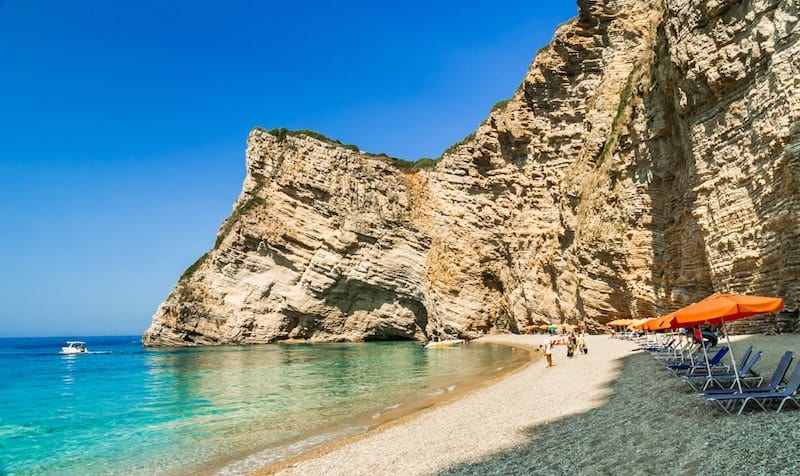
WHAT TO DO ON CORFU
It’s worth knowing that religious sites, museums and galleries often shut on a Monday in Greece.
Best things to do in Corfu Town:
- Old Fortress . The main attraction in Corfu Town is the Old Fortress (Paleokastro). St. George’s Church.
- Mon Repos is a historic villa (and birthplace of Prince Philip) on the outskirts of Corfu Town, next to the ancient ruins of Paleopolis. It houses an archaeological museum an is often included in tour itineraries along with the Achilleion – a palace in Gastouri built by the Empress of Austria.
- The Byzantine Museum showcases religious artwork is tucked away in a tiny church in Corfu Town.
- The Serbian Museum memorialises 150, 000 Serbian troops and refugees who died here during the First World War – many from starvation or disease. Entrance is free. The tiny island of Vido opposite Corfu Town served as a hospital, quarantine and cemetery. You can catch a local ferry over to this peaceful island, known as the ‘Blue Tomb’, which now houses a mausoleum and a taverna (open summer only).
- The Corfu Museum of Asian Art is located in the Palace of St. Michael and St. George (near the Liston), one of the main British buildings in the town
- The Museum of Banknotes is a few blocks back from the Liston and provides a fascinating overview of Greek currency.
- Corfu Walking Tours offer themed walking tours around Corfu Town, including options for foodies.
- Don’t miss the little monastery of Vlacherna and the tiny island Pontikonisi (also known as ‘Mouse Island) nearby (pictured above). This romantic spot is a 45-minute walk from Corfu Town and is close to Corfu Airport. In fact, so close there are a couple of bars perfectly set up to watch the planes land and the sun go down.
- If you have kids in tow, there’s a waterpark called Aqualand in the middle of the island.
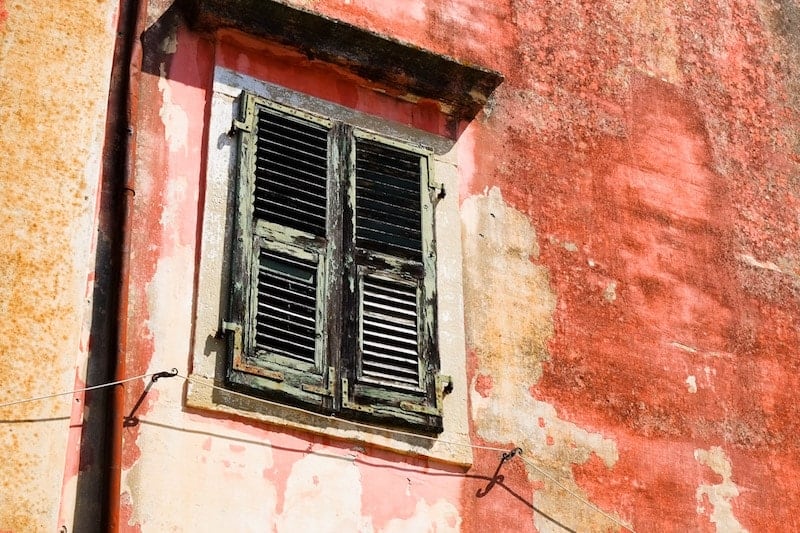
Best things to do outside Corfu Town:
- Angelokastro . is a hilltop Byzantine castle near Paleokastritsa with excellent views over the north-east coast.
- Nearby is the Monastery of Paleokastritsa, which has views over the village and houses the remains of a giant whale. It does get busy with tour buses in summer.
- Kassiopi Castle .
- Hire a speedboat for exploring the north east coast; many of the area’s best tavernas and beaches have jetties. The fish tavernas at Agni Bay are well known.
- Scuba Diving . There are numerous dive centres in the north of the island. Colovri and the Hole of Ha are the standout site.
- Hike Mount Pantokrator .
- Boat trips . Arguably the best way to see the stunning scenery is from a boat. Mainland honeypot Parga is just X away. Also close by are Corfu’s nearest Ionian neighbours Paxi and Antipaxi. And day trips to Albania can take in the gorgeous beaches at Ksamil, it’s worth paying extra to include UNESCO World Heritage site Butrint in your itinerary if you’re into historic sites.
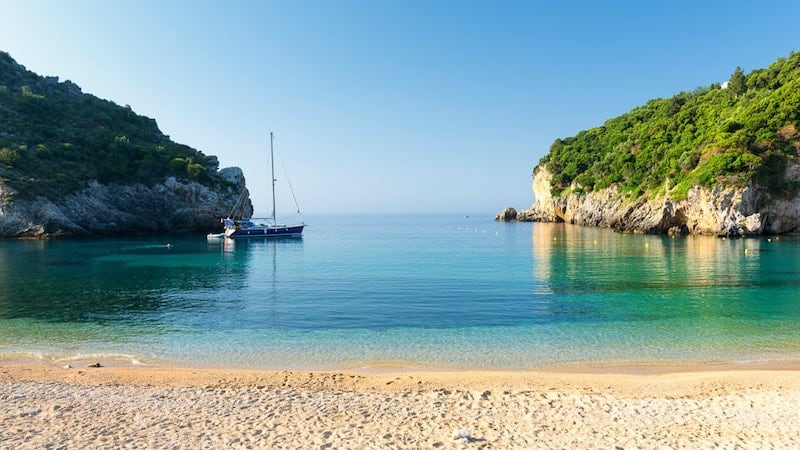
DURRELL-MANIA
- Exteriors for The Durrells’ villa were filmed at Villa Annemoyani north of Gouvia
- Lawrence and Nancy lived in Kalami, and today you can stay in their former residence The White House
- Many street scenes were filmed in Danilia, a curious remodelled village up in the hills behind Gouvia. It was also used as a set in For Your Eyes Only . It’s owned by Grecotel Hotels who run The Corfu Imperial Hotel in Kommeno Bay (which is also where the cast stay during filming). You can book a special package which includes accommodation at the Imperial, and tours of Danilia and The White House.

OFF THE BEATEN TRACK
Done the above and looking to discover a side of Corfu unspoilt by the masses? If you’re looking for quieter, off-beat attractions for culture vultures, authentic Corfiot villages with traditional life, or nature without the crowds, here are a few pointers to get you started
- Hike the Corfu Trail . Spanning nearly the length of the island at 220km, the Corfu Trail will take you deep into the island. It’s not the easiest – some parts are poorly waymarked and there’s a lack of accommodation. The sections near Paleokastritsa or Koulouri are ideal for a short hike. Check out the Trail website for more info.
- Korission Lagoon . You can sail, horse ride (from nearby Issos) and birdwatch at this nature lover’s paradise.
- Traditional Villages . If you’re driving around the south of the island, stop by the inland town of Lefkimmi for a slice of traditional Greek life (and lunch). Argyrades, Lakones, Chlomas, Vatos, Pelekas village (up in the hills above the beach) and Afionas village are also charming.
- Venetian Shipyard . Located near Gouvia, these 18th-century remains are worth a visit if you’re in the area, with cute little Ipapanti Church across the water.
- Corfu’s Secret Islands . Paxi and Antipaxi aren’t the only islands you can visit from Corfu. Less well known are the tiny idylls of Diapondia off the north coast – consisting of Erikoussa, Othoni and Mathraki islands (plus several uninhabited islets). In the summer you can find boats from Corfu Town as well as Sidari and Agios Stefanos.
- Corfu Donkey Sanctuary . You can visit the Sanctuary which is open year-round. To donate go to Friends of Corfu Donkey Rescue .
GETTING THERE AND AROUND
Corfu International Airport (or Ioannis Kapodistrias Airport ) is served by both domestic and international airlines. The airport is 3km south of Corfu Town. The view as you come in to land is quite spectacular so book a window seat. There are a few overpriced cafes and not much else, so don’t plan on spending too much time there if you can help it.
Line 15 connects the airport to the city’s bus terminal and the main city stop at San Rocco Square. From these stops, you can catch city buses around Corfu Town. For destinations around the island, Green Buses spread outwards from Corfu Town as a hub.
Car hire is ideal for exploring the island although roads can be steep and winding, with occasional potholes and plenty of giant tour buses coming the opposite way.
During the summer there are occasional routes linking beach resorts. CorfuPlus is well regarded for scooter and quad hire; get in touch with Sandy to discuss your needs.
FERRY CONNECTIONS
Corfu has a large ferry/cruise ship port.
International crossings are available to: Bari, Brindisi (Italy) and Sarande in Albania. Occasionally there are also routes to Ancona and Venice in Italy, Durres in Albania.
The main domestic connections are to Igoumenitsa and Patras on the Greek mainland, and the islands Paxos and Antipaxos. From Lefkimmi there are also boats to Igoumenitsa. The most frequent ferries to the Diapondia islands are from Agios Stefanos (NW).
Infrequent/nonexistent direct ferry connections to the rest of the Ionian islands (with the exception of Paxos and Antipaxos) make it tricky to include Corfu in an island hopping itinerary. Instead, you must go via the mainland.
Enjoyed this post? Click to save to Pinterest:
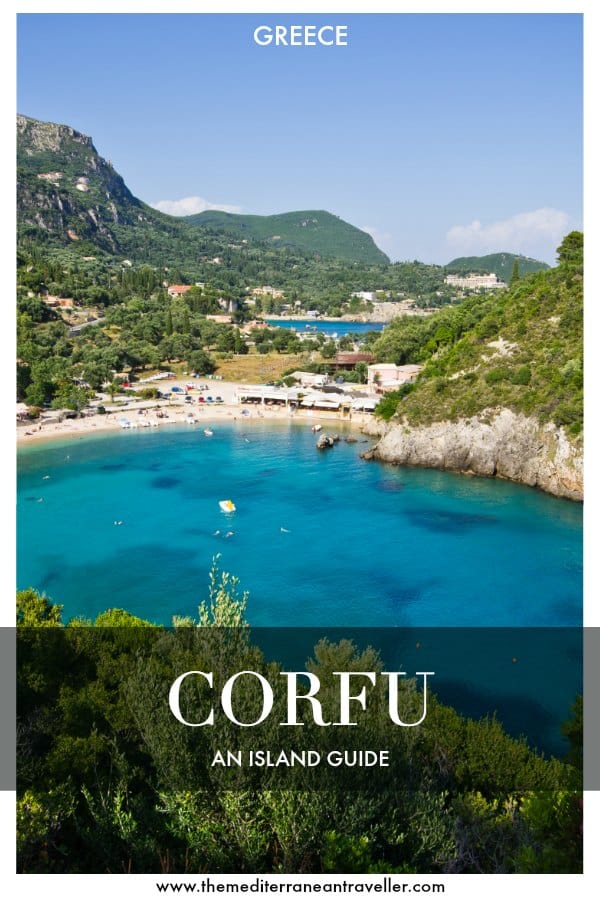
Image credits: Paleokastritsa © CCat82 / Adobe Stock, Vido Island © The Mediterranean Traveller, Old Fort © The Mediterranean Traveller, Barbati © whitewizzard / Adobe Stock, Sweet Treats © The Mediterranean Traveller, Sidari © Netfalls / Adobe Stock, Liapades © Lucian Bolca / Adobe Stock, Vlacherna Monastery © The Mediterranean Traveller, Pink Walls © The Mediterranean Traveller, Cape Drastis by etherial via Pixabay.

Share this post:

19 of the most beautiful beaches in Greece to visit during your free time
When it comes to gorgeous beaches, Greece is just plain tough to beat. The Mediterranean country is graced with months of warm, sunny weather, countless miles of pristine coastline, and some of the clearest, bluest water on the planet. Depending on which part of the country you visit, you can experience everything from technicolor volcanic beaches to miles-long stretches of soft, pink sand. (And did we mention the waterfront tavernas, whatever-you-want beach clubs, and empty coves that make the rest of the world fade away?)
How many beaches are in Greece? Too many to count. But here are some of the best beaches in Greece—from Corfu to Crete—to enjoy during your free time on tour, no matter what kind of sandy escape you crave.

Find your Greece tour

4.7 out of 5 stars

4.5 out of 5 stars

4.9 out of 5 stars

Read more Greece travel tips


Which Greek Islands Should You Visit?
If choosing among the cyclades, ionian, and dodecanese feels like greek to you, we can help locate the island paradise that suits your vacation personality..
- Copy Link copied

We’ve narrowed it down to our 18 favorite.
Photo by Dimitri Koskinas/Shutterstock
The cradle of Western civilization teems with blue skies, gin-clear seas, and sun-bleached archaeological splendors. Artists and writers have always swooned for this land of poetic ruins and vibrant culture, set against rugged mountains, picturesque harbors, and coves of sugar-white sand. Today Greece attracts everyone from honeymooners to families, foodies, clubbers, history buffs, and seekers of wind-swept solitude.
With over 2,000 idyllic islands, visitors are certainly spoiled for choice. If you’re wondering which is the nicest Greek island to visit, or which is the prettiest or most popular, we have some answers. Take a flight from Athens’s Eleftherios Venizelos airport (ATH), a ferry from nearby Piraeus on the Saronic Gulf, or begin your journey on a Mediterranean cruise , and start island-hopping to discover the spot that best speaks to your soul with one of these 18 best islands Greece has to offer.

Our favorite Greek islands are dotted among the Mediterranean and Aegean seas.
Illustration by Elizabeth See
Andros (Ándhros)
- Highlights: architecture, beaches, coastal drives, footpaths, mountains, ruins, scenery, villages
- Getting there: two-hour ferry from Rafina (near Athens)
- Where to stay: We like Onar Andros, a locally run collection of cottages that offer a real escape from the day-to-day.
- Book now: Onar Andros
This lush island attracts hikers with its wildflowers, mountains, coastal cliffs, lemon groves, and flowing streams (a rarity in the Cyclades). The Neolithic settlement at Strofilas, an archaeological site that dates back to 4500 B.C.E., is worth exploring. In more recent history, the island’s rich maritime culture led to wealthy shipowners packing Andros Town—aka “Chora” (you’ll notice that the largest town on many Greek islands is called Chora)—with neoclassical mansions. Watch for charming remnants of the Venetian era, like dovecote towers and dry-stone walls.

Cephalonia is laid-back and a bit eccentric.
Photo by Shutterstock
Cephalonia (Kefaloniá)
- Highlights: beaches, caves, culture, cuisine, forests, history, Italianate harbor villages, vineyards
- Getting there: European flights; 55-minute flight ATH-EFL; interisland and international Italian ferries
- Where to stay: Try Emelisse Nature Resort , a luxury retreat hidden among cypress and cedar trees beside the Ionian Sea.
- Book now: Emelisse Nature Resort
The largest of the Ionian islands off Greece’s west coast, this enchanting, uncrowded place offers beach lovers coves with sandy beaches and azure seas. Always a bit stubborn, set apart, and eccentric, Cephalonia won hearts after Louis de Bernières’s 1994 novel Captain Corelli’s Mandolin chronicled the island’s occupation during World War II. Today it’s celebrated for its laid-back lifestyle and excellent food, wine, and swimming beaches. Don’t miss Melissani, a turquoise underground lake illuminated by shafts of sunlight.

Corfu is a mellow, island destination perfect for hiking and swimming at its many beaches.
Photo by proslgn
Corfu (Kérkyra)
- Highlights: architecture, beaches, Italian cuisine, footpaths, history, scenery, UNESCO World Heritage site
- Getting there: European flights; hour-long flight ATH-CFU; interisland and international Italian ferries
- Where to stay: Bed down at Kontokali Bay Resort & Spa , which offers a family-friend luxury retreat not far from the town.
- Book now: Kontokali Bay Resort & Spa
Mythology says Odysseus was shipwrecked on this lush, lovely Ionian isle. In more modern times, it blossomed into an intellectual and artistic hot spot. Untouched by Ottoman oppression, Corfu was influenced instead by its time under Venetian, French, and British rule. This mountainous region remains a mellow, unspoilt destination (outside of patches of garish package-holiday resorts). Hikers can explore its coastline, peaks, olive groves, and pastel hill towns on the 124-mile Corfu Trail . Fancy a more relaxing stroll? Wander the Old Town of Corfu , an elegant fortified port and UNESCO World Heritage site.
Crete (Kríti)
- Highlights: archaeology, beaches, food, hiking, history, museums, partying, rugged scenery, tradition
- Getting there: European flights into Heraklion’s HER or Chania’s CHQ, 50- to 60-minute flights from ATH; nine-hour ferries from Piraeus (near Athens); interisland ferries
- Where to stay: Part of the Historic Hotels of Europe, and built around an old olive mill, Kapsaliana Village Hotel is a singular combination of rustic charm and modern luxury featuring bright and airy rooms and a tranquil swimming pool.
- Book now: Kapsaliana Village Hotel
Legends abound here: Zeus was born in a cave, Theseus slayed the Minotaur, and Daedalus and Icarus took flight. The landscape is equally dramatic with deep gorges, snowcapped peaks, and sandy shorelines. Europe’s first urban civilization flourished in Crete: The Bronze Age Minoans left a rich legacy of art and architecture, best experienced at Knossos. Trekkers shouldn’t miss the 10-mile long Samariá Gorge, a national park protecting endangered kri-kri goats, while nature lovers can watch loggerhead turtles lay their eggs on sandy beaches each summer.

They used to exile dissidents on Folegandros.
Folegandros
- Highlights: hiking, scenery, romance, traditional food, quiet
- Getting there: 4.25-hour ferry from Piraeus (near Athens), interisland ferries
- Where to stay: Try Anemi Hotel. Minimalist comfort and peaceful nights are the order of the day at this small, friendly spot, which also has the requisite pool—and poolside bar.
- Book now: Anemi Hotel
This petite island at the southern edge of the Cyclades was once a place of exile for political prisoners and is now a beloved, off-the-beaten-track retreat where donkeys and goats scramble over sun-soaked hills. Expect sea, sand, and solitude here, plus a dreamy town that rivals Santorini’s Oia. Built in and around a medieval Venetian fort, the scenic village of Chora spills whitewashed buildings with blue shutters along a 650-foot sea cliff, towering over emerald waves. Foodies should try the thyme honey and matsata (pasta with rabbit ragù).
Hydra (Ýdhra)
- Highlights: art, donkeys, hiking, no motor traffic, stone architecture
- Getting there: no airport; AirLift helicopter to Kivotos islet, plus a three-minute sea taxi; 90-minute to two-hour high-speed catamarans from Piraeus (near Athens); two-hour private sea taxi
- Where to stay: Four Seasons Hydra may not be part of that Four Seasons chain, but its eight well-appointed suites offer comfortable places to bed down, many with sea views. The hotel also has a beautiful wooden sailing ship for guests to enjoy.
- Book now: Four Seasons Hydra
Within day-trip distance of Athens, this island off the Peloponnese is a tangle of marble-cobbled lanes, completely free of wheeled vehicles. Its tucked-away harbor remains one of Greece’s most picturesque waterfronts. Small wonder celebrities—from actress Sophia Loren to writer Arthur Miller and musician Leonard Cohen—have retreated there. Contemporary art enthusiasts should make time for the exhibits in a hauntingly beautiful repurposed slaughterhouse by the sea.

Small villages, hot springs, and crystalline coves are among the charms of Icaria.
Icaria (Ikaría)
- Highlights: beaches, cuisine, nature, trails, panigyria festival, rock houses, village festivals
- Getting there: 50-minute flight ATH-JIK, 6.5-hour ferry from Piraeus (near Athens), interisland ferries
- Where to stay: Ikarian Endless Blue , a three-bedroom villa, does indeed offer views of seemingly endless blue, whether from the private swimming pool or the beach 150 steps away.
- Book now: Ikarian Endless Blue
In legend, Icarus flew too close to the sun and plummeted into the ocean near this ironically wing-shaped island. A land of rivers, gorges, peaks, and high forests, it lures nature buffs with monopatia —informal routes linking villages—and hot springs. Icaria was once home to political dissidents, who won over the locals and introduced an eccentric, anti-establishment vibe that persists today. But the area is most famous for its residents’ longevity, with one in three Ikarians apparently living well into their 90s .
- Highlights: beaches, biking, nature, nightlife, ruins, scenery
- Getting there: 55-minute flights ATH-KGS; 11.5-hour ferries from Piraeus (near Athens); interisland and international Turkish ferries
- Where to stay: A member of the Small Luxury Hotels of the World group, Aqua Blu Boutique Hotel & Spa is set a short bike ride from Kos Town and the harbor and offers a quintessential luxury Grecian escape.
- Book now: Aqua Blu Boutique Hotel & Spa
Sandy beaches girdle this lush Dodecanese idyll, just off Turkey’s Anatolian coast. For an easy-breezy, full-service holiday, turn to the three main resort areas: party-hearty Kardamena and the more chill Mastihari and Kamari. Away from these bustling areas, Kos unfurls fields, mountains, and a surprising amount of wilderness, punctuated by wildflowers and millennia-old toppled Corinthian columns.

You won’t be bored with the landscape of Lefkada.
Photo by Natalia Budianska/Shutterstock
Lefkada (Lefkás)
- Highlights: architecture, beaches, kitesurfing, mellow, rugged scenery, swimming, windsurfing
- Getting there: European flights in summer; 55-minute flights ATH-PVK (12.5 miles north); 4.25-hour drive from Athens; interisland ferry and international Italian ferries
- Where to stay: Porto Galini Seaside Resort & Spa is a five-star spot, spread over landscaped grounds with a pool and private beach, about seven miles from Lefkada Town.
- Book now: Porto Galini Seaside Resort & Spa
The Ionian Sea shines almost neon blue here, offset by the craggy splendor of chalky interior mountains. This welcoming spot has pedestrian streets in Lefkada Town, where colonnades shade boutiques and trendy eateries. Due to constant earthquake threats, locals began building homes along the picturesque narrow alleys using wooden frames and colorful sheet-metal exteriors.
Lesbos (Lésvos)
- Highlights: agriculture, beaches, hot springs, olive groves, mountains, traditional architecture
- Getting there: 40-minute flight ATH-MJT; interisland and international Turkish ferries
- Where to stay: Delfina Hotel and Bungalows dates back to 1961, but it’s been expanded and updated several times since, and has well-appointed rooms with sea or garden views as well as 57 bungalows.
- Book now: Delfina Hotel and Bungalows
Greece’s third-largest island birthed the great lyric poet Sappho, along with Aesop and, more recently, Nobel-laureate poet Odysseus Elytis. Locals have also been nominated for the peace prize, thanks to their humanitarian efforts after 800,000 refugees and migrants arrived ashore in 2015. Expect a petrified forest and parched western plains giving way to salt marshes and postcard-perfect sandy beaches. Known for its olive oils and fine wines, Lesbos also produces the bulk of Greek ouzo.
- Highlights: agritourism, archaeology, around 80 sweet beaches, diving, Hellenistic sculpture, museums, picturesque villages, scenery
- Getting there: 45-minute flights ATH-MLO; three- to six-hour ferries from Piraeus (near Athens); interisland ferries
- Where to stay: White Coast Pool Suites sits alone among white rocks by the glittering sea, and each suite has its own private infinity pool.
- Book now: White Coast Pool Suites
Wrapped around a central volcanic caldera, this southwestern Cycladic beauty blends seascapes with subaquatic caves, hot springs, and elaborate, eroded rock formations. Milos is something of a household word, thanks to its most famous export: the Venus de Milo statue, now in Paris at the Louvre Museum. The island’s western half—and surrounding land masses—are protected as a nature preserve, harboring three endemic species: the Milos viper, rare Mediterranean monk seal, and alligator-shaped Milos wall lizard.

Mykonos is popular for its nightlife but the villages and history should not be overlooked.
Photo by Sven Hansche/Shutterstock
- Highlights: beaches, celebrities, gay clubs, nightlife, parties, thatched windmills, white-washed architecture
- Getting there: seasonal European flights; 40-minute flights ATH-JMK; 4.5-hour ferries from Piraeus (near Athens); interisland ferries
- Where to stay: Try the Santa Marina Mykonos , with 101 guest rooms and suites, 13 villas, a private sandy beach, infinity pools, and a Michelin-starred restaurant.
- Book now: Santa Marina Mykonos
Think Ibiza—without the foam parties and the attitude. This dry, rugged Cycladic island lures in the hedonistic glitterati in high season, along with cruise-ship crowds—and it has the jacked-up prices to prove it. Still, it’s worth a visit to get lost in the white-washed maze of boho Mykonos Town (aka “Hora”) or head out to the archaeological wonders of Delos , one of Greece’s most important sites.
- Highlights: agriculture, architecture, cuisine, isolated beaches, history, lush landscape, ruins , mountain villages, rugged scenery
- Getting there: 40-minute flights ATH-JNX; 3.5- to 4-hour ferries from Piraeus (near Athens); interisland ferries
- Where to stay: Set above the Agios Prokopios beach, Kavos Boutique Hotel Naxos offers a number of comfortable suites, apartments, and villas with a multitude of places to sit with a book and a drink and gaze out over the sea.
- Book now: Kavos Boutique Hotel Naxos
The largest and most abundantly green of the Cyclades, this island mixes Byzantine churches with Venetian towers and stronghold mansions. In the main town of Chora, watch for more modest homes along the stegasta (arched, narrow, sheltered streets). Escape the mass-tourism crowds by heading to the valleys, mountains, and stunning northern shore, where it’s still possible to experience the “great sweetness and tranquility” praised by Nikos Kazantzakis, Greece’s most revered novelist. Toast it with local kítron , a sweet citrus-leaf liqueur.

This island is home to the flawless marble used to carve the Venus de Milo.
- Highlights : diving, drinking, hiking, kiteboarding, monasteries, nature, nightlife, ruins, villages, windsurfing
- Getting there: 40-minute flights ATH-PAS, three- to five-hour ferries from Piraeus (near Athens); interisland ferries
- Where to stay: Paros Bay Hotel has everything you’d expect from a Greek island retreat—white buildings, glistening pool, sea views, and Mediterranean cuisine—but at a fraction of the price of some other options.
- Book now: Paros Bay Hotel
This large, hilly, and fertile island has been ruled by the Cretans, Minoans, Ionians, Arcadians, Macedonians, Romans, and Byzantines, among others. Seemingly the one constant through the centuries is the island’s pristine white marble, most notably carved into the Venus de Milo and Napoleon’s tomb. The capital Parikiá can get crowded and costly; try the port of Náoussa and the satellite island of Andíparos instead.
- Highlights: beaches, cosmopolitan vibe, monasteries, pilgrimages, tranquility, villages, welcoming residents, white-washed architecture, UNESCO World Heritage site
- Getting there: 8- to 10.5-hour ferries from Piraeus (near Athens); interisland ferries
- Where to stay: Family run Petra Hotel and Suites comprises just 11 rooms but they’re all exceptionally appointed and many have a sea view or an outdoor hot tub; the property also has a robust sustainability policy .
- Book now: Petra Hotel and Suites
This hourglass-shaped Dodecanese outcropping lies in the Aegean Sea, off Turkey’s west coast. It remains popular among Christian pilgrims, drawn to the old settlement of Chorá by the fever-dream writing of the prophet John in the Bible’s Book of Revelation. The charming harbor of Skala also attracts fans, as do its cyan seas and volcanic hills, interrupted only by church and goat bells. Note: Patmos has no airport and thus no mass tourism still.

Rhodes is a mad jumble of architecture styles and cultures.
Photo by Lukasz Puch/Shutterstock
Rhodes (Ródhos)
- Highlights: beaches, cuisine, diving, history, medieval architecture, nightlife, ruins, UNESCO World Heritage site
- Getting there: seasonal European flights; one-hour flights ATH-RHO, 11- to 17-hour ferries from Piraeus (near Athens), interisland and international Turkish ferries
- Where to stay: Kókkini Porta Rossa has been turned from a derelict house in the heart of Rhodes’s old town into a charming boutique hotel, where the walls reverberate with 700 years of history and days begin with a sumptuous multicourse breakfast and end with free winetasting.
- Book now: Kókkini Porta Rossa
The capital of the Dodecanese, this island ranks among its largest and has the most historical swagger. Rhodes (“Ro-dos”) spans Europe and the East and blends the two in a glorious jumble. Wander the medieval city of Rhodes Town , fortified by the Knights of St. John of Jerusalem. Now a UNESCO World Heritage site, it mixes palaces, synagogues, Byzantine churches, Roman ruins, and Ottoman mosques with one of the world’s most staggering ensembles of Gothic architecture. Then head south to postcard-perfect Lindos, where white houses climb from a turquoise bay towards an ancient acropolis. While this time-traveling mélange tends to be the main draw, Rhodes also has a buzzy party scene and excellent scuba descents among its underwater caves, ancient artifacts, and WWII shipwrecks.
- Highlights: cuisine, hiking, ruins, scenery, winetasting, white-washed architecture
- Getting there: Take a 45-minute flight from ATH-JTR, 5.5- to 8-hour ferries from Piraeus (near Athens), or an interisland ferry
- Where to stay: When you picture Santorini, those white buildings tumbling into the sea that signify somewhere far from daily life, you’re basically conjuring the multi-award-winning Canaves Oia Boutique Hotel . It’s not cheap, but you may as well do the island right.
- Book now: Canaves Oia Santorini
Azure domes and white-washed walls cling to a crescent of sheer, rust-red volcanic cliffs. The star of the Cyclades occupies the remaining quarter of an ancient crater, blasted apart by the most powerful eruption in human history and then breached by the turquoise sea. In its depths are Minoan ruins, which romantics—including Plato—claim were part of Atlantis. Today the island is better known for romantic sunsets and schooner trips to islands in the still-simmering caldera. Toast it all with the bright local white wine, assyrtiko, which has hints of flint, lemon, and passion fruit.
- Highlights: beaches, churches, hiking, scenery, monasteries
- Getting there: Take a 40-minute flight from ATH-JSI or an interisland ferry.
- Where to stay: 75 rooms blend into the pine-covered hillside at the Atrium Hotel —try to nab a suite with access to a hot tub or infinity pool.
- Book now: Atrium Hotel
Welcome to Mamma Mia! country, where the Sporades islands lounge off Greece’s eastern coast. The sacred meets the profane here on this hilly island blanketed in pines and olive trees, with churches and nightclubs competing for attention. Expect cobblestones and narrow white-washed alleys in the picturesque port of Skiathos Town. Over 70 beaches pocket the island’s stunning coastline, many with golden sand (and an overabundance of European package–tourists in high season). Water babies can escape the madding crowds at Alonnisos, the nation’s first marine park and Europe’s largest. It protects the endangered Mediterranean monk seal and offers great swimming, diving, and bird-watching.
This article was originally published in August 2019 and was updated in May 2022. Tim Chester contributed reporting.
>>Next: Now Is the Time to Plan a Summer Vacation in Greece

The Peloponnese Travel Guide
Book your individual trip , stress-free with local travel experts
- roughguides.com
- the-peloponnese
- Travel guide
- Itineraries
- Local Experts
- Travel Advice
- Accommodation
Plan your tailor-made trip with a local expert
Book securely with money-back guarantee
Travel stress-free with local assistance and 24/7 support
The tour to Greece was a pleasant surprise for me! Perfect organisation, pleasant team, amazing landscapes and cultural sites!
The cultural riches and natural beauty of the Peloponnese can hardly be overstated. This southern peninsula – technically an island since the cutting of the Corinth Canal – seems to have the best of almost everything Greek. Ancient sites include the Homeric palaces of Agamemnon at Mycenae and of Nestor at Pýlos, the best preserved of all Greek theatres at Epidaurus, and the lush sanctuary of Olympia, host to the Olympic Games for a millennium. The medieval remains are scarcely less rich, with the fabulous Venetian, Frankish and Turkish castles of Náfplio, Methóni and ancient Corinth; the strange battle towers and frescoed churches of the Máni; and the extraordinarily well-preserved Byzantine enclaves of Mystra and Monemvasiá.
Brief history of the Peloponnese
The argolid, the southeastern peninsula: vátika, pátra and ahaïa, náfplio and around, brief history, palamedes – cleverest of the greeks, olympia and ilía, pýlos and around, pýlos town centre, island of sfaktiría, kástro navarínou, voïdhokiliá beach, nestor’s palace, the museum at hóra, the battle of navarino, telemachus takes a bath.
Beyond this incredible profusion and density of cultural monuments, the Peloponnese is also a superb place to relax and wander. Its beaches, especially along the west coast, are among the finest and least developed in the country, and the landscape inland is superb – dominated by forested mountains cut by some of the most captivating valleys and gorges to be imagined. Not for nothing did its heartland province of Arcadia become synonymous with the very concept of a Classical rural idyll.
The Peloponnese reveals its true character most clearly when you venture off the beaten track: to the old Arcadian hill towns like Karítena, Stemnítsa and Dhimitsána; the Máni tower villages such as Kítta or Váthia; at Voïdhokiliá and Elafónissos beaches in the south; or a trip through the Vouraikós Gorge, possibly on the old rack-and-pinion railway.
The region will amply repay any amount of time you spend. The Argolid, the area richest in ancient history, is just a couple of hours from Athens, and if pushed you could complete a circuit of the main sights here – Corinth, Mycenae and Epidaurus – in a couple of days, making your base by the sea in Náfplio. Given a week, you could add in the two large sites of Mystra and Olympia at a more leisurely pace. To get to grips with all this, however, plus the southern peninsulas of the Máni and Messinía, and the hill towns of Arcadia, you’ll need at least a couple of weeks.
If you were planning a combination of Peloponnese-plus-islands, then the Argo-Saronic or Ionian islands are most convenient. Of the Ionian islands, isolated Kýthira is covered in this section since closest access is from the southern Peloponnese ports.
Tailor-made travel itineraries for Greece, created by local experts

10 days / from 2608 USD
The Historical and Mythological Cyclades islands
The Cyclades islands include two of the most famous Greek Islands: Mykonos and Santorini. Visit these and some of the smaller, quieter, islands. With white washed houses, narrow cobbled streets, blue domed roofs and stunning beaches, they are what Greece is all about.

9 days / from 2205 USD
A secluded villa stay on Mainland Greece
Stay in a secluded private villa with magnificent views to the sea and explore this beautiful corner of Mainland Greece with your own rental car. Under the impressive Mt Taygetos in Southern Peloponnese, the region of Mani will give you a snapshot of authentic Greece.

10 days / from 1993 USD
Along the Coast of Crete: from Heraklion to Platanias
As Greece's largest island, Crete's culture and atmosphere is distinctly different from mainland Greece. Thousands of years of unique culture and rich history complement the island's untamed natural beauty. Explore Crete at your own pace with this unique self-drive trip!
Tailor-made trips for Greece
Anciently known as the Moreas, from the resemblance of its outline to the leaf of a mulberry tree (mouriá), the Peloponnese was home to some of the most powerful rulers in ancient Greece. During the Mycenaean period (around 2000–1100 BC), the peninsula hosted the semi-legendary kingdoms of Agamemnon at Mycenae, Nestor at Pýlos and Menelaus at Sparta. In the Dorian and Classical eras, the region’s principal city-state was Sparta, which, with its allies, brought down Athens in the ruinous Peloponnesian War. Under Roman rule, Corinth was the capital of the southern Greek province.
From the decline of the Roman Empire to the Ottoman conquest, the Peloponnese pursued a more complex, individual course from the rest of Greece. A succession of occupations and conquests, with attendant outposts and castles, left an extraordinary legacy of medieval remains. It retained a nominally Roman civilization well after colonial rule had dissipated, with Corinth at the fore until it was destroyed by two major earthquakes in the fourth and sixth centuries.
The Byzantines established their courts, castles and towns from the ninth century onward; their control, however, was only partial. The Venetians dominated the coast, founding trading ports at Monemvasiá, Pýlos and Koróni, which endured, for the most part, into the fifteenth century. The Franks, fresh from the sacking of Constantinople in the Fourth Crusade, arrived in 1204 and swiftly conquered large tracts of the peninsula, dividing it into feudal baronies under a prince of the Moreas.
Towards the mid-thirteenth century, there was a remarkable Byzantine renaissance, which spread from the court at Mystra to reassert control over the peninsula. A last flicker of “Greek” rule, it was eventually extinguished by the Turkish conquest between 1458 and 1460, and was to lie dormant, save for sporadic rebellions in the perennially intransigent Máni, until the nineteenth-century Greek War of Independence.
The nineteenth and twentieth centuries
The Peloponnese played a major part in the revolt against the Turks, with local heroes Theodhoros Kolokotronis and Petros Mavromihalis becoming important military leaders. At Pýlos, the international but accidental naval battle at Navarino Bay in 1827 decided the war, and the first Greek parliament was convened at Náfplio. After independence, however, power swiftly drained away from the Peloponnese to Athens, where it was to stay. The peninsula became disaffected, highlighted by the assassination of Kapodhistrías, the first Greek president, by Maniots in Náfplio.
Throughout the nineteenth and early twentieth centuries, the region developed important ports at Pátra, Kórinthos and Kalamáta, but its interior reverted to backwater status, starting a population decline that has continued up to the present. It was little disturbed until World War II, during which the area saw some of the worst German atrocities; there was much brave resistance in the mountains, but also some of the most shameful collaboration. The subsequent civil war left many of the towns polarized and physically in ruins; in its wake there was substantial emigration from both towns and countryside, to North America and Australia in particular. Earthquakes still cause considerable disruption, as at Kórinthos in 1981, Kalamáta in 1986, and Éyio in 1995.
Today, the southern Peloponnese has a reputation for being one of the most traditional and politically conservative regions of Greece. The people are held in rather poor regard by other Greeks, though to outsiders they seem unfailingly hospitable.
The region that you enter to the south and southeast of Corinth was known as the Argolid (Argolídha in modern Greek), after the city of Árgos, which held sway here in Classical times. The greatest concentration of ancient sites in Greece is found in this compact peninsula, its western boundary delineated by the main road south from Kórinthos. Within less than an hour’s drive of each other are Agamemnon’s fortress at Mycenae, the great theatre of Epidaurus, and lesser sites at Tiryns and Árgos.
In peak season you may want to see the sites early or late in the day to realize their magic. When ruin-hopping palls, there are the resort-town pleasures of elegant Náfplio, and a handful of beach resorts.
Tucked into a fold of the hills just east of the road from Kórinthos to Árgos, Agamemnon’s citadel at MYCENAE (Mykínes) fits the legend better than any other place in Greece. It was uncovered in 1874 by the German archeologist Heinrich Schliemann (who also excavated the site of Troy), impelled by his single-minded belief that there was a factual basis to Homer’s epics. Schliemann’s finds of brilliantly crafted gold and sophisticated tomb architecture bore out the accuracy of Homer’s epithets of “well-built Mycenae, rich in gold”. And with the accompaniment of the sound of bells drifting down from goats grazing on the hillsides, a stroll around the ramparts is still evocative of earlier times.
Brief history of Mycenae
The Mycenae-Árgos region is one of the longest occupied in Greece, with evidence of Neolithic settlements from around 3000 BC. But it is to the period from around 1550 to 1200 BC that the citadel of Mycenae and its associated drama belong. This period is known as Mycenaean, a term that covers not just the Mycenae region but a whole Bronze Age civilization that flourished in southern Greece at the time, referred to in Homer’s epics.
The archeological remains of Mycenae fit remarkably easily with the tales (see Mycenaean murders), at least if it is taken as a poetic rendering of dynastic struggles, or, as most scholars now believe it to be, a merging of stories from various periods. The buildings unearthed by Schliemann show signs of occupation from around 1950 BC, as well as two periods of intense disruption, around 1200 BC and again in 1100 BC – at which stage the town, though still prosperous, was abandoned.
No coherent explanation has been put forward for these events, but it seems that war among the rival kingdoms was a major factor in the Mycenaean decline. These struggles appear to have escalated as the civilization developed in the thirteenth century BC: excavations at Troy revealed the sacking of that city, quite possibly by forces led by a king from Mycenae, in 1240 BC. The Mycenae citadel seems to have been replanned, and heavily fortified, during this period.
The Citadel
The Citadel of Mycenae is entered through the famous Lion Gate, whose huge sloping gateposts bolster walls dubbed “Cyclopean” by later Greeks, in bewildered attribution to the only beings deemed capable of their construction. Above them a graceful carved relief stands out in confident assertion: Mycenae at its height led a confederation of Argolid towns (Tiryns, Árgos, Assine, Hermione – present-day Ermióni), dominated the Peloponnese and exerted influence throughout the Aegean. The motif of a pillar supported by two muscular lions was probably the symbol of the Mycenaean royal house, for a seal found on the site bears a similar device.
Royal graves
Inside the walls to the right is Grave Circle A, the royal cemetery excavated by Schliemann, who believed it contained the bodies of Agamemnon and his followers, murdered on their triumphant return from Troy. Opening one of the graves, he found a tightly fitting and magnificent gold mask that had somehow preserved the flesh of a Mycenaean noble; “I have gazed upon the face of Agamemnon,” he exclaimed in an excited cable to the king of Greece. For a time it seemed that this provided irrefutable evidence of the truth of Homer’s tale. In fact, the burials date from about three centuries before the Trojan War, though given Homer’s possible combining of several earlier sagas, there’s no reason why they should not have been connected with a Mycenaean king Agamemnon. They were certainly royal graves, for the finds (now in the National Archeological Museum in Athens) are among the richest that archeology has yet unearthed.
Royal palace
Schliemann took the extensive South House, beyond the grave circle, to be the Palace of Agamemnon. However, a building much grander and more likely to be the Royal Palace was later discovered near the summit of the acropolis. Rebuilt in the thirteenth century BC, this is an impressively elaborate and evocative building complex; although the ruins are only at ground level, the different rooms are easily discernible. Like all Mycenaean palaces, it is centred around a great court: on the south side, a staircase would have led via an anteroom to the big rectangular throne room; on the east, a double porch gave access to the megaron, the grand reception hall with its traditional circular hearth. The small rooms to the north are believed to have been royal apartments, and in one of them the remains of a red stuccoed bath have led to its fanciful identification as the scene of Agamemnon’s murder.
The secret cistern and merchant houses
A salutary reminder of the nature of life in Mycenaean times is the secret cistern at the eastern end of the ramparts, created around 1225 BC. Whether it was designed to enable the citadel’s occupants to withstand siege from outsiders, rival Mycenaeans or even an increasingly alienated peasantry is not known. Steps lead down to a deep underground spring; it’s still possible to descend the whole way, though you’ll need to have a torch and be sure-footed, since there’s a drop to the water at the final turn of the twisting passageways. Nearby is the House of Columns, a large and stately building with the base of a stairway that once led to an upper storey.
Only the ruling Mycenaean elite could live within the citadel itself. Hence the main part of town lay outside the walls and, in fact, extensive remains of merchants’ houses have been uncovered near to the road. Their contents included inscribed tablets (in Linear B, an early form of Greek) which detailed the spices used to scent oils, suggesting that the early Mycenaeans may have dabbled in the perfume trade. The discovery of the tablets has also shown that, here at least, writing was not limited to government scribes working in the royal palaces, as had previously been thought, and that around the citadel there may have been a commercial city of some size and wealth.
Tholos tombs
Alongside the merchants’ houses are the remains of Grave Circle B, from around 1650 BC and possibly of an earlier, rival dynasty to those kings buried in Grave Circle A, and two tholos (circular chamber-type) tombs, identified by Schliemann as the tombs of “Aegisthus” and “Klytemnestra”. The former, closer to the Lion Gate, dates from around 1500 BC and has now collapsed, so is roped off; the latter dates from some two centuries later – thus corresponding with the Trojan timescale – and can still be entered.
The Treasury of Atreus
Four hundred metres down the road from the Citadel site is another, far more startling, tholos, known as the Treasury of Atreus or – the currently preferred official name – “Tomb of Agamemnon”. This was certainly a royal burial vault at a late stage in Mycenae’s history, contemporary with the “Tomb of Klytemnestra”, so the attribution to Agamemnon is as good as any – if the king were indeed the historic leader of the Trojan expedition. Whoever it belonged to, this beehive-like structure, built without the use of mortar, is an impressive monument to Mycenaean building skills. Entering the tomb along a majestic 15m corridor, you arrive at the chamber doorway, above which is a great lintel formed by two immense slabs of stone – one of which, a staggering 9m long, is estimated to weigh 118 tonnes.
Mycenaean murders
According to legend, the city of Mycenae was founded by Perseus, the slayer of Medusa the Gorgon, before it fell into the bloodied hands of the House of Atreus. Atreus, in an act of vengeance for his wife’s seduction by his brother Thyestes, murdered Thyestes’ sons, and fed them to their father. Not surprisingly, this incurred the wrath of the gods: Thyestes’ daughter, Pelopia, subsequently bore her father a son, Aegisthus, who later murdered Atreus and restored Thyestes to the throne.
The next generation saw the gods’ curse fall upon Atreus’ son Agamemnon. On his return to Mycenae after commanding the Greek forces in the Trojan War – a role in which he had earlier consented to the sacrifice of his own daughter, Iphigeneia – he was killed in his bath by his wife Klytemnestra and her lover, Aegisthus, who had also killed his father. The tragic cycle was completed by Agamemnon’s son, Orestes, who, egged on by his sister Elektra, took revenge by murdering his mother, Klytemnestra, and was pursued by the Furies until Athena finally lifted the curse on the dynasty.
The isolated southeasternmost “finger” of the Peloponnese is known as Vátika. It comprises a dramatic and underpopulated landscape of harsh mountains and poor, dry, rocky soil. The highlight here is the extraordinarily preserved Byzantine enclave of Monemvasiá – an essential visit for any tour of the southern Peloponnese. The rest of this slim peninsula is little visited by tourists, except for the area around Neápoli, the most southerly town in mainland Greece, which offers access to the islet of Elafónissos, just offshore, and to the larger island of Kýthira, lying on the way to Crete.
MONEMVASIÁ, standing impregnable on a great island-like irruption of rock, was the medieval seaport and commercial centre of the Byzantine Peloponnese. Its modern mainland service town is called Yéfira, from which a 1km causeway takes visitors out to the medieval site. Divided into the inhabited lower town and the ruined upper town, it’s a fascinating mix of atmospheric heritage, careful restoration and sympathetic redevelopment.
Fortified on all approaches, it was invariably the last outpost of the Peloponnese to fall to invaders, and was only ever taken through siege. Even today, it differs deeply in character from the nearby mainland.
Brief history of Monemvasiá
Founded by the Byzantines in the sixth century, Monemvasiá soon became an important port. It later served as the chief commercial port of the Despotate of Mystra and was for all practical purposes the Greek Byzantine capital, with a population of almost 60,000. Like Mystra, Monemvasiá had something of a golden age in the thirteenth century, when it was populated by a number of noble Byzantine families and reaped considerable wealth from estates inland, wine production (the Mediera-like Malvasia) and from their own roving corsairs who preyed on shipping heading for the East.
When the rest of the Moreas fell to the Turks in 1460, Monemvasiá was able to seal itself off, placing itself first under the control of the papacy, later under the Venetians. Only in 1540 did the Turks gain control, the Venetians having abandoned their garrison after the defeat of their navy at Préveza.
Monemvasiá was again thrust to the fore during the War of Independence, when, in July 1821, after a terrible siege and wholesale massacre of the Turkish inhabitants, it became the first of the major Turkish fortresses to fall. After the war, there was no longer any need for such strongholds and, with shipping moving to the Corinth Canal, the town drifted into a village existence, its buildings allowed to fall into ruin. By the time of World War II only eighty families remained. Today just a handful of people are in permanent residence, but much restoration work has been done to the houses, walls and many of the churches.
The rock: medieval Monemvasiá
From mainland Yéfira nothing can be seen of the medieval town itself, which is built purely on the seaward face of the rock. Nor is anything revealed as you cross the causeway to the Kástro, as locals call it; but the 1km-long entrance road, used for parking, finally deadends at castellated walls. Once through the fortified entrance gate, narrow and tactically z-shaped, everything looms into view: in the lower town, clustered houses with tiled roofs and walled gardens, narrow stone streets, and distinctively Byzantine churches. High above, the extensive castle walls protect the upper town on the summit.
The lower town
The lower town once numbered forty churches and over eight hundred homes, an incredible mass of building, which explains the confusing labyrinth of alleys. A single main street – up and slightly to the left from the gateway – is lined with cafés, tavernas and souvenir shops.
At the end of this street is the lower town’s main square, a beautiful public space, with a cannon and a well in its centre, and the setting for the great, vaulted cathedral, built by the Byzantine emperor Andronikos II Komnenos when he made Monemvasiá a see in 1293. The largest medieval church in southern Greece, it is dedicated to Christ in Chains, Elkómenos Khristós. Across the square is the domed church of Áyios Pétros, originally a sixteenth-century mosque, which was reconverted by the Turks back into a mosque in the eighteenth century and now houses a small museum of local finds (officially Tues–Sun 8.30am–3pm in winter, till 8pm in summer; free). Unusually for Ottoman Greece, the Christian cathedral was allowed to function during the occupation, and did so beside this mosque.
Access by water is as limited as by land. In peaceful times, the town was supplied from the tiny external harbour, Kourkoúla, below the road as you approach the entrance gateway. While in town, down towards the sea, the Portello is a small gate in the sea wall; you can swim off the rocks here.
The upper town
The climb to the upper town is highly worthwhile – not least for the solitude, since most day-trippers stay down below – and it is less strenuous than it initially looks (20–30min depending on fitness). To get the most from the vast site, it’s a good idea to bring some food and drink (from Yéfira, since Monemvasiá has no proper supermarket), so you can explore at leisure. There are sheer drops from the rockface, and unfenced cisterns, so descend before dusk.
The fortifications, like those of the lower town, are substantially intact, with even the entrance gate retaining its iron slats. Within, the site is a ruin, unrestored and deserted though many structures are still recognizable, and there are information boards. The only building that is relatively complete, even though its outbuildings have long since crumbled to foundations, is the beautiful thirteenth-century Ayía Sofía (usually locked), a short distance up from the gateway. It was founded on the northern rim of the rock as a monastery by Andronikos II.
Beyond the church extend acres of ruins; in medieval times the population here was much greater than that of the lower town. Among the remains are the stumpy bases of Byzantine houses and public buildings, and, perhaps most striking, vast cisterns to ensure a water supply in time of siege. Its weak point was its food supply, which had to be entirely imported from the mainland. In the last siege, by Mavromihalis’s Maniot army in the War of Independence, the Turks were reduced to eating rats and, so the propagandists claimed, Greek children.
YÉFIRA is little more than a straggle of hotels, rooms and restaurants serving the rock’s tourist trade, with a pebble beach; though for a beach day-trip, it’s best to head 3–4km north along the coast to Porí beach, or via a separate road to the very clean, northern, Kastráki end of the beach, by the Cyclopean walls of ancient Epidavros Limira. Snorkellers can see further marble remains from the site, now underwater, as well as the wreckage of a sunken German warship.

Elafónissos
Part of the mainland until 375 AD, when an earthquake separated it, ELAFÓNISSOS is just 19 square kilometres and gets very busy in the short summer season, when its 700-odd resident population is vastly outnumbered by visitors, mainly Greek. The island’s eponymous town is largely modern, but has plenty of rooms, mostly in the narrow backstreets, plus some good fish tavernas.
One of the island’s two surfaced roads leads 5km southeast to Símos, one of the best beaches in this part of Greece, a large double bay with fine pale sand heaped into dunes and views to Kýthira; a kaïki (boat) leaves from the town to Símos every morning in summer. To the southwest of town is the small, scattered settlement of Káto Nisí, and Panayítsa beach, quieter than Símos but almost as beautiful, with views to the Máni peninsula. There is a petrol station on the Panayítsa road.
Isolated at the foot of the Peloponnese, the island of KÝTHIRA traditionally belongs to the Ionian islands, and shares their history of Venetian and, later, British rule; under the former it was known as Cerigo. For the most part, similarities end there. The island architecture of whitewashed houses and flat roofs looks more like that of the Cyclades. The landscape is different, too: wild scrub- and gorse-covered hills, or moorland sliced by deep valleys and ravines. Though badly affected by emigration (see Kangaroo Island) tourism has brought some prosperity but most summer visitors are Greeks. For the few foreigners who reach Kýthira, it remains something of a refuge, with its undeveloped beaches a principal attraction. Some accommodation does not open until June and closes early in September.
Kangaroo Island
Kýthira was never a rich island, but, along with Monemvasiá, it did once have a military and economic significance – which it likewise lost with Greek independence and the opening of the Corinth Canal. Since then, emigration (almost entirely to Australia, which islanders refer to as “Big Kýthira”) has reduced the permanent population significantly. In summer many Greek Australians return to here to visit family (Greeks call it “Kangaroo Island”), which is why the English spoken on the island usually has a distinct Down Under lilt.
The southernmost peninsula of Greece, the MÁNI, stretches from Yíthio in the east to Kardhamýli in the west and terminates at Cape Ténaro. It is a wild landscape, an arid Mediterranean counterpart to Cornwall or the Scottish Highlands, with a wildly idiosyncratic culture and history to match. Perhaps because of this independent spirit, the sense of hospitality is, like nearby Crete, as strong as anywhere in Greece.
The peninsula’s spine, negotiated by road at just a few points, is the vast grey mass of Mount Taïyetos and its southern extension, Sangiás. The Mésa Máni – the part of the peninsula south of a line drawn between Ítylo and Vathý bay – is classic Máni territory, its jagged coast relieved only by the occasional cove, and its land a mass of rocks. Attractions include the coastal villages, like Yeroliménas on the west coast, or Kótronas on the east, as well as the remarkable caves at Pýrgos Dhiroú, but the pleasure is mainly in exploring the region’s distinctive tower-houses and churches, and the solitude.
The Éxo Máni – the somewhat more verdant coast up from Areópoli to Kalamáta, mostly in Messinía province – sees the emphasis shift to walking and beaches. Stoúpa and Kardhamýli are both attractive resorts, developed but far from spoilt. The road itself is an experience, threading up into the foothills of Taïyetos before looping back down to the sea.
The mountains offer the key to Maniot history. Formidable natural barriers, they provided a refuge from, and bastion of resistance to, every occupying force of the last two millennia. Christianity did not take root in the interior until the ninth century (some five hundred years after the establishment of Byzantium) and the region was ruled by intense and violent internal tribalism, seen at its most extreme in the elaborate tradition of blood feuds.
The Turks, wisely, opted to control the Máni by granting a level of local autonomy, investing power in one or other clan whose leader they designated “bey” of the region. This system worked well until the nineteenth-century appointment of Petrobey Mavromihalis. With a power base at Liméni he united the clans in revolution in March 1821, and his Maniot army was to prove vital to the success of the War of Independence. Mavromihalis swiftly fell out with the first president of the nation, Kapodhistrías, and, with other members of the clan, was imprisoned by him at Náfplio – an act leading to the president’s assassination at the hands of Petrobey’s brothers. The monarchy fared little better until one of the king’s German officers was sent to the Máni to enlist soldiers in a special Maniot militia.
In the twentieth century, ignored by the powerful central government in Athens, this backwater area slipped into decline, with drastic and persistent depopulation of the villages. In places like Váthia and Kítta, which once held populations in the hundreds, the numbers are now down to single figures. Recently, there has been an influx of money, partly due to increased tourism, partly to membership in the EU. The result has been considerable refurbishment, with many postwar concrete houses acquiring “traditional” stone facings.
Hiking the Výros Gorge
The giant Výros Gorge plunges down from the summit ridge of Taïyetos to meet the sea just north of Kardhamýli. Tracks penetrate the gorge from various directions and are well worth a day or two’s exploration. From Kardhamýli, the kalderími from the citadel continues to the church and village of Ayía Sofía, and then proceeds on a mixture of tracks and lanes either across the plateau up to the hamlet of Exohóri, or down into the gorge, where monasteries nestle deep at the base of dramatic cliffs. An hour or so inland along the canyon, more cobbled ways lead up to either Tséria on the north bank (there’s a taverna, but no accommodation) or back towards Exohóri on the south flank, about 10km from Kardhamýli. Linking any or all of these points is a reasonable day’s hiking at most; forays further upstream require full hiking gear and detailed topographical maps. One bus a day runs to Exohóri from Kardhamýli (25min), or you can take a taxi, for about €10.
Blood feuds in the Máni
Blood feuds were the result of an intricate feudal society that seems to have developed across the Máni in the fourteenth century. After the arrival of refugee Byzantine families the various clans developed strongholds in the tightly clustered villages. From these local forts, often marble-roofed towers, the clans conducted vendettas according to strict rules. The object was to destroy the tower and kill the male members of the opposing clan. The favoured method of attack was to smash the prestigious tower roofs; the forts consequently rose to four and five storeys.
Feuds would customarily be signalled by the ringing of church bells, and from this moment the adversaries would confine themselves to their towers, firing at each other with all available weaponry. The battles could last for years, even decades, with women (who were safe from attack) shuttling in food, ammunition and supplies. Truces were declared at harvest times; then, with business completed, the battle would recommence. The feuds lasted until either one side was annihilated or through ritual surrender whereby a whole clan would file out to kiss the hands of enemy parents who had lost children in the feud; the victors would then dictate strict terms by which the vanquished could remain in the village.
The province of Messinía stretches from the western flank of the Taïyetos ridge across the plain of Kalamáta to include the hilly southwesternmost “finger” of the Peloponnese. Green, fertile and luxuriant for the most part, it is ringed with a series of well-preserved castles overlooking some of the area’s most expansive beaches. The towns of Koróni, Methóni and Finikoúnda and their beaches draw the crowds, but the pale curve of fine sand at the bay of Voïdhokiliá, near Pýlos, sandwiched between sea, rock and lagoon, is one of the most beautiful beaches in Greece. Messinía’s notable archeological sites, such as ancient Messene west of Kalamáta and Nestor’s Palace north of Pýlos, rarely see visitors in the quantity of the Argolid sites.
METHÓNI is geared more conspicuously to tourism than Koróni and gets very crowded in season. The huge Venetian fortress here is as imposing as they come – massively bastioned, washed on three sides by the sea, and cut off from the land by a great moat. The modern town, stretching inland for 1km northward, is full of charming back alleys and it meets the sea at a small, pleasant beach just on the east side of the gargantuan citadel.
The fortress
Once used to garrison knights on their way to the Crusades, Methóni’s vast fortress is entered across the moat along a stone bridge. Inside are very extensive remains: a Venetian cathedral (the Venetians’ Lion of St Mark emblem is ubiquitous), a Turkish bath, the foundations of dozens of houses, a strange pyramid-roofed stone structure, and some awesome, but mostly cordoned-off, underground passages. Walk around the walls, and a sea gate at the southern end leads out across a causeway to explore the Boúrtzi, a small fortified island that served as a prison and place of execution. The octagonal tower was built by the Turks in the sixteenth century to replace an earlier Venetian fortification.
Capital of the large northern province of Ahaïa, Pátra is a major port and transport hub though offers little else to visitors. To the south are high mountains while along the narrow, densely populated coastal strip are a few decent beaches, the best at Kalogriá. From the drab town of Dhiakoftó on the Gulf of Kórinthos, you can opt for an outing on one of Greece’s first railway lines, which follows the dramatic Vouraikós Gorge, up to Kalávryta.
PÁTRA (Patras) is the largest city in the Peloponnese and, after Pireás and Igoumenítsa, a major port of Greece; from here you can catch ferries to Italy as well as to certain Ionian islands. The city is also a hub of the Greek-mainland transport network.
Unless you arrive late in the day from Italy, you won’t need, or want, to spend more than a few hours here. There are no beaches and no truly essential sights. Traffic noise goes on well into the night and starts earlier than you’d want to get up. Add to that the gangs of unemployed men, who hang around the port, and it’s preferable to move on quickly. That said, if you find yourself here for some time, there are a few reasonable attractions: the Kástro, the new archeological museum, and the massive church of Áyios Andhréas. Swimming near Pátra isn’t advisable – the sea is polluted for some kilometres to the southwest. Locals head to the beaches around Río (7km northeast; bus #6) or to Kalogriá.
The Kástro, a mainly Frankish-Byzantine and partly restored citadel fifteen minutes’ walk up from the water, is not particularly exciting, but it is up away from the city bustle, surrounded by a small park and with woodland beyond. Nearby, at Boukaoúri 29, is the hammam (Turkish baths,26102 74267; €5), still good for a steam after six hundred years.
The archeological museum
Located about 3km from the centre, at the north end of the city, the new, crisply contemporary archeological museum is now second only in size to the new Acropolis Museum in Athens. Themed exhibits include a vast quantity of everyday objects from Ahaïa dating from the Mycenaean to the Roman eras, most of which have been in storage for the past thirty years. Though it houses one of Greece’s biggest Roman mosaic collections, there’s no single item of great import, and the whole approach can be a little too didactic for most.
Church of Áyios Andhréas
This huge neo-Byzantine confection lies at the southwest end of the waterfront on the spot where St Andrew is said to have been martyred in 69 AD, and where an ancient temple to Demeter once stood. The saint’s relics are housed within, including his skull.
The Kalávryta express
The 22km rack-and-pinion railway from Dhiakoftó to Kalávryta is a crazy feat of Italian engineering, rising at gradients of up to one in seven as it cuts inland through the Vouraïkós gorge. The journey can be hot, crowded and uncomfortable, but the route is a toy-train fantasy of tunnels, bridges and precipitous overhangs and well worth experiencing.
The railway was built between 1889 and 1896 to bring minerals from the mountains to the sea. Its 1896 steam locomotives were replaced some years ago – one (O Moutzouris) remains by the line at Dhiakoftó stationwith other relics, and another at Kalávryta – but the track itself retains all the charm of its period. The tunnels, for example, have delicately carved window openings, and the narrow bridges zigzagging across the Vouraïkós seem engineered for sheer virtuosity.
It takes around 45 minutes to get from Dhiakoftó to Zakhloroú (listed on timetables as Méga Spiléo), and about another twenty minutes from there to Kalávryta. In peak season the ride is very popular (there are just three to six trains a day, depending on the season), so plan to buy tickets in advance of your preferred departure (return €19; one way €9.50). Despite the short distance covered, trains on this line can be subject to the same lengthy delays (or cancellations) as their grown-up counterparts on the main lines.
Top image © elgreko/Shutterstock
NÁFPLIO (also sometimes known as Nauplia or Navplion) is a rarity among Greek towns. A lively, beautifully sited place, it exudes a grand, occasionally slightly faded elegance, inherited from the days when it was the fledgling capital of modern Greece. The town is a popular year-round weekend retreat and remains by far the most attractive base for exploring the Argolid.
There’s ample pleasure to be had in just wandering around: looking around the harbourfront, walking the coastal circuit, and, when you’re feeling energetic, exploring the great twin fortresses of Palamídhi and Akronafplía. Náfplio also offers some of the peninsula’s best restaurants and shops, plus facilities, including car rental. In the town itself there are a few minor sights, mainly part of its Turkish heritage, and some good museums. Platía Syndágmatos, the main square of the old town, is the focus of most interest. The nearest good beach is at Karathónas, and closer to the town is the one at Arvanitiá.
The town’s past certainly stretches back to prehistory, and parts of the Akronafplía wall bear witness to that fact, though little else remains dating to earlier than the Byzantine era. From the thirteenth century down to the early nineteenth, it, as with the rest of the region, became an object of contention among invading forces. Finally came the Greek War of Independence, and the city was named the first capital, from 1829 to 1834. It was also in Náfplio that the first president, Kapodhistrias, was assassinated by vengeful Maniot clansmen, and here, too, that the young Bavarian Prince Otho, put forward by the European powers to be (briefly) the first king of Greece, had his initial royal residence from 1833 to 1834. He is now commemorated by a locally unpopular statue.
Palamídhi fort
The Palamídhi, Náfplio’s principal fort, was a key military flashpoint of the War of Independence. The Greek commander Kolokotronis – of whom there’s a majestically bewhiskered statue at Platía Kapodhistría – laid siege for over a year before finally gaining control. After independence, he was imprisoned in the same fortress by the new Greek government; wary of their attempts to curtail his powers, he had kidnapped four members of the parliament.
The most direct approach to the fortress is by a stairway from the end of Polyzoïdhou street, beside a Venetian bastion, though there is also a circuitous road up from the southeast end of town. On foot, it’s a very steep climb up 890-plus stone-hewn steps (in shade early morning) and, when you near the 216m summit, you’re confronted with a bewilderingly vast complex. Within the outer walls there are three self-contained castles, all of them built by the Venetians between 1711 and 1714, which accounts for the appearance of that city’s symbol – the Lion of St Mark – above the various gateways. The middle fort, San Niccolo (Miltiádhes), was the one where Kolokotronis was incarcerated; it became a notorious prison during the 1947–51 civil war.
Akronafplía fort
The Akronafplía fort, to the west of the Palamídhi, occupies the ancient acropolis, whose walls were adapted by three successive medieval restorers – hence the name. The fortifications are today far less complete than those of the Palamídhi, and the most intact section, the lower Torrione castle, was adapted to house hotels.
Arvanitiá beach
A fork in the access road to Akronafplía brings you down to a small beach, Arvanitiá, an enjoyable enough spot to cool off in the shelter of the forts. It gets very crowded in peak season and is more pleasant in the early evening with only a few swimmers. Continue along the path from just past the beach entrance for a few minutes, and you can take steps down to some small stone platforms by the sea, or take the attractive paved path around the western end of Akronafplía, to the main town harbour. A dirt road to the southeast of Arvanitiá leads to Karathónas beach, a 45-minute walk.
Boúrtzi fort
The town’s third fort, the much-photographed Boúrtzi, occupies Ayíou Theodhórou islet offshore from the harbour. Built in 1473 by the Venetians to control the shipping lane to the town and to much of Árgos bay, the castle has seen various uses in modern times – from the nineteenth-century home of the town’s public executioner to a luxury hotel in the early twentieth century. In her autobiography I Was Born Greek, the actress and politician Melina Mercouri claimed to have consummated her first marriage there.
Ottoman remains
Near Platía Syndágmatos, three converted Ottoman mosques survive: one, the Trianón, in the southeast corner of the square, is an occasional theatre and cinema; another, the Vouleftikón, just off the southwest corner, was the modern Greek state’s original Voulí (parliament building). A third, fronting nearby Plapoúta, was reconsecrated as the cathedral of Áyios Yeóryios, having started life as a Venetian Catholic church. Nearby are a pair of handsome Turkish fountains – one abutting the south wall of the theatre-mosque, the other on Kapodhistría, opposite the church of Áyios Spyrídhon. On the steps of the latter, president Ioannis Kapodhistrías was assassinated by two of the Mavromihalis clan from the Máni in September 1831; there is a scar left in the stone by one of the bullets. The Catholic church, which has also been a mosque, on Potamiánou, has a monument to foreigners who died in the War of Independence, including Byron.
Archeological museum
Náfplio’s archeological museum occupies a dignified Venetian mansion at the western end of Syndágmatos. It has some good collections, as you’d expect in a town near the Argolid sites, including a unique and more or less complete suit of Mycenaean armour, the Dendra cuirass from around 1400 BC, wonderful, birdlike Mycenaean female figurines, and reconstructed frescoes from Tiryns.
Peloponnesian Folklore Foundation Museum
The fine Peloponnesian Folklore Foundation Museum features gorgeous embroideries, costumes and traditional household items from all over Greece. The exotic verve of both women’s and men’s finery is nothing less than dazzling, and there are also entire period rooms re-created, down to the last detail.
The War Museum has weaponry, uniforms, illustrations and other military memorabilia from the War of Independence to the civil war, including a series of portraits of the heroes of the War of Independence, enabling you to put faces to all those familiar Greek street names.
Karathónas beach
The closest proper beach to Náfplio is at Karathónas, a fishing hamlet just over the headland beyond the Palamídhi fortress, which can be reached by a short spur off the drive going up to the ramparts. A more direct dirt road, theoretically closed to traffic, around the base of the intervening cliffs, can make a pleasant 45-minute walk; however, women alone are occasionally pestered by local scooter drivers. There are four morning bus services from Náfplio in season. The narrow sandy beach stretches for a couple of kilometres, with a summer taverna at its far end. Karathónas attracts plenty of Greek day-trippers in season, along with windsurfing foreigners in camper vans; in summer, cafés compete to provide the loudest music.
Palamídhi fortress takes its name from Náfplio’s most famous and most brilliant legendary son, Palamedes. According to mythology he was responsible for a range of inventions including dice, lighthouses, measuring scales, an early form of chess and military formations for soldiers. He was killed by the Greeks at Troy, on charges of treachery trumped up by Odysseus, who regarded himself as the cleverest of the Greeks.
Dominated by the monumental archeological site of Olympia, gracing the fertile Alfíos valley, the sizeable province of Ilía comprises for the most part flat coastal plains with a series of undistinguished market towns, bordered on the west by long, fine, often underused beaches; the resort to head for here is Arkoúdhi.
The historic associations and resonance of OLYMPIA, which for over a millennium hosted the most important Panhellenic games, are rivalled only by Delphi or Mycenae. It is one of the largest ancient sites in Greece, spread beside the twin rivers of Alfiós (Alpheus) – the largest in the Peloponnese – and Kládhios, and overlooked by the Hill of Krónos. The site itself is picturesque, but the sheer quantity of ruined structures can give a confusing impression of their ancient grandeur and function; despite the crowds, tour buses, souvenir shops and other trappings of mass tourism, it deserves a visit with at least an overnight stay at the modern village of Olymbía.
From its beginnings the site was a sanctuary, with a permanent population limited to the temple priests. At first the games took place within the sacred precinct, the walled, rectangular Altis, but as events became more sophisticated a new stadium was built to adjoin it.
The gymnasium and official buildings
The entrance to the site, located just 200m from the village, leads along the west side of the Altis wall, past a group of public and official buildings. On the left, beyond some Roman baths, is the Prytaneion, the administrators’ residence, where athletes stayed and feasted at official expense. On the right are the ruins of a gymnasium and a palaestra (wrestling school), used by the competitors during their obligatory month of pre-games training.
Beyond these stood the Priests’ House, the Theokoleion, a substantial colonnaded building in whose southeast corner is a structure adapted as a Byzantine church. This was originally the studio of Fidias, the fifth-century BC sculptor responsible for the great gold and ivory cult statue in Olympia’s Temple of Zeus. It was identified by following a description by Pausanias, and through the discovery of tools, moulds for the statue and a cup engraved with the sculptor’s name.
To the south of the studio lie further administrative buildings, including the Leonidaion, a large and doubtless luxurious hostel endowed for the most important of the festival guests. It was the first building visitors would reach along the original approach road to the site.
The Temple of Zeus
The main focus of the Altis precinct is provided by the great Doric Temple of Zeus. Built between 470 and 456 BC, it was as large as the Parthenon, a fact quietly substantiated by the vast column drums littering the ground. The temple’s decoration, too, rivalled the finest in Athens; partially recovered, its sculptures of Pelops in a chariot race, of Lapiths and Centaurs, and the Labours of Hercules, are now in the museum. In the cella was exhibited the (lost) cult statue of Zeus by Fidias, one of the seven wonders of the ancient world. Here, too, the Olympian flame was kept alight, from the time of the games until the following spring – a tradition continued at an altar for the modern games.
The Temple of Hera
The smaller Temple of Hera, behind, was the first built in the Altis; prior to its completion in the seventh century BC, the sanctuary had only open-air altars, dedicated to Zeus and a variety of other cult gods. The temple, rebuilt in the Doric style in the sixth century BC, is the most complete building on the site, with some thirty of its columns surviving in part, along with a section of the inner wall. The levels above this wall were composed only of sun-baked brick, and the lightness of this building material must have helped to preserve the sculptures that nineteenth-century excavation uncovered – most notably the Hermes of Praxiteles.
West of the Temple of Hera, and bordering the wall of the Altis, are remains of the circular Philippeion, the first monument in the sanctuary to be built to secular glory. It was begun by Philip II to commemorate his victory at the Battle of Chaeronea, which gave him control over the Greek mainland; the building may have been completed by his son, Alexander the Great. To the east of the Hera temple is a small, second-century AD fountain house, the gift of the ubiquitous Herodes Atticus. Beyond, lining a terrace at the base of the Hill of Krónos, are the state treasuries, storage chambers for sacrificial items and sporting equipment used in the games. They are built in the form of temples, as at Delphi; the oldest and grandest, at the east end, belonged to Gela in Sicily. In front of the treasuries are the foundations of the Metroön, a fourth-century BC Doric temple dedicated to the mother of the gods.
The Pelopeion
Between the temples of Hera and Zeus is a grove described by Pausanias, and identified as the Pelopeion. In addition to a cult altar to the Olympian hero, this enclosed a small mound formed by sacrificial ashes, among which excavations unearthed many of the terracotta finds in the museum. The sanctuary’s principal altar, dedicated to Zeus, probably stood just to the east.
The Bouleuterion
The ancient ceremonial entrance to the Altis was on the south side, below a long stoa taking up almost the entire east side of the precinct. At the corner was a house built by the Roman emperor Nero for his stay during the games. He also had the entrance remodelled as a triumphal arch, fit for his anticipated victories. Through the arch, just outside the precinct, stood the Bouleuterion or council chamber, where before a great statue of Zeus the competitors took their oaths to observe the Olympian rules. These were not to be taken lightly: lining the way were bronze statues paid for with the fines exacted for foul play, bearing the name of the disgraced athlete, his father and city.
The stadium
The natural focus of the Olympic site is the 200m track of the stadium itself, entered by way of a long arched tunnel. The starting and finishing lines are still there, with the judges’ thrones in the middle and seating ridges banked to either side. Originally unstructured, the stadium developed with the games’ popularity, forming a model for others throughout the Greek and Roman world. The tiers here eventually accommodated up to 20,000 spectators, with a smaller number on the southern slope overlooking the hippodrome where the chariot races were held. Even so, the seats were reserved for the wealthier strata of society. The ordinary populace – along with slaves and all women spectators – watched the events from the Hill of Krónos to the north, then a natural, treeless grandstand. The stadium was unearthed only in World War II, during a second phase of German excavations between 1941 and 1944, allegedly on the direct orders of Hitler.
Olympia’s site museum lies a couple of hundred metres north of the sanctuary. It contains some of the finest Classical and Roman sculptures in the country, all superbly displayed.
The most famous of the individual sculptures are the head of Hera and the Hermes of Praxiteles, both dating from the fourth century BC and discovered in the Temple of Hera. The Hermes is one of the best preserved of all Classical sculptures, and remarkable in the easy informality of its pose; it retains traces of its original paint. On a grander scale is the Nike of Paionios, which was originally 10m high. Though no longer complete, it hints at how the sanctuary must once have appeared, crowded with statuary.
In the main hall of the museum is the centrepiece of the Olympia finds: statuary and sculpture reassembled from the Temple of Zeus. These include a delicately moulded frieze of the Twelve Labours of Hercules. Another from the east pediment depicts Zeus presiding over a famous chariot race between Pelops and King Oinamaos – the prize the hand of the king’s daughter. The king (on the left of the frieze) was eventually defeated by Pelops (on the right), after – depending on the version – assistance from Zeus (depicted at the centre), magic steeds from Poseidon or, most un-Olympian, bribing Oinamaos’s charioteer to tamper with the wheels.
The west pediment illustrates the Battle of the Lapiths and Centaurs at the wedding of King Peirithous of the Lapiths. This time, Apollo presides over the scene while Theseus helps the Lapiths defeat the drunken centaurs, depicted attacking the women and boy guests. Many of the metope fragments are today in the Louvre in Paris, and some of what you see here are plaster-cast copies.
The last rooms of the museum contain a collection of objects relating to the games – including halteres (jumping weights), discuses, weightlifters’ stones and other sporting bits and pieces. Also displayed are a number of funerary inscriptions, including that of a boxer, Camelos of Alexandria, who died in the stadium after praying to Zeus for victory or death.
Olymbía village
Modern OLYMBÍA is a village that has grown up simply to serve the excavations and tourist trade. It’s essentially one long main avenue, Praxitéles Kondhýli, lined with shops, and with a few short side streets. Nevertheless, it is quite a pleasant place to stay and is preferable by far to Pýrgos, offering the prospect of good countryside walks along the Alfiós River and around the Hill of Krónos.
With time on your hands, there are three somewhat dutiful minor museums. The Museum of the Modern Olympic Games (Mon–Sat 8am–3.30pm, Sun 9am–4.30pm; €2), on the street above the Hotel Phedias, has commemorative postage stamps and the odd memento from the modern games, including the box that conveyed the heart of Pierre de Coubertin (reviver of the modern games) from Paris to its burial at Olympia. The Museum of the History of the Olympic Games in Antiquity and the Museum of the History of Excavations in Olympia (both: summer daily 8am–7.30pm, winter Tues–Sat 8.30am–3pm; free) lie above the coach park at the eastern end of the village, en route to the main site.
The Olympic games
The origins of the games at Olympia are rooted in legends – often relating to the god Pelops, Zeus, or to Hercules (Herakles). Historically, the contests probably began around the eleventh century BC, growing over the next two centuries from a local festival to the quadrennial celebration attended by states from throughout the Greek world. These great gatherings extended the games’ importance and purpose well beyond the winning of olive wreaths; assembled under a strict truce, nobles and ambassadors negotiated treaties, while merchants did business and sculptors and poets sought commissions.
From the beginning, the main Olympic events were athletic. The earliest was a race over the course of the stadium – roughly 200m. Later came the introduction of two-lap (400m) and 24-lap (5000m) races, along with the most revered of the Olympiad events, the pentathlon. This encompassed running, jumping, discus and javelin events, the competitors gradually reduced to a final pair for a wrestling-and-boxing combat. It was, like much of these early Olympiads, a fairly brutal contest. One of the most prestigious events was the pancratium where contestants fought each other, naked and unarmed, using any means except biting or gouging. Similarly, the chariot races were extreme tests of strength and control, only one team in twenty completing the 7km course.
Rules and awards
In the early Olympiads, the rules of competition were strict. Only free-born male Greeks could take part, and the rewards of victory were entirely honorary: a palm, given to the victor immediately after the contest, and an olive branch, presented in a ceremony closing the games. As the games developed, however, the rules were loosened to allow participation by athletes from all parts of the Greek and Roman world. By the fourth century BC, when the games were at their peak, the athletes were virtually all professionals, heavily sponsored by their home states and, if they won at Olympia, commanding huge appearance money at games elsewhere. Under the Romans, commercialization accelerated and new events were introduced. In 67 AD Emperor Nero advanced the games by two years just so that he could compete in (and win) special singing and lyre-playing events.
Decline and fall
Notwithstanding Roman abuses, the Olympian tradition was popular enough to be maintained for another three centuries, and the games’ eventual closure happened as a result of religious dogma rather than lack of support. In 393 AD Emperor Theodosius, recently converted to Christianity, suspended the games as part of a general crackdown on public pagan festivities. This suspension proved final, for Theodosius’s successor ordered the destruction of the temples, a process completed by barbarian invasion, earthquakes and, lastly, by the Alfiós River changing its course to cover the sanctuary site. There it remained, covered by 7m of silt and sand, until the first excavation by German archeologists in the 1870s.
PÝLOS is a compact but surprisingly stylish town for rural Messinía; guarded by a pair of medieval castles, it occupies a superb position on one of the finest natural harbours in Greece, the almost landlocked Navarino Bay. The main pleasures of Pýlos are exploring the hillside alleys, waterside streets and fortress. Given the town’s associations with the Battle of Navarino, and, more anciently, with Homer’s “sandy Pýlos”, the domain of wise King Nestor whose palace has been identified 16km to the north, it makes a good base for exploring this part of the Peloponnese, particularly if equipped with a car. Relying on public transport, you’ll find that long afternoon gaps in services make complex day-trips impractical.
Shaded by a large plane tree and several of its offspring, Platía Trión Navárhon is a beautiful public space, encircled by cafés and colonnaded shops. At its head is a war memorial commemorating the admirals Codrington, de Rigny and von Heyden, who commanded the British, French and Russian forces in the Battle of Navarino. Nearby, just uphill on the Methóni road, the little Antonopouleion Museum (Tues–Sun 8.30am–3pm; €2) boasts remains from the battle, along with archeological finds from the region.
The principal sight in town is the Néo Kástro, up the Methóni road from Antonopouleion museum. The huge “new castle” was built by the Turks in 1572, and you can walk around much of the 1.5km of arcaded battlements. For most of the eighteenth and nineteenth centuries, it served as a prison and its inner courtyard was divided into a warren of narrow yards separated by high walls. The design was intended to keep Máni clansmen, the bulk of the prison population, from continuing their murderous vendettas inside. The pens and walls have been pulled down as part of an ongoing programme to restore and convert the castle into a museum for underwater archeology. So far, the only attraction is René Puaux’s extensive collection of historical pictures and cartoons.
Memories of the Battle of Navarino can be evoked by a visit to the island of Sfaktiría, across the bay, where there are various tombs of Philhellenes, a chapel and a memorial to Russian sailors. You can also hire a boat from the port and snorkel to see the remains of the Turkish fleet lying on the sea bed; ask at the harbour office or cafés by the port. The island was also the site of a battle between a small group of Spartans under siege by the Athenians during the Peloponnesian War – one of the few times that Spartans are known to have surrendered.
YIÁLOVA, 6km north out of Pýlos and linked by regular buses, has tamarisk trees shading its sandy beach, and makes a delightful base for walkers, beach-lovers or naturalists drawn by Voïdhokiliá beach and nature reserve.
Pýlos’s northern castle and ancient acropolis, Kástro Navarínou (Paleó Kástro), stands on a hill ridge almost touching the island of Sfaktiría, at the end of the bay 5km west of Yiálova. It has substantial walls and identifiable courtyards, a mix of Frankish and Venetian designs, set upon ancient foundations. The castle overlooks one of the finest beaches in the Peloponnese.
Voïdhokiliá beach is a spectacular crescent of white sand and turquoise waters 12km north of Pýlos. The lagoon behind the beach is an important bird conservation area, and vehicles are not allowed on the earth road around its eastern rim. Turtles still breed at Voïdhokiliá (and at the beaches of Romanoú and Máti, further north), and there’s a tiny population – the only one in mainland Europe – of chameleons among the dune shrubs.
A path from the southern Voïdhokiliá dunes ascends to the Spílio toú Nestóros (Nestor’s Cave), and then (head right, up steep rocky steps) to the castle. This impressive bat cave with a hole in the roof is fancifully identified as the grotto in which, according to the Odyssey, Nestor and Neleus kept their cows, and in which Hermes hid Apollo’s cattle.
Nestor’s Palace, 17km from Pýlos, is the best preserved of all the Mycenaean royal palaces. Flanked by deep, fertile valleys, the palace site looks out towards Navarino Bay – a location perfectly suiting the wise and peaceful king described in Homer’s Odyssey, though now sheltering rather prosaically beneath a giant metal roof.
The site was discovered in 1939, but left virtually undisturbed until after World War II; thus its excavation – unlike most of the other major Greek sites – was conducted in accordance with modern archeological principles and techniques. The most important find was a group of several hundred tablets inscribed in Linear B, which, given their similarity to tablets discovered in Knossos, proved conclusively a link between the Mycenaean and Minoan civilizations. The tablets were baked hard in the fire that destroyed the palace at the time of the Dorian invasion around 1200 BC, perhaps as little as one generation after the fall of Troy. The site guide by excavators Carl Blegen and Marion Rawson is an excellent buy.
The remains of Nestor’s massive complex are in three principal groups: the main palace in the middle, on the left an earlier and smaller palace, and on the right either guardhouses or workshops. The basic design will be familiar if you’ve been to Mycenae or Tiryns: an internal court, guarded by a sentry box, gives access to the main sections of the principal palace. This contained some 45 rooms and halls. The megaron (throne room), with its characteristic open hearth, lies directly ahead of the entrance, through a double porch. The finest of the frescoes was discovered here, depicting a griffin (perhaps the royal emblem) standing guard over the throne; that work is now in the museum at Hóra. Arranged around are domestic quarters and storerooms, which yielded thousands of pots and cups during excavations; the rooms may have served as a distribution centre for the produce of the palace workshops. Further back, the famous bathroom, with its painted terracotta tub in situ, adjoins a smaller complex of rooms, centred on another, smaller, megaron, identified as the queen’s quarters. Finally, on the other side of the car park there is a tholos tomb, a smaller version of the famous ones at Mycenae.
At Hóra (Hóra Trifylías), actually a sizeable town despite the name, which means “village”, the museum on Marinátou, signed above the main square (with Friday-morning produce market), adds significantly to a visit to the site. If you’ve no transport, it might be better to take a bus here first, to the central bus station stop, and then walk the 45 minutes to the site after viewing the exhibits. In hot weather, or if pressed for time, you might be able to hitch, or get a taxi.
Pride of place in the display goes to the palace frescoes, one of which, bearing out Homer’s descriptions, shows a warrior in a boar-tusk helmet. Lesser finds include much pottery, some beautiful gold cups and other objects gathered both from the site and from various Mycenaean tombs in the region.
In 1827 during the Greek War of Independence, the Great Powers of Britain, France and Russia were attempting to force an armistice on the Turks, having established diplomatic relations with the Greek insurgents. To this end they sent a fleet of 27 warships to Navarino Bay below the town of Pýlos, where Ottoman leader Ibrahim Pasha had gathered his forces – 16,000 men in 89 ships. The declared intention was to coerce Ibrahim into leaving Messinía, which he had been raiding ruthlessly.
On the night of October 20, an Egyptian frigate, part of the Turks’ supporting force, fired its cannons, and full-scale battle broke out. Without intending to take up arms for the Greeks, the “allies” responded to the attack and, extraordinarily, sank and destroyed 53 of the Turkish fleet without a single loss. There was considerable international embarrassment when news filtered through to the “victors”, but the action had nevertheless effectively ended Turkish control of Greek waters and within a year Greek independence was secured and recognized.
King Nestor rates several mentions in Homer’s poems, but the scene from Homer’s epic that is set here is the visit of Telemachus, son of Odysseus, who had journeyed from Ithaca to seek news of his father from the king. As Telemachus arrives at the beach, accompanied by the disguised goddess Pallas Athena, he comes upon Nestor with his sons and court sacrificing to Poseidon. The visitors are welcomed and feasted, “sitting on downy fleeces on the sand”, and although the king has no news of Odysseus, he promises Telemachus a chariot so he can enquire from Menelaus at Sparta. First, however, the guests are taken back to the palace, where Telemachus is given a bath by Nestor’s “youngest grown daughter, beautiful Polycaste”, and emerges, anointed with oil, “with the body of an immortal”. By some harmonious twist of fate, an actual bathtub was unearthed here, rendering the palace ruins as a whole potent ground for Homeric imaginings.
Discover more places in Greece
- Corinth and around
- Spárti (Sparta) and around
The Rough Guides to Greece and related travel guides
In-depth, easy-to-use travel guides filled with expert advice.
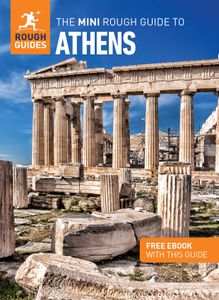
Find even more inspiration here

Planning your own trip? Prepare for your trip
Use Rough Guides' trusted partners for great rates
written by Rough Guides Editors
updated 19.05.2021
Ready to travel and discover Greece?
Get support from our local experts for stress-free planning & worry-free travels.
- Where to stay
- Travel advice
Advertiser Disclosure
Many of the credit card offers that appear on this site are from credit card companies from which we receive financial compensation. This compensation may impact how and where products appear on this site (including, for example, the order in which they appear). However, the credit card information that we publish has been written and evaluated by experts who know these products inside out. We only recommend products we either use ourselves or endorse. This site does not include all credit card companies or all available credit card offers that are on the market. See our advertising policy here where we list advertisers that we work with, and how we make money. You can also review our credit card rating methodology .
The 24 Best Beaches in Greece in 2023 [East, West, Islands]
Amar Hussain
Senior Content Contributor
771 Published Articles
Countries Visited: 63 U.S. States Visited: 9
Senior Editor & Content Contributor
88 Published Articles 652 Edited Articles
Countries Visited: 41 U.S. States Visited: 28
Keri Stooksbury
Editor-in-Chief
32 Published Articles 3106 Edited Articles
Countries Visited: 45 U.S. States Visited: 28
![west coast of greece travel The 24 Best Beaches in Greece in 2023 [East, West, Islands]](https://upgradedpoints.com/wp-content/uploads/2022/11/Best-Beaches-in-Greece.jpg?auto=webp&disable=upscale&width=1200)
Map of the 24 Best Beaches in Greece
1. agios gordios beach, corfu, 2. agios ioannis beach, lefkada, 3. antisamos beach, kefalonia, 4. chomi beach, corfu, 5. myrtos beach, kefalonia, 6. shipwreck cove (navagio beach), zakynthos, 7. paleokastritsa, corfu, 8. paralia dafni, zakynthos, 9. porto katsiki, lefkada, 10. vrika beach, antipaxos, 1. ammólophoi, nea peramos, 2. ancient lindos, rhodes, 3. baxedes beach, santorini, 4. golden beach, thassos, 5. kalafati, mykonos, 6. kallithea beach, kallithea, 7. lemonakia beach, samos, 8. nea chora beach, crete, 9. panormos beach, mykonos, 10. paralia almirou, magnesia, 11. plaka beach, naxos, 12. super paradise beach, mykonos, 13. toroni beach, toroni, 14. tsigrado beach, milos, final thoughts.
We may be compensated when you click on product links, such as credit cards, from one or more of our advertising partners. Terms apply to the offers below. See our Advertising Policy for more about our partners, how we make money, and our rating methodology. Opinions and recommendations are ours alone.
Greece is known for many things. Its history and culture have kept the country at the top of many people’s must-see lists.
However, Greece isn’t all about ancient ruins and art. Greece has miles of coastline between the mainland and its islands, and the locals take their time by the water very seriously. The result is numerous pristine beaches for you to have a perfect getaway. To help you choose, we’ve looked at all the options to narrow down Greece’s best beaches.
The 10 Best Beaches in West Greece
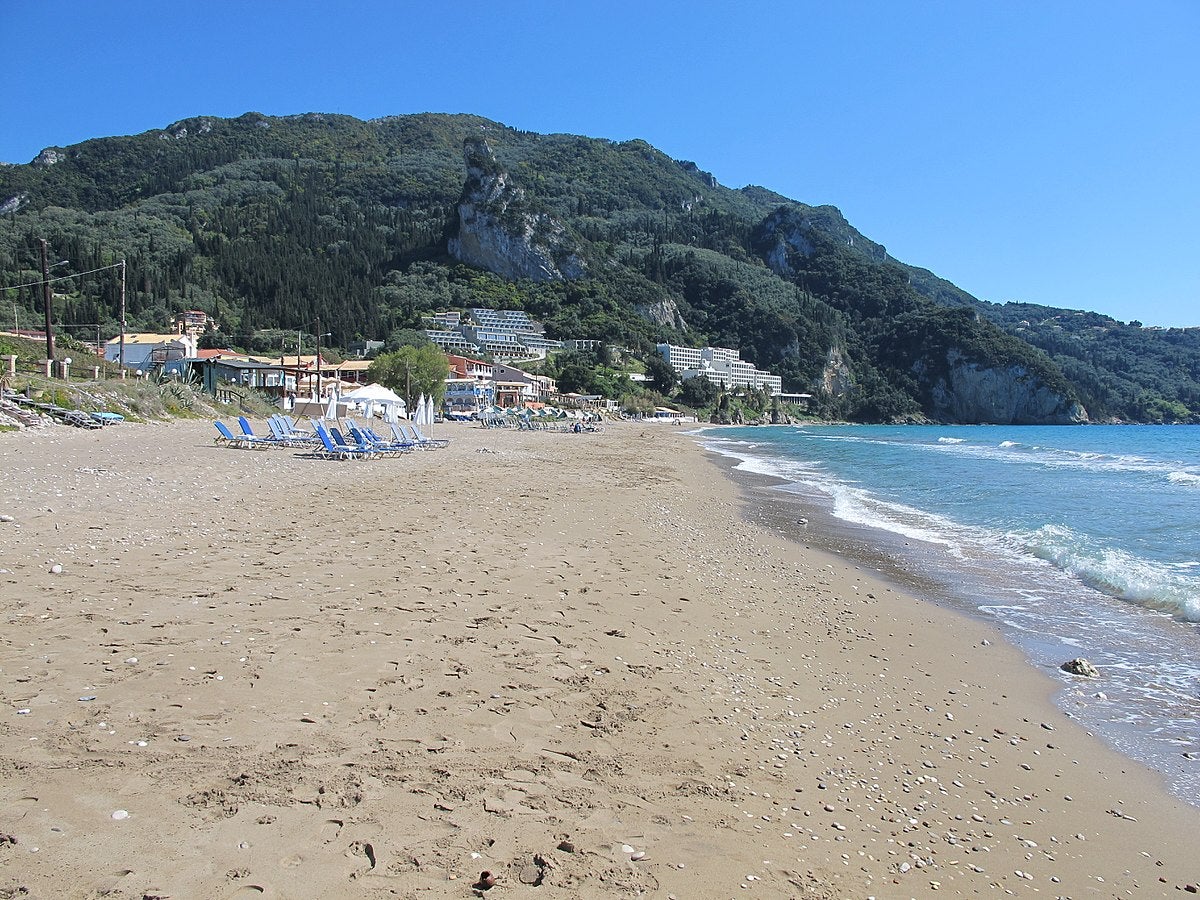
Agios Gordios Beach is a hidden gem that has somehow managed to fly under the radar for most tourists. The beach is both soft sand and pebbly, with each end of this stretch of the coast showing a different landscape. You can stick to the side you prefer, or you can experience both with just a relaxing, luxurious walk.
The sandy end draws more tourists. It’s also where you’ll find more beach establishments and places where you can rent beach chairs and sunbeds. However, even on the pebbly side of the beach, you won’t be far from anything you might need.
The water is generally quite clear as the island’s shipyards aren’t particularly close to this part of the beach. The water is also shallow, but, as usual, be careful as it can get deep a bit more rapidly if currents have shifted the sand quite a bit.
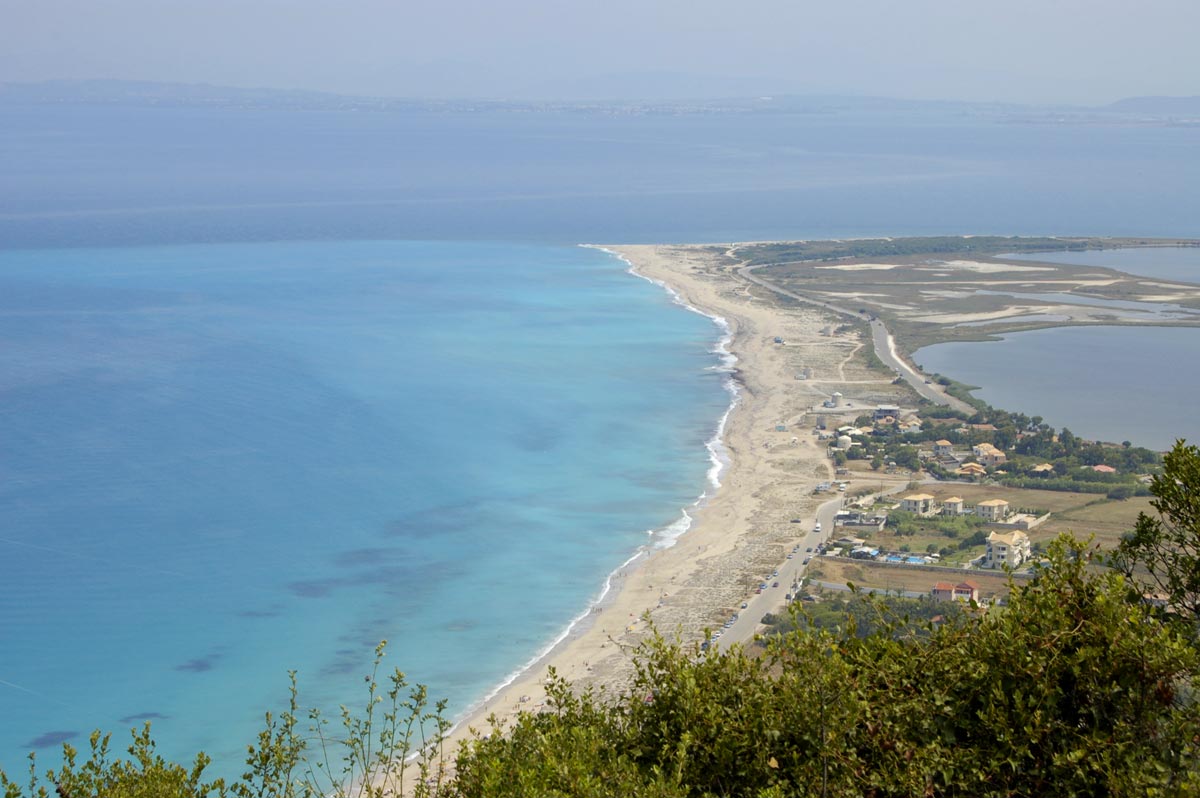
Agios Ioannis Beach is yet another beach that’s a mix of sand and pebbles that give the coast a very natural and wild feel. With the beach lined with thick, green trees, it’s the perfect place if you want to feel like you’ve found yourself in an island paradise .
The beach’s water usually doesn’t have a very strong current and isn’t dangerously deep while close to the shore. However, despite that, you can still go surfing or kite surfing since you can typically count on there being waves just a short distance into the water.
The beach has a very secluded feel, but you’re not in the middle of nowhere. There are still a few cafes and eateries you can go to if you need if you decide not to pack a picnic lunch to bring with you on your beach day.
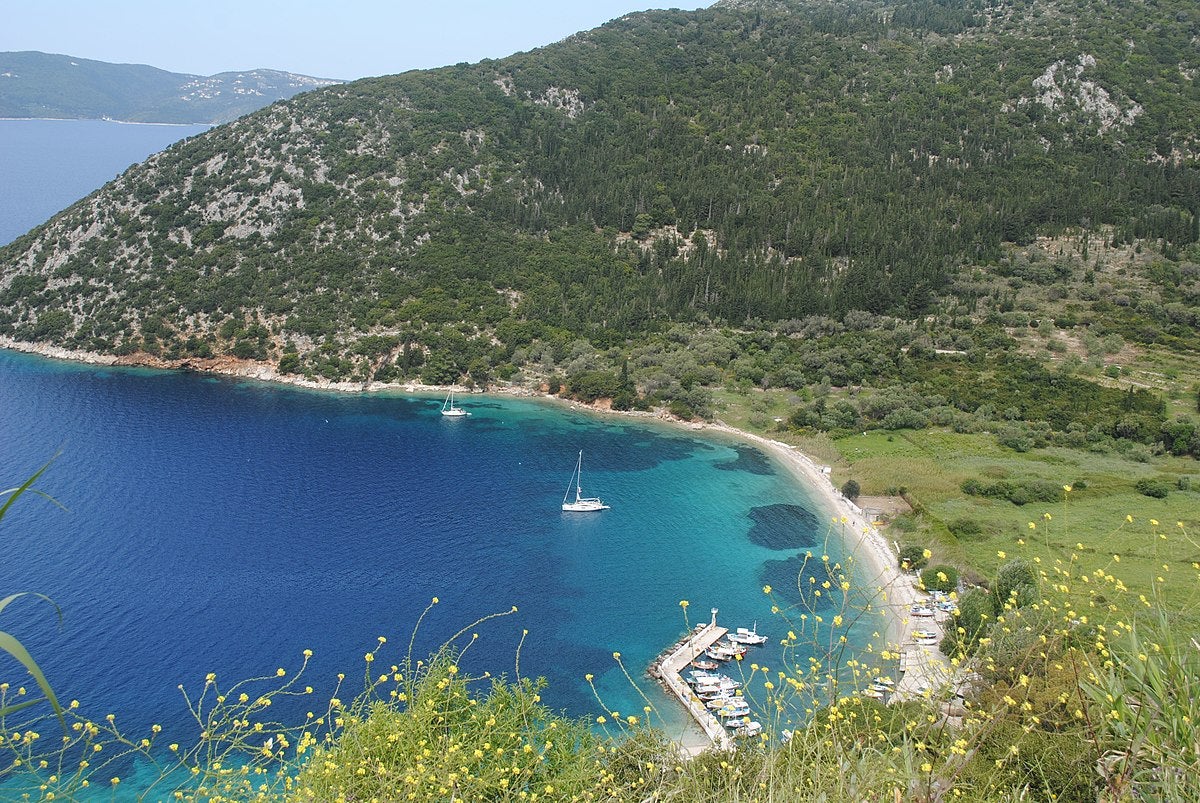
Antisamos Beach is one of the most popular beaches in Kefalonia , and it’s not hard to see why. The beach is gorgeous and pristine, despite its crowds on busy days.
You can wander on the sand and splash in the water for hours. The sand is comfortable and soft, so you can take long walks or sunbathe without worrying about getting uncomfortable. However, there are a few things the beach has to offer that you might want to do some extra planning to enjoy.
You can book beach tours that let you see the rocks and caves in the most remote areas of the beach. These areas would be incredibly difficult to get to without having a professional guide to help you. Once you’re done with the tour, you’ll be all set to take a dip in the inviting water.
Chomi Beach has affectionately earned the nickname “Paradise Beach” among locals and tourists alike. With a moniker like that, expectations are very high, and for a good reason. The beach is lined with dramatic and picturesque cliffs that create scenic views that you expect out of a movie or a postcard.
The beach is secluded and perfect if you want to escape city life’s hustle and bustle. In fact, you can’t even access the beach on foot. You have to charter or rent a boat in order to get to the beach’s shores. As such, it usually doesn’t get that crowded or loud.
It has some of the softest sand you’ll find on any of Greece’s islands. The water is crystal clear and bright blue. Even though boats come to and from the shore at various intervals, the water remains clear of pollutants.
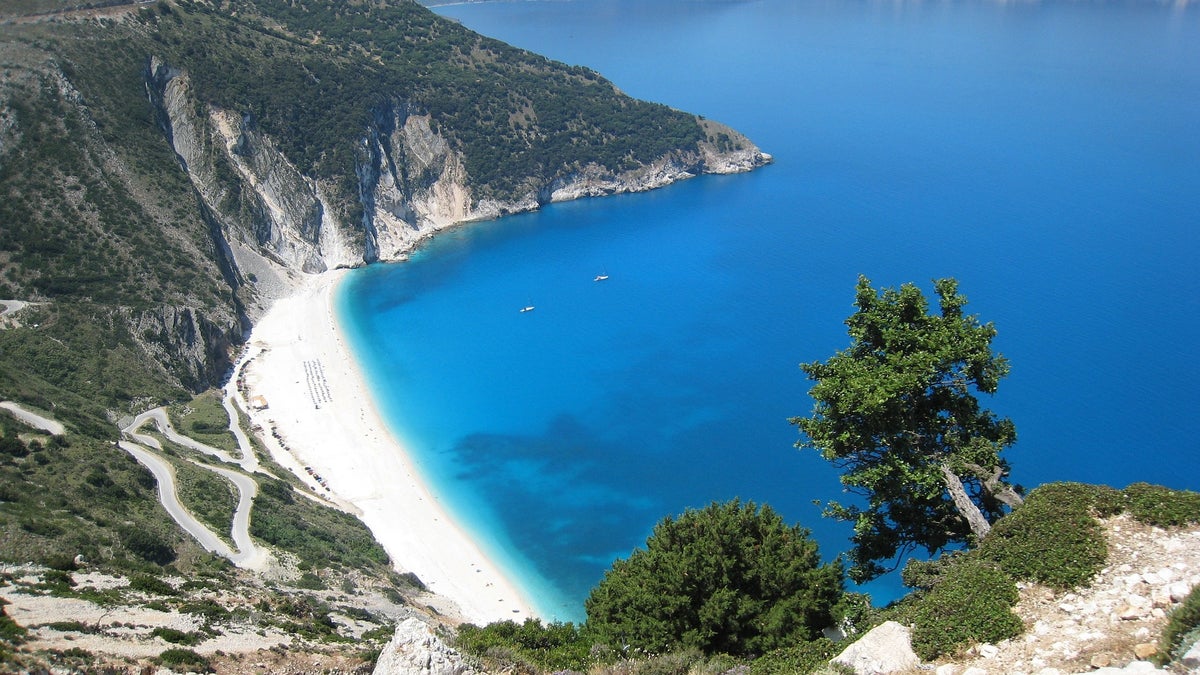
Myrtos Beach is the perfect place for hiking lovers to go for a little time by the coast. That’s because you can enjoy this stunning stretch of the Greek coast from 2 different levels. If you can’t stand being more than a few steps away from the water, you can spend your day on the sand, where you can take a dip whenever you want.
However, if you want a truly remarkable view, you can hike the cliffs that line the shore. The cliff sides let you overlook the coast so you can see how truly gorgeous Myrtos is with its bright blue water.
This view has earned the beach the title of one of the most dramatic beaches in the country. The beach is lined with white pebbles that look like sand from far away, though they glimmer in the sun.
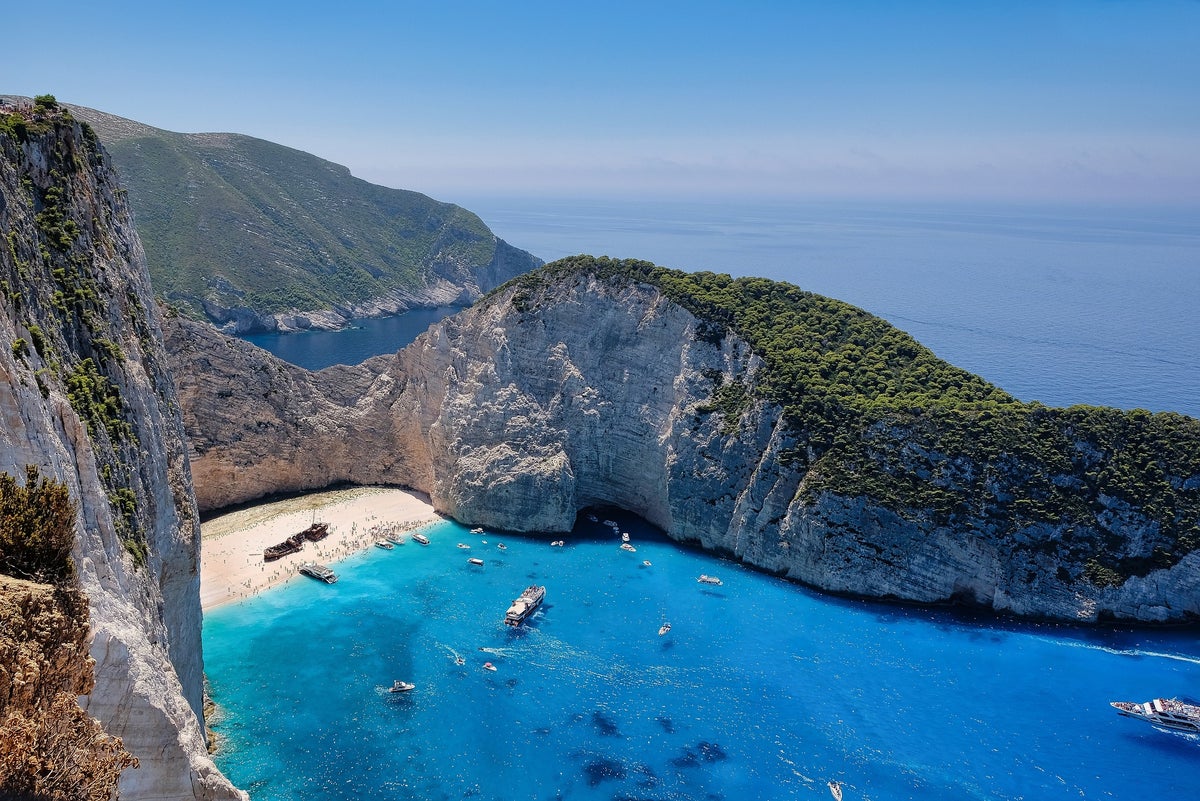
Navagio Beach is perfect for people who have always dreamed of finding a treasure island. The beach is curved and has an exposed cove which has given rise to stories of pirate smugglers. You don’t have to worry, however. If you explore the beach, the only things you’ll find are shells and scenic views you’ll definitely want to make sure you catch on camera.
Once again, this is a great beach if you want seclusion. Unfortunately, you can’t access the shore on foot, and you need to take a boat to get there. The cove is also great for adventurers, as you need to do a bit of swimming to get to its entrance.
Hot Tip: Make sure you pack a meal if you plan to eat on the sand as there aren’t any restaurants around for you to go to.
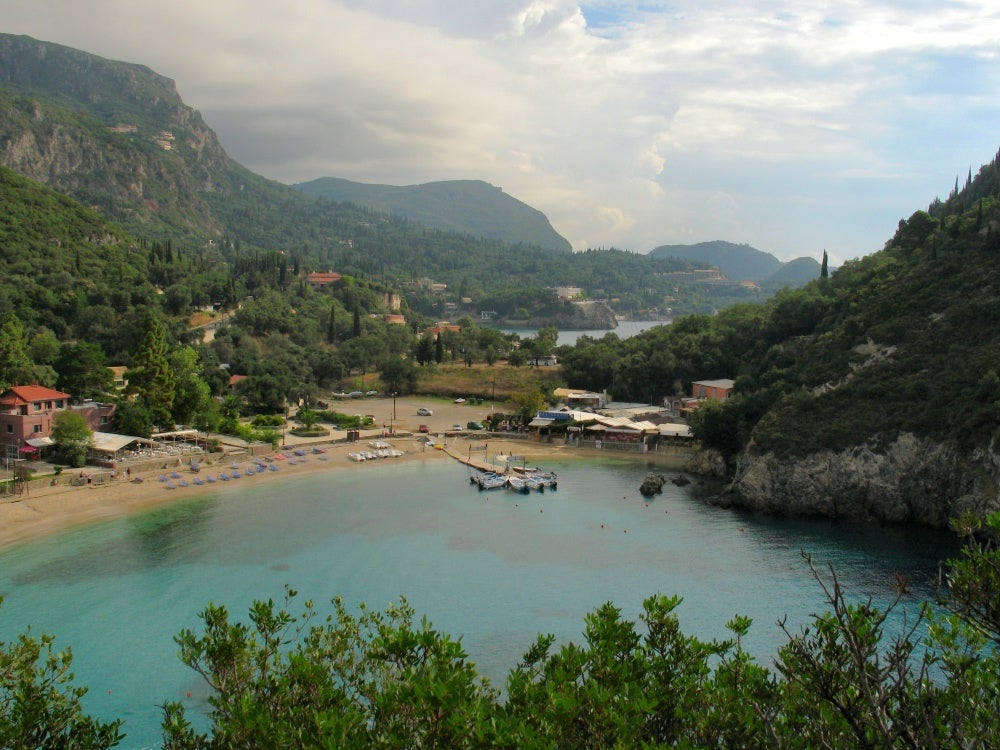
If you’re an adventure-seeker at heart, but you still want to make sure you relax while you’re on your beach getaway, head to Paleokastritsa. The beach is surrounded by lush, gorgeous wilderness and dramatic cliffs that keep the beach protected from winds that might alter its landscape.
People have noted its beauty for years. In fact, it’s said to be the location of many Greek epic myths and tales. While you’re on the sand, you’ll expect to see a Greek god or mythological creature come around the corner.
Even from the sand, you’ll be struck by the water’s color. Near the beach, the water is lighter in color, almost sky blue. However, along the steep cliffs, the water is often a darker blue. Though this is one of the most well-known beaches in Corfu , don’t miss your chance to see it for yourself.
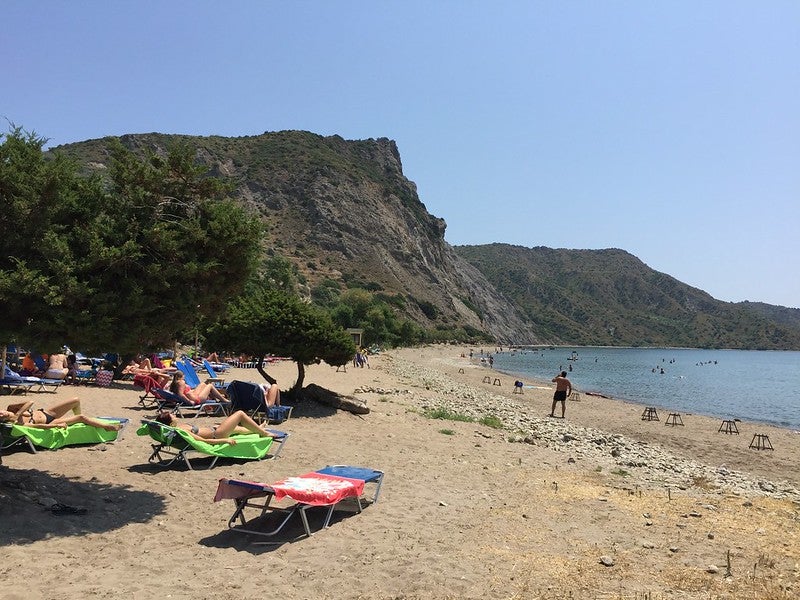
Paralia Dafni offers visitors miles of gorgeous white sand to enjoy all year round. The beach can get quite warm during the summer months, but you don’t have to worry about that since there are trees lining the entire length of the shore that can give you shade.
You also don’t have to worry about walking on scalding sand to get to the water. The beach is long but narrow, so you can get to the water in just a few steps. The water itself is warm enough to swim in for hours, but you can also get some relief from the steamy humidity that can plague the country during the late summer.
Even on busy days, there aren’t too many crowds, so you have plenty of space to stretch out and peacefully relax without being on top of other beach-goers.
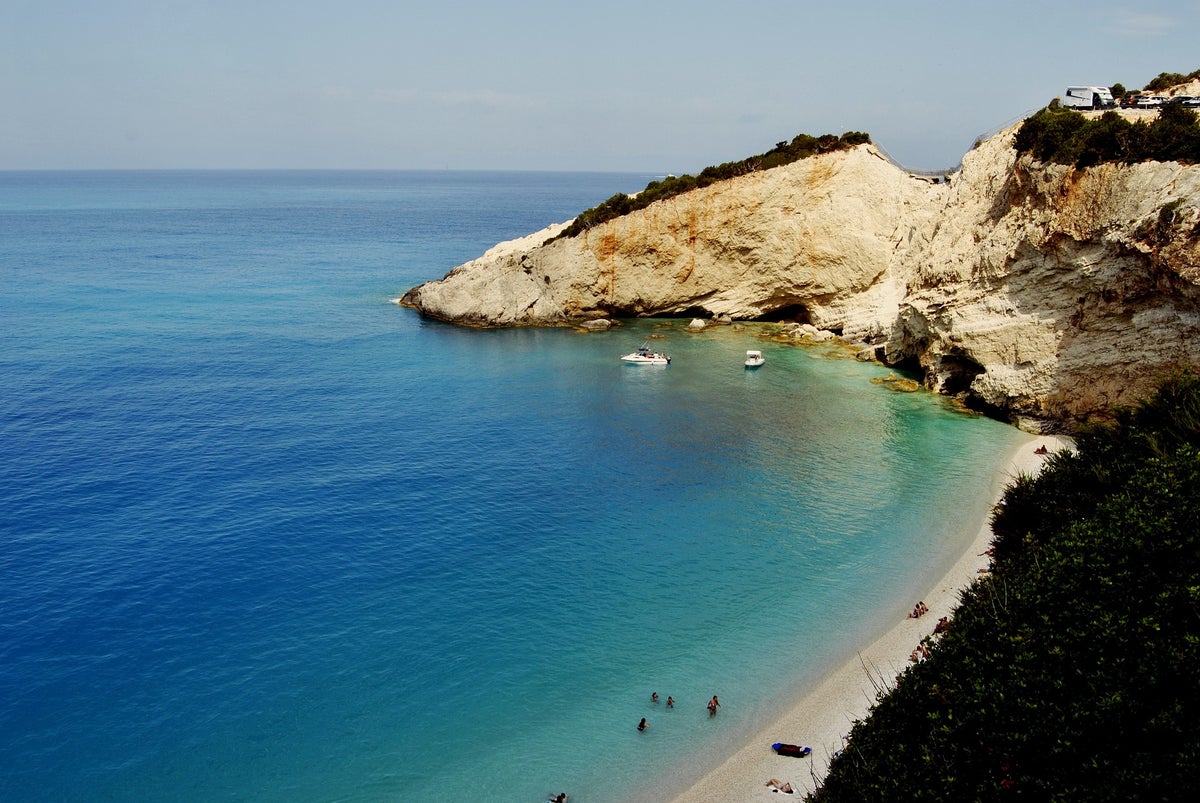
For many years, Porto Katsiki was nearly impossible to reach. Locals said only goats were able to make it down to the water, and even boats rarely made it to the shores. While those days are over, the beach is still one of the best for people who are looking for a little peace away from civilization.
The beach is known for its extremely blue water that will mesmerize you and just beg for you to go for a swim. The landscape that frames the beach is also one of the most dramatic. The cliffs are pale and covered in thick greenery, and the sand is even and soft.
The beach still takes some planning to get to. The easiest way to get to the shore is by boat. Boats run more regularly during the summer. However, you should still find one during the off periods as well.
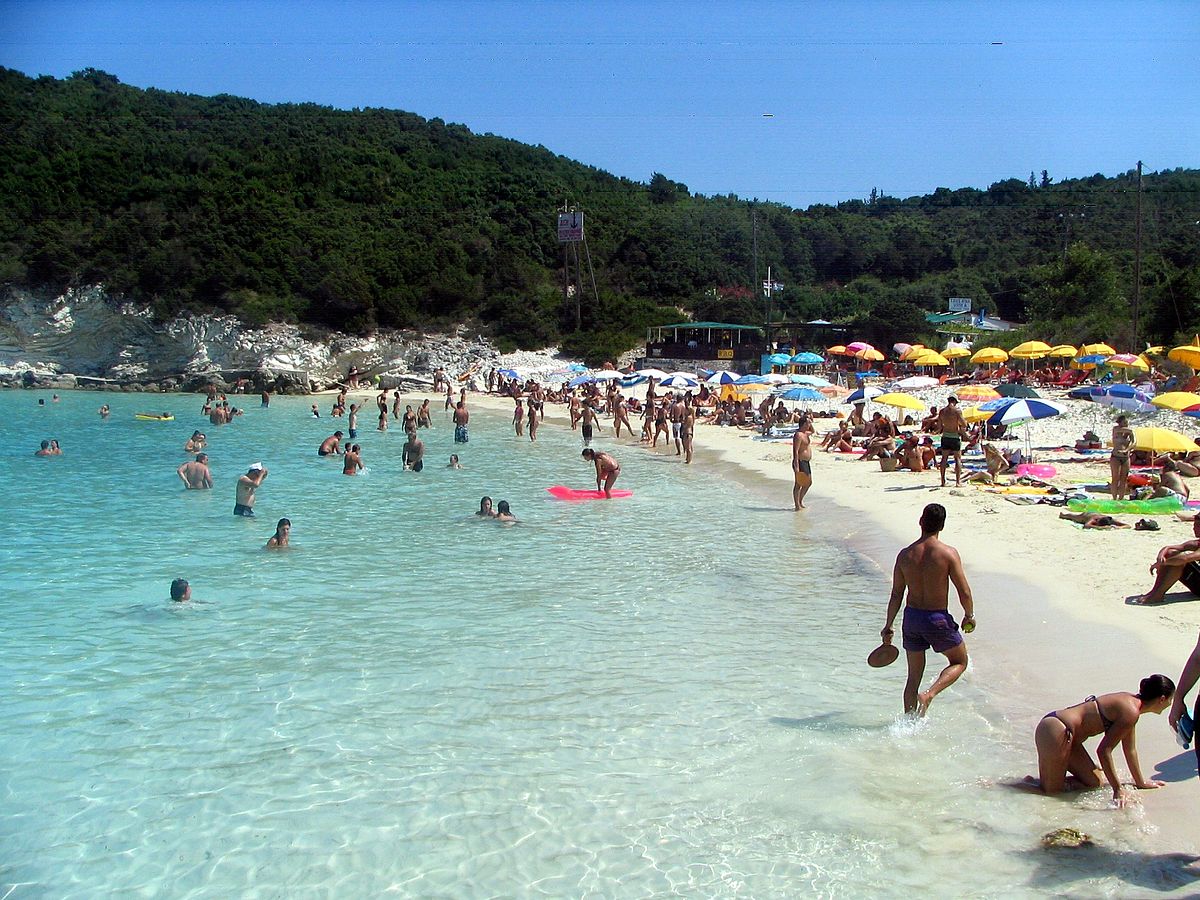
If you’re looking for a family-friendly beach for a nice, calm beach vacation, Vrika Beach is the place for you. The water is gentle and typically doesn’t have very strong waves close to the shore. It also doesn’t get deep very suddenly, so small or inexperienced swimmers don’t have to worry about getting out of their depth.
The beach is also covered in soft sand that is comfortable to walk and sunbathe on or build some sand castles if that’s what you prefer. If you’re looking for a beach that’s full of excitement, this might not be your top choice. It’s not too secluded, but you won’t encounter many parties or events on the sand unless you visit during the busiest seasons.
You will, however, be sharing the beach with a few other beach-goers. You can even rent an umbrella or sunbed if you want.
The 14 Best Beaches in East Greece
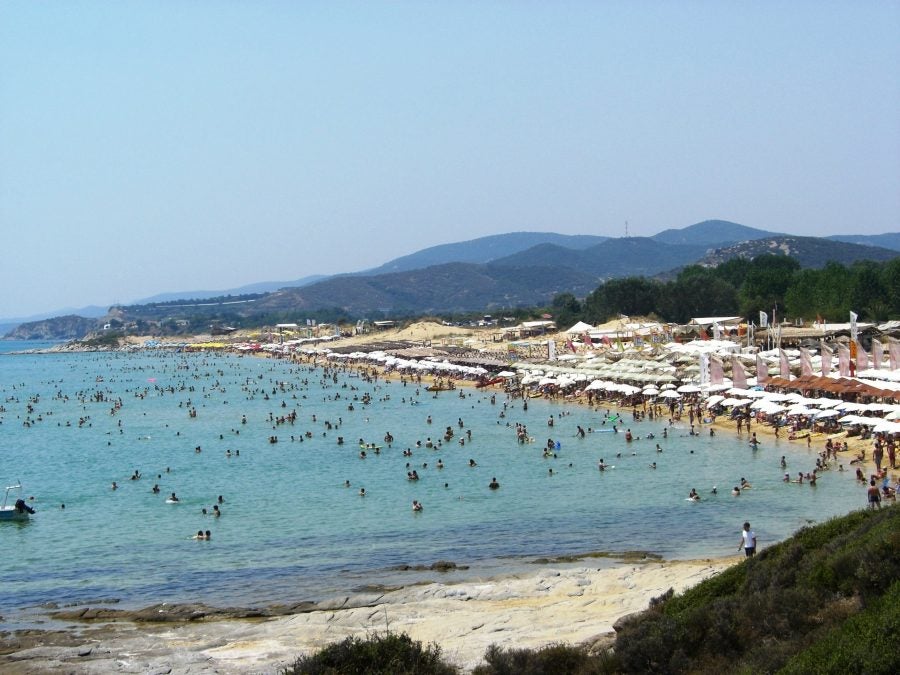
If your main goal when you go on your beach vacation is to relax and not have to worry about planning too much, Ammólophoi is an ideal option for you. The beach is near multiple snack bars and other eateries, so you don’t have to worry about figuring out what or where to eat while you’re on vacation.
There are also many sunbeds and umbrellas you can rent, so you don’t have to worry about bringing anything other than a towel. You can be in the shade and get comfortable without lugging around a ton of equipment. If you’d rather lay directly on the sand, it’s extremely soft and makes an excellent natural cushion for your lounging.
The water is also crystal clear, warm, and refreshing for you to go for a swim during the warmer months of the year.
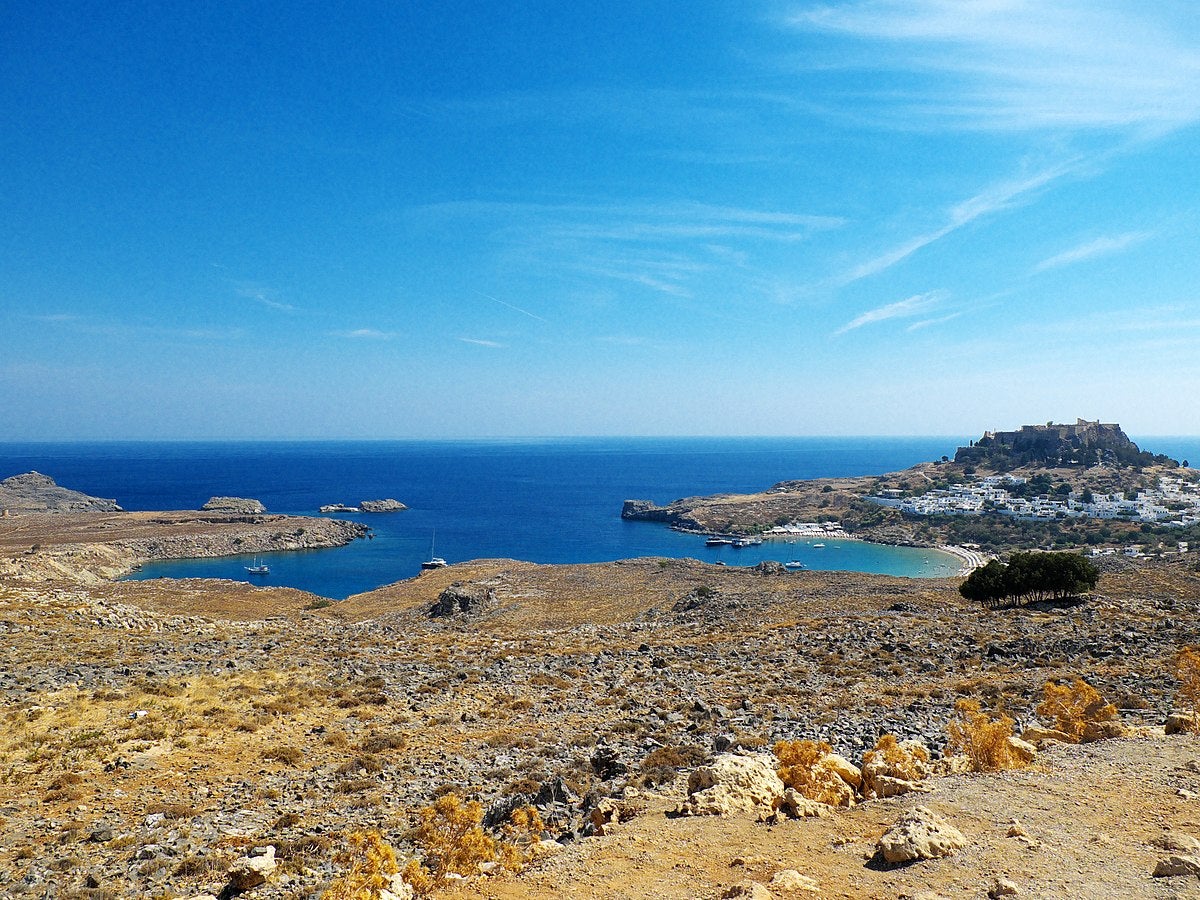
Ancient Lindos may not seem like the first place to go for a beach day, but it should still be on your must-visit list. Very few other places in the world will mix paradise with ancient history the way Ancient Lindos does. You will truly be able to feel the stories and history emanating from the ruins as you lounge on the sand.
The water is clear blue and has a very gentle current , so it’s the perfect place to bring your young children to give them a dose of culture while on vacation.
The ruins are a bit of a trek from the beach, but if you pack some comfortable shoes, you should make the hike without any trouble. It’s also well worth the effort, as the views will truly leave you breathless. However, since the ruins are delicate, check that they’re open before your visit.
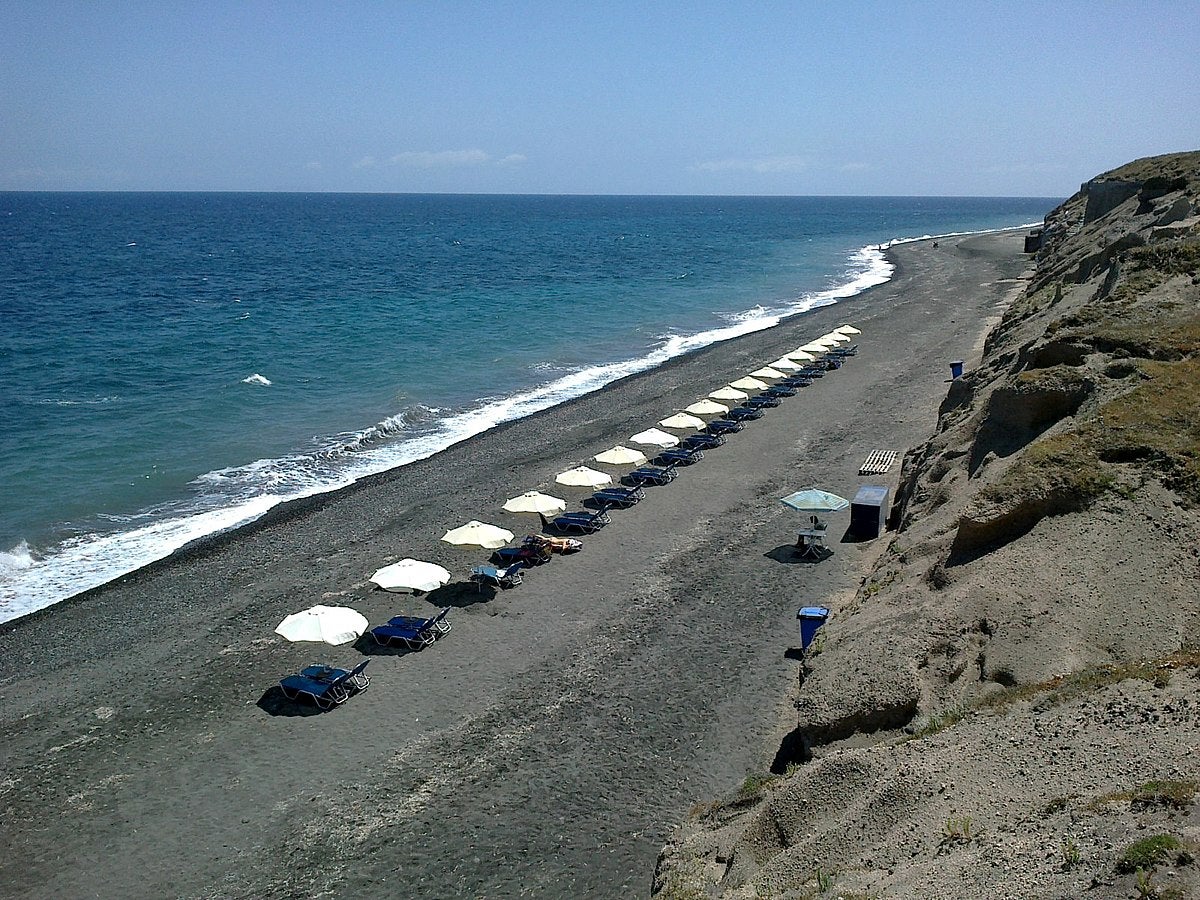
If you want to relax and unwind on your vacation, there’s no better place to do so than on Baxedes Beach in Oia. Oia is a gorgeous village, so it’s no wonder its beach is also worth visiting.
Since you have to either take a boat or hike to get down to the sand, the shore doesn’t typically get too overcrowded. That’s true even when the island is full of tourists during the spring and summer seasons.
The sand is dark and comfortable to walk on despite the interspersed pebbles you’ll also find along the shore. The water is also shallow and perfect for wading. Even on the rockier stretches of the beach, the water helps make the terrain comfortable.
You can lay out on the sand, but if you’d prefer a little extra comfort, there are also usually umbrellas and sunbeds for rent.
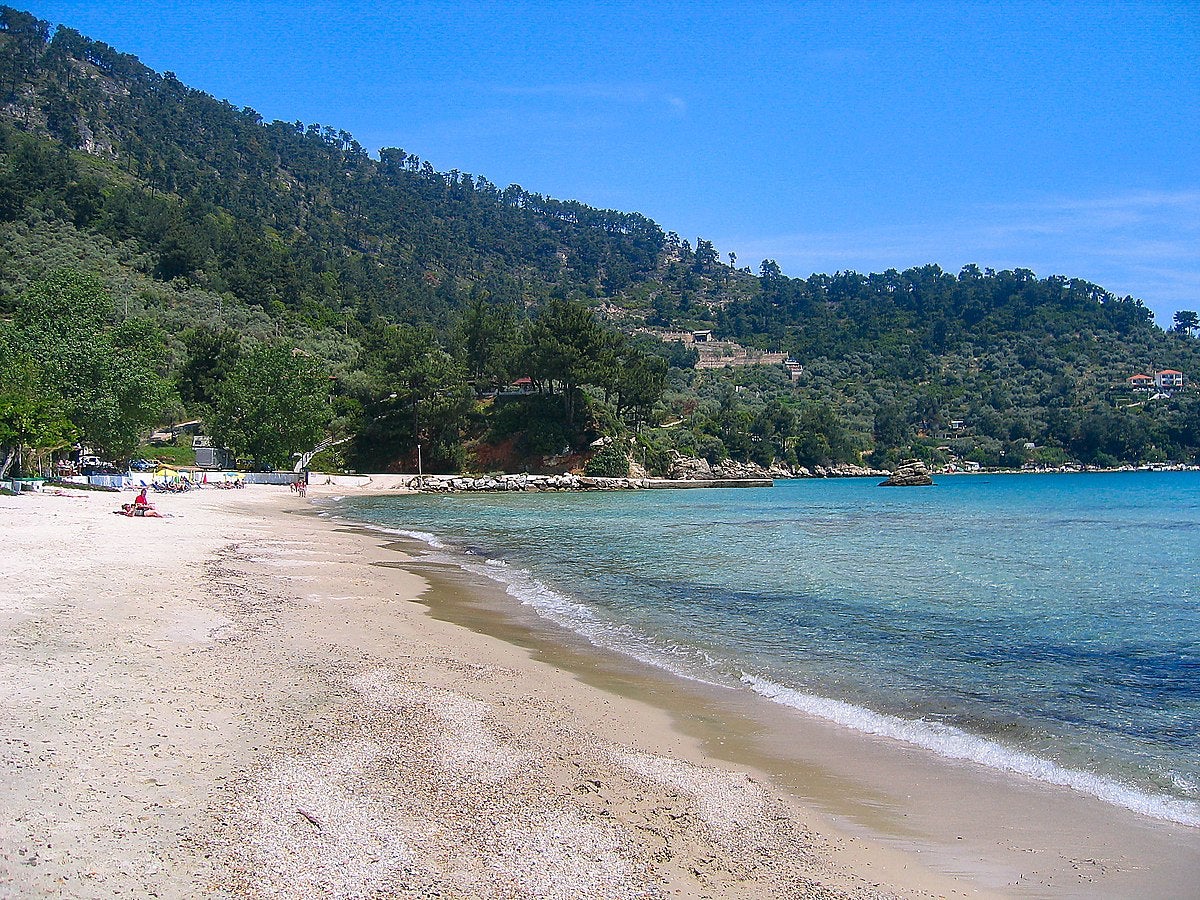
Golden Beach is a versatile stretch of the Greek coast that’s perfect for different people depending on the day.
On calm days when the water is limpid, it’s a great place to go with kids. On those days, the current is gentle, and the water is very shallow, close to the shore. It’s so safe and calm, it’s even a great place to teach your youngest travelers how to swim.
However, on windy days, the beach is susceptible to more waves. On those days, you might not want to head to the water with children, but if you’re a surfer, you’ll fall in love. The waves might not be consistent, but when you can find them, they’re some of the best on this side of the country. Of course, you can’t forget the soft golden sand that gives the beach its name.
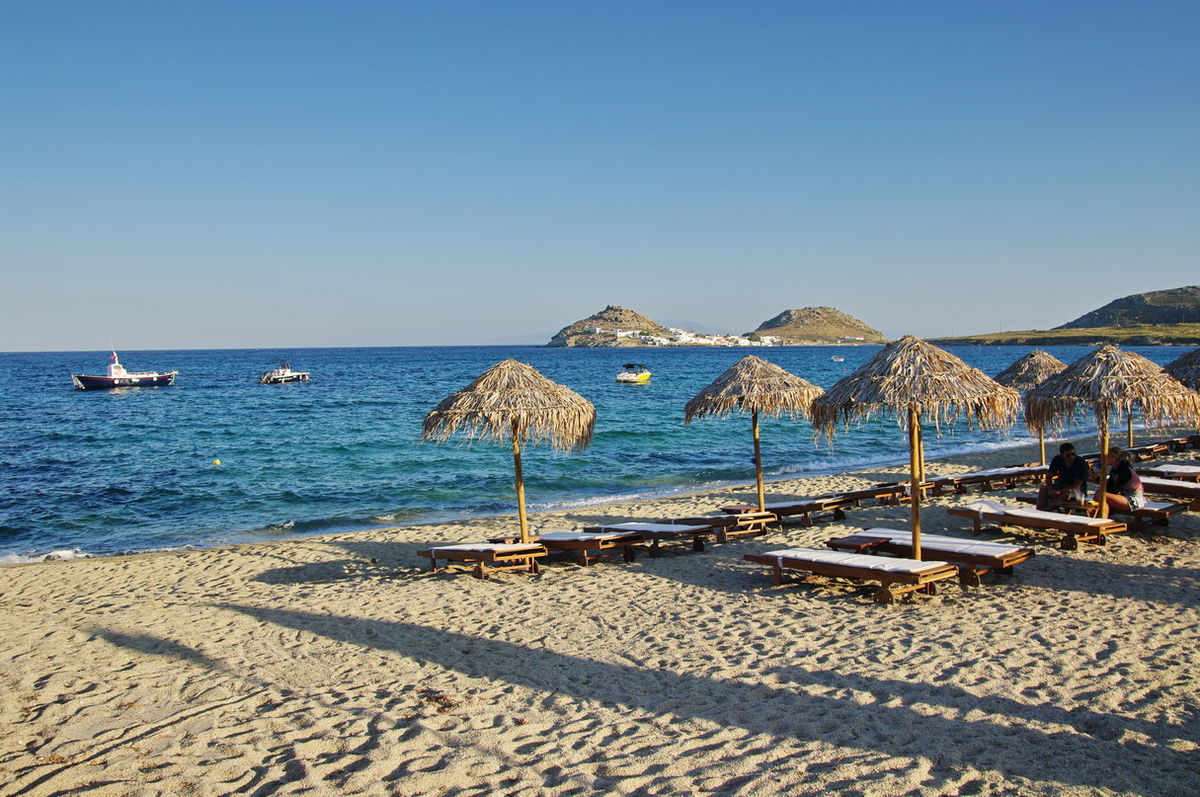
Mykonos has gained a reputation as being one of the biggest party locations in Europe . However, if that’s not what you’re looking for from your vacation, you’re in luck. Kalafati is a calm and relaxing beach area that’s not in the center of the chaos you might find elsewhere on the island.
You’ll still be able to find plenty of bars and restaurants where you can spend your days and evenings, but you can also lay out on the beach and relax in peace and quiet.
On top of the peace, the water is extremely clear and blue — perfect for wading or swimming . You’ll also love the white sand beaches. The white sand is notoriously soft, and Kalafati is no different. If you’re looking for a pristine beach that doesn’t see too many crowds, this is an option you should definitely consider.
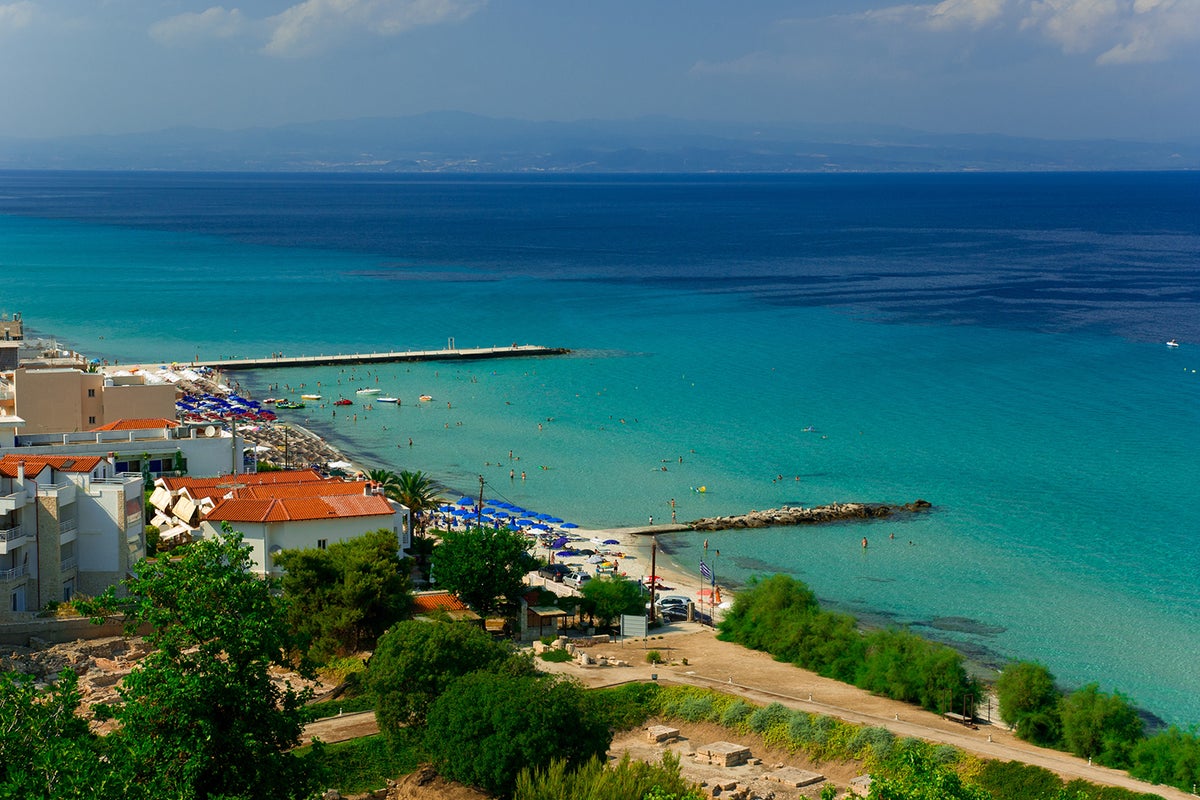
Kallithea Beach is perfect if you’re wary about open water, but you’ve always wanted to have a true beach vacation. Unlike many beaches in Greece, this stretch of the coast is completely sandy , so it’s comfortable to walk on, and you don’t have to worry about slipping on a wet pebble.
If you’re feeling up to going into the water, you’ll be pleasantly surprised by that as well. The water is generally nice and warm, especially during the spring and summer. It also starts shallow and gradually deepens.
You don’t have to worry about suddenly not being able to touch the seafloor. Since the water is clear, you can also see below the surface easily, which can greatly reduce anxiety for new beach-goers.
Bottom Line: It’s a calm, relaxed environment for you to spend some time by the coast and find peace. You’ll find yourself rapidly unwinding.
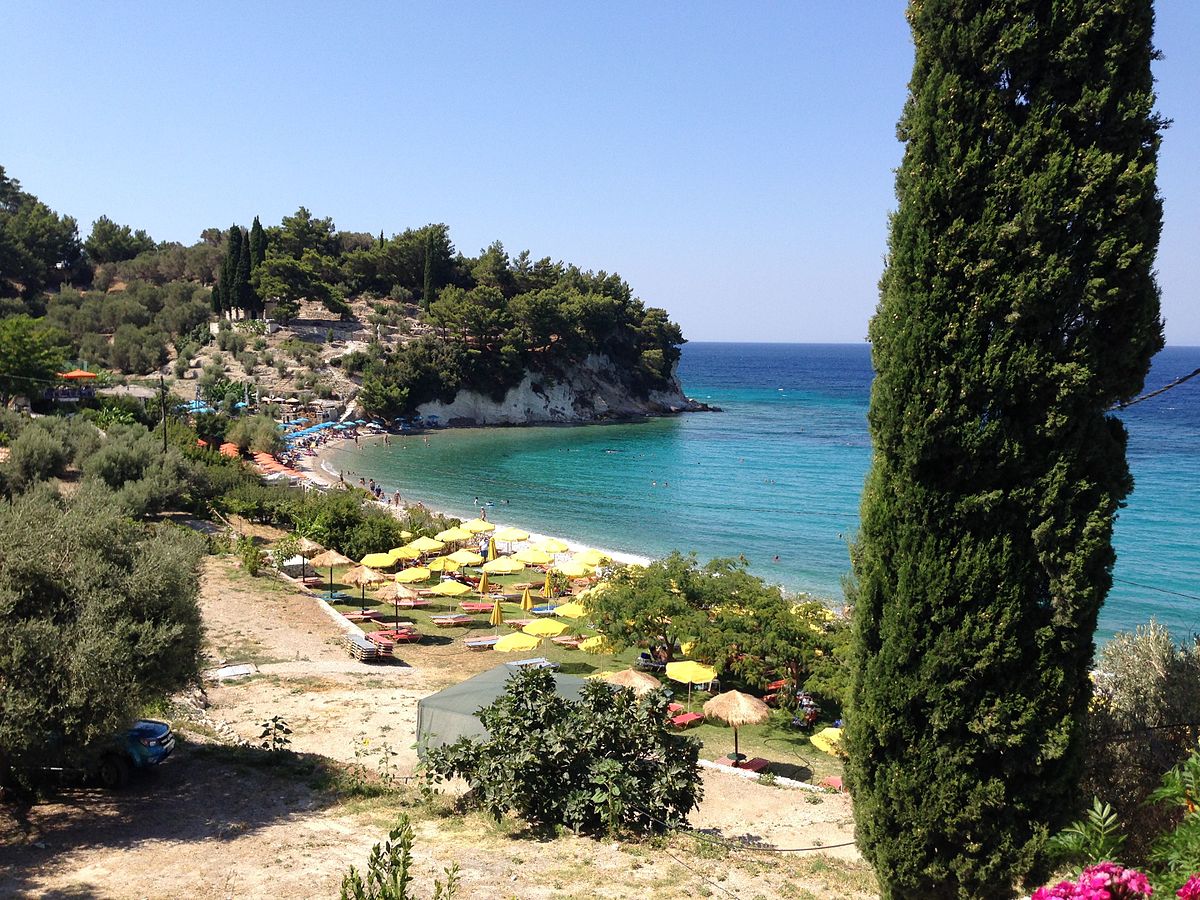
Lemonakia is one of the smaller beaches in Kokkari, but it’s still worth visiting. The sand is surrounded by greenery that not only offers shady protection from the sun but also keeps the beach from looking too over-commercialized.
The beach is the focal point of a small village that has a few places to eat and shop, but also isn’t too far from other, larger cities with more amenities you might need. The beach is a mix of sand and pebbles. If the latter makes you nervous, don’t be. There aren’t many pebbles, so you shouldn’t have to worry about them causing discomfort while you walk or lounge around.
The clear water makes any discomfort you might encounter worth it. It’s almost like glass, and you can easily see below the surface without worrying about any pollutants. It’s also nice and warm.
The Old Venetian Port of Chania is a surprisingly underrated village on the coast. However, you have to visit, especially if you can manage to make it before the tourism industry catches wind of this gem. No matter what time of day or what season you visit, you’ll be struck by how beautiful the town is. However, the best time of year to visit is during the summer if you plan to go in the water.
To the west of the town is Nea Chora Beach, with excellent ocean views on a long stretch of sand . The water is clean and shallow, so perfect for little swimmers. The beach is lined with bars and restaurants so you can stay on the beach all day with ease.
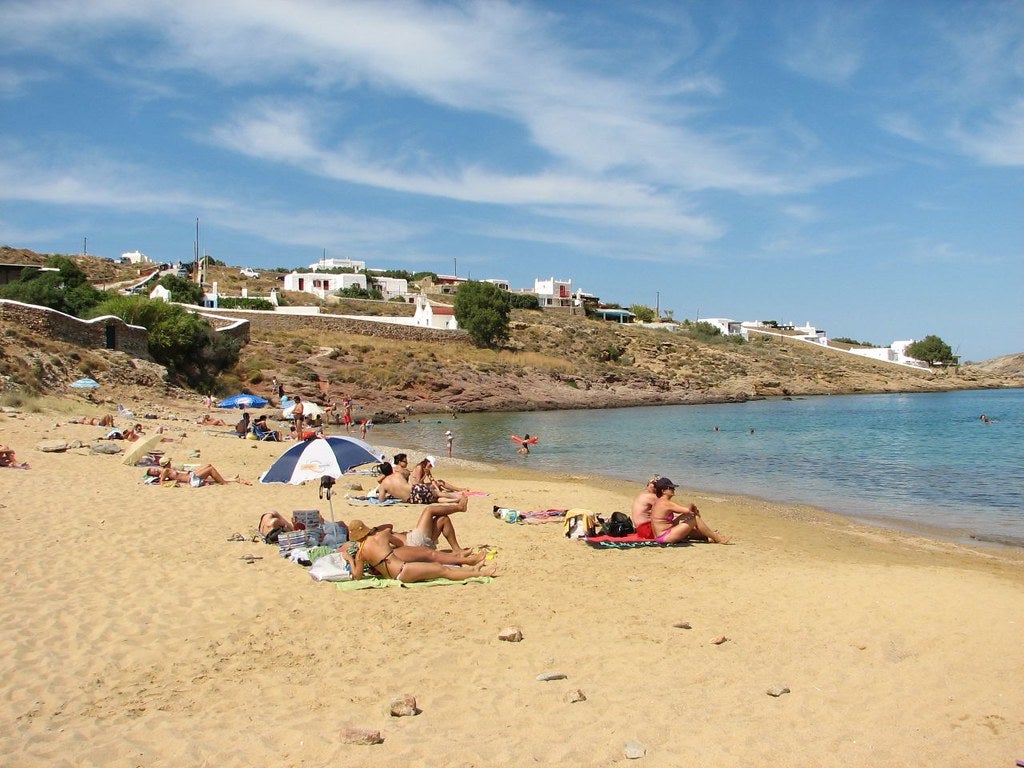
Panormos Beach is a secluded beach that is great for a break from the excitement the rest of the island has in store. The beach is curved, creating a protective inlet that keeps away the strongest currents and waves from reaching the water closest to the shore.
The inlet also keeps out most of the wind from the sea. However, it can still be quite breezy. The beach seems to stretch out for miles, so if you’re looking for a nice place to take a luxurious walk on the beach, this is a great spot for that.
A few bars and restaurants lead right to the sand, so if you’re nearby, you’ll likely be treated to their music or entertainment. Other than that, however, you’ll be able to easily find some peace where you can just listen to the waves if you want.
Paralia Almirou is a great beach destination if you want the calm and quiet of some seclusion but don’t want to be in the middle of nowhere.
The beach gets its name from the tiny village that borders it. The town gets a few tourists every year, particularly during the spring and summer, but it’s fairly quiet and calm as most people prefer the bigger cities.
As such, you’ll mostly be sharing the sand with locals and won’t have to deal with too many crowds. Don’t overlook the beach, however. It has soft sand that’s pristine and well-maintained naturally, and the water is clear blue, warm, and perfect for swimmers of all ages.
Since there aren’t many visitors on the shore at once, you also don’t have to worry about the water becoming murky with sand being kicked up by other swimmers.
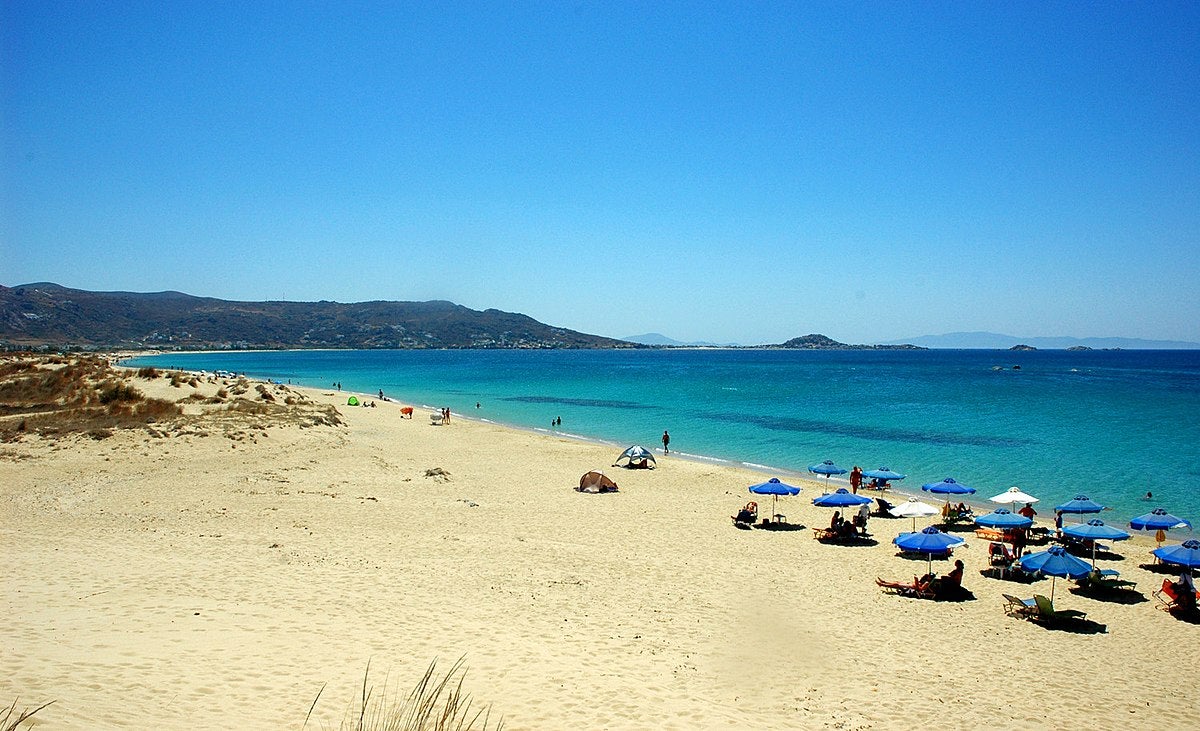
Plaka Beach is 2.5 miles of paradise on Greece’s coastline. Unfortunately, it’s gained some popularity over the years, so it’s no longer a secret spot that only a select few tourists know about. However, it’s still worth visiting, even on busy days.
You’ll still likely be able to find enough room to set up a towel or a small beach chair for you and your travel party. In a worst-case scenario, if you feel a little too overcrowded, you can always go for a nice, long walk.
There’s plenty of scenery to admire, from the hilly sand dunes to the crystal blue water and even the soft, golden sand . You’ll have plenty of picture-perfect moments. The hills protect the beach from most of the area’s wind, but be prepared to deal with a few gusts on particularly windy days.
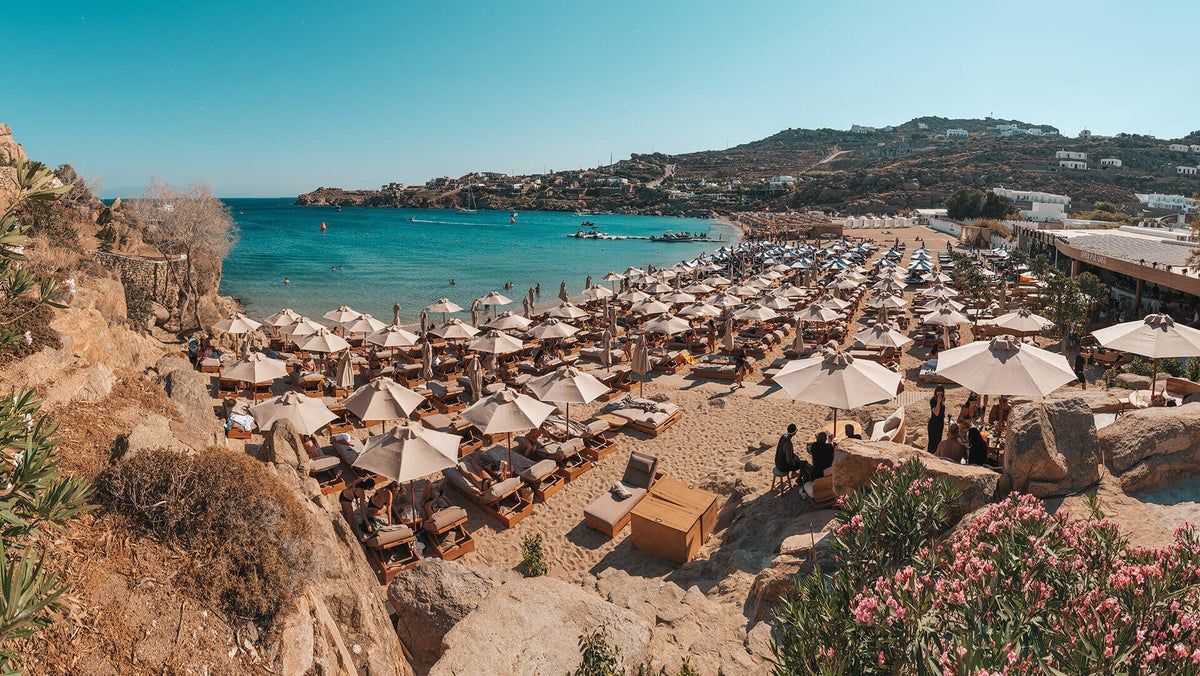
Super Paradise Beach is where all the action is in Mykonos. This section of the island’s beach isn’t public and is, instead, part of a beach club where you can have fun all day and into the night.
If you want to spend time on the sand, you can absolutely do that. Just head out to the beach and lay out for a few hours. However, you’ll likely want to make sure you stick around the main area. There might be crowds, but for a good reason.
There’s plenty of music to dance to, so you can have the beach party vacation of your dreams . You can also head out to the water to participate in some water recreation, from surfing to water skiing. Or you can just people-watch or simply go for a swim if you’re not comfortable being an adrenaline junkie yourself.
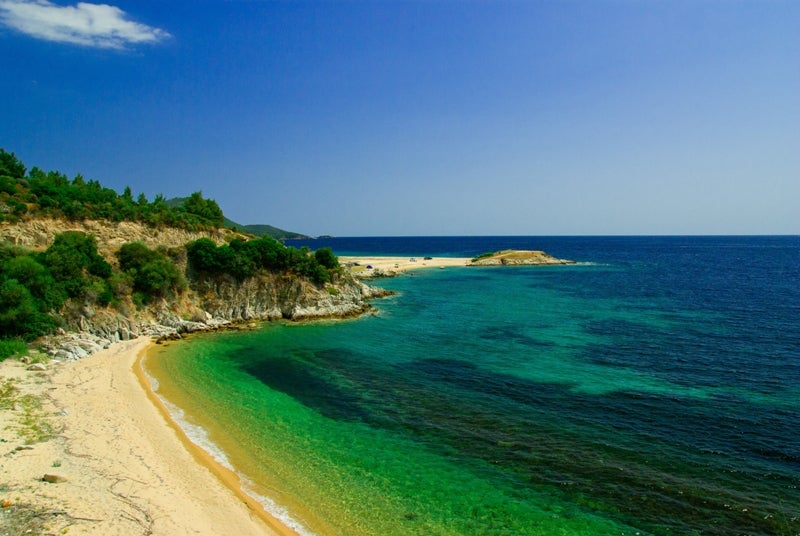
Toroni Beach is a great option if you don’t want to have to choose between a stretch of the coast where you’ll have luxuries and one where you’re in charge. There are places on this beach where you can rent an umbrella or a beach chair and have someone come by to make sure you have everything you need.
However, if you’re a more spontaneous person, or you don’t see yourself sitting still for too long, you can opt for the public areas as well. No matter which option you choose, this beach is great for families and travelers of all ages.
You can find spots where it’s peaceful and quiet so you can unwind and listen to the waves or read a book. You can also find areas full of people where there’s more bustling around and entertainment if you prefer that.
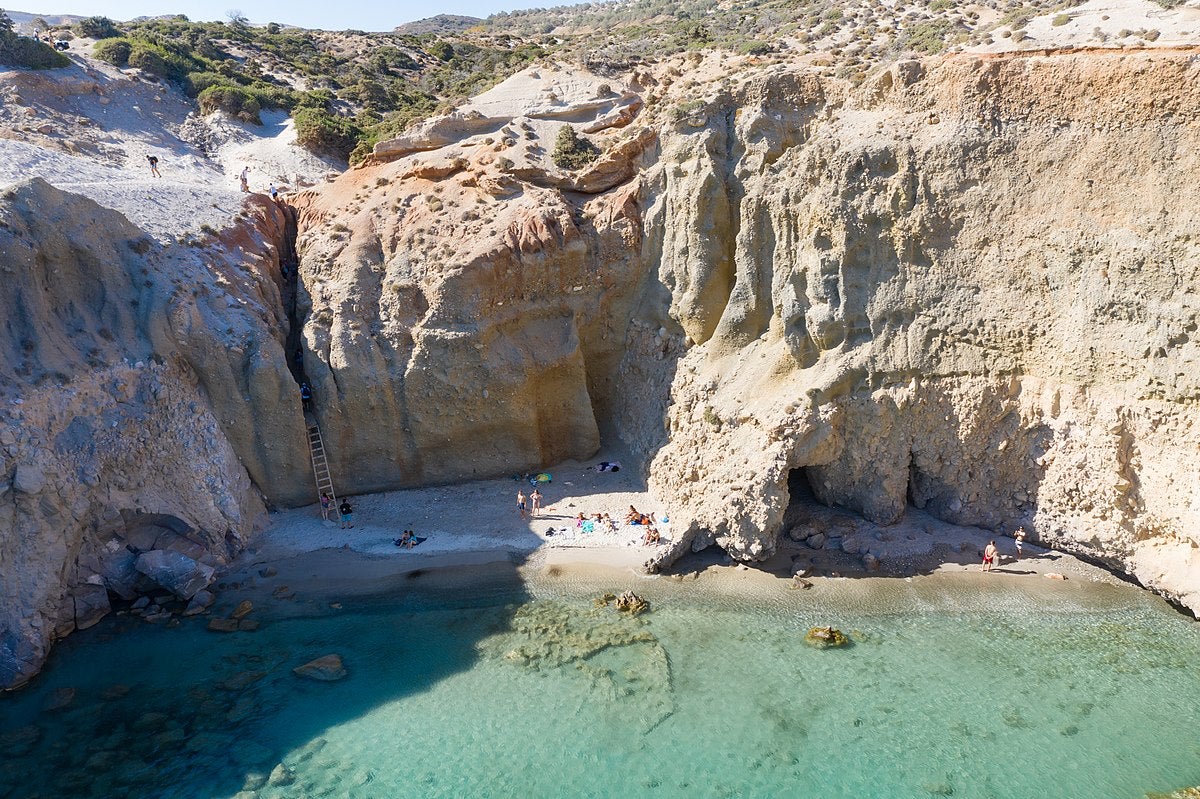
Tsigrado Beach isn’t for the faint at heart, but for thrill-seekers who love a little adventure, it’s a perfect place to head for a beach day.
The beach is similar to some of the others on this list in that it’s almost impossible to access by land. That’s due to the cliffs that shield and surround the shore. However, this beach has an exception. You can climb down to the sand via a rope ladder.
The ladder is stable; you don’t have to worry about it falling, but it can be a little daunting to make your way down on breezy days. However, the soft sand and sapphire blue water are well worth the effort if you’re up for it. The water can also be a bit deep in areas, so this isn’t the most family-friendly spot. However, it will definitely leave you with many memories.
Greece has some of the most gorgeous beaches in Europe. It’s no wonder it’s become a top vacation destination for people all over the world.
You won’t go wrong visiting any of the beaches on this list, and there are plenty of others that just barely missed the cut that will guarantee you have a fantastic trip. You’ll fall in love with Greece’s coastline, so you’ll definitely be back again for future vacations to see them all.
Frequently Asked Questions
Are the beaches in greece warm.
The beaches in Greece are generally quite warm. Especially when compared to other beaches in Europe. Late May to early October is when you will have the warmest conditions.
Can you swim on Greece's beaches?
Greece has a plethora of very swimmable beaches. Even though there are a lot of boats around, the water is still generally clean. However, make sure you check before you go for a dip. Some areas may not be deemed safe for swimmers.
What is the best month to go to Greece?
The best month to go to Greece will depend on what you want out of your trip. In general, the country is most active between March and September. During the fall and winter, many of the smaller villages and vacation spots close down.
How long should I spend in Greece?
Some people can be content with a 3-day Greece vacation. Others think 3 weeks isn’t enough. In general, it’s recommended to try to make your trip to Greece at least 7 days. However, the length can vary depending on your travel needs.
Was this page helpful?
About Amar Hussain
Amar is an avid traveler and tester of products. He has spent the last 13 years traveling all 7 continents and has put the products to the test on each of them. He has contributed to publications including Forbes, the Huffington Post, and more.
INSIDERS ONLY: UP PULSE ™

Get the latest travel tips, crucial news, flight & hotel deal alerts...
Plus — expert strategies to maximize your points & miles by joining our (free) newsletter.
We respect your privacy . This site is protected by reCAPTCHA. Google's privacy policy and terms of service apply.
Related Posts

UP's Bonus Valuation
This bonus value is an estimated valuation calculated by UP after analyzing redemption options, transfer partners, award availability and how much UP would pay to buy these points.
First time Santorini: top tips to have the best time on this famed Greek isle
Dec 7, 2021 • 5 min read

Santorini is a dazzling star of the Greek Islands, and it's extremely popular with tourists © Andrew Mayovskyy / Shutterstock
Santorini is the supermodel of the Greek islands, a head-turner whose face is instantly recognizable around the world: multicolored cliffs soar out of a sea-drowned volcanic crater, topped by whitewashed buildings.
With its reputation for dazzling panoramas, romantic sunsets and volcanic-sand beaches, it’s hardly surprising Santorini features on so many travelers’ bucket lists. If you're planning to join the crowd, here’s what you need to know for your first trip to Santorini .
Part of the Cyclades island group, Santorini (officially known as Thira, a name that encompasses the volcanic islets within Santorini’s orbit) sits in the Aegean Sea, roughly halfway between Athens and Crete.
The island is shaped like a wonky croissant, and the neighboring islets hint at the fact that Santorini was once circular. It was known as Strongili (the Round One). Thousands of years ago, a huge volcanic eruption caused the center of Strongili to sink, leaving a caldera (or crater) with towering cliffs along the east side, now Santorini’s trademark landscape.

Beyond the views, Santorini's vineyards and volcanic beaches
Santorini’s commercial development is focused on the caldera-edge clifftops in the island’s west, with large clusters of whitewashed buildings nesting at dizzying heights, spilling down cliff-sides and offering gasp-inducing views from land or sea. Fira , the island’s busy capital, sprawls north into villages called Firostefani (about a 15-minute walk from Fira) and Imerovigli (the highest point of the caldera edge, about a 30-minute walk from Fira). A path running through these villages is lined with upmarket hotels, restaurant terraces and endless photo opportunities.
These three conjoined settlements draw most visitors, together with the stunning and quite exclusive village of Oia in Santorini’s north. There’s a growing number of hotels in the island’s south, offering caldera views to the north and northeast. Akrotiri’s views come cheaper than Oia’s, but it’s a fair way from the action of Fira.
Santorini’s east coast is lesser known than the celebrated, elevated west coast. Here, the caldera-edge heights have sloped down to sea level, and volcanic-sand beaches and resorts offer a very different drawcard. East coast resorts such as Kamari and Perissa have a more traditional (and more affordable) island-holiday appeal: sunlounger-filled beaches, water sports, bars and taverna-lined promenades. The east coast’s beaches are lined with black sand. On the south coast, there’s a string of beaches famed for their multi-colored sand. The dramatic Red Beach is a traveler favorite.
The island’s interior is dotted with vineyards and traditional villages that let you see beyond the tourist hustle. Make a stop in Pyrgos for great eats and a wander through charming backstreets.
Food, archaeology, open-air cinema: things to do in Santorini
Sure, Santorini's views will stop you in your tracks and you'll get great glimpses into how A-listers travel, but there’s plenty more to explore, from a gorgeous open-air cinema to a cool microbrewery , wine caverns adorned with artworks, and cooking demonstrations and classes that celebrate Santorini’s growing foodie culture.
The obvious prime activity on Santorini is to walk the caldera edge and admire the views. Walks in and around Fira are spectacular, particularly heading north to Firostefani and Imerovigli along the caldera-edge pathway. Keep walking and you’ll eventually reach Oia, but be aware that this is no small undertaking and the trail beyond Imerovigli can be rough. It’s about 5.6 miles (9km) in all, and a good four-hour walk, one way.
Santorini’s lauded wines are its crisp dry whites and the amber-colored, unfortified dessert wine known as Vinsanto. Both are made from the indigenous grape variety, assyrtiko . About a dozen local vineyards host tastings (usually with a small charge) and some offer food, with scenery and local produce combining to great effect. Start your investigations at SantoWines .
Santorini’s intrigue reaches deep into the past, with the fascinating site of Akrotiri displaying a Minoan city destroyed by the volcanic eruption of 1613 BC. In Fira, the impressive Museum of Prehistoric Thera helps piece together the story of ancient Akrotiri.
Nature’s handiwork is on display from any waterfront seat come sundown, but prime sunset-viewing on Santorini is in Oia, where thousands of tourists flock to admire (and applaud) nightfall.
Any tour your heart desires can be organized, and there are dozens of agencies ready to help with winery visits, archaeology tours, sunset-watching and more. The most popular option is a cruise, and the classic itinerary takes in the caldera’s volcanic islands of Nea Kameni and Palia Kameni, including a stop at the former’s crater and the latter’s hot springs.

Accommodation with a view in Santorini comes at a price
If you can afford it, first-timers to Santorini should stay on the caldera edge to experience the full "wow" factor. Fira, Firostefani, Imerovigli and Oia have hotels and villas with whitewashed interiors, terraces and infinity pools that have inspired marriage proposals, high-fashion photo shoots and many Instagram posts.
Unfortunately there are not a lot of places to stay in these view-blessed locales for budget-conscious travelers: caldera-view accommodations come at a premium, and they are in hot demand. You'll also need to book well in advance.
There are decent midrange options in Fira and Firostefani (less so in Imerovigli and Oia), away from the front-row panoramas. There’s also a great hostel and a budget-friendly campground (with rooms) on the outskirts of Fira.
If you’re more interested in a beach break or activities, stay in Perissa or Kamari (and catch the bus into Fira). The advantage of this is some respite from the camera-toting caldera crowds, plus more reasonable prices.

The best times to visit Santorini without the crowds
Peak travel time to Santorini is July and August, when prices soar and hotels, viewpoints and beaches are packed with tourists. The shoulder season months of April, May, early June, late September and October are better times to visit. Things are marginally quieter at the caldera edge, and considerably quieter on the east coast (where accommodation bargains are plentiful).
Don’t discount a winter break, when crowds are scarce (and prices low) while the scenery is still breathtaking. Santorini is working on positioning itself as a year-round destination.

Reach Santorini by ferry, catamaran or plane
Frequent ferries and high-speed catamarans link Santorini with Athens’ main port of Piraeus, Crete and various Cycladic islands. Check OpenSeas for ferry timetables. Santorini Airport has year-round flight connections with Athens, and summertime European connections. On the island, bus services are decent, if crowded in summer. Lots of companies also offer cars, mopeds and ATV four-wheeler bikes to rent.
You might also like: Plan your perfect Greek island-hopping adventure Finding the right Greek island The 10 best museums in Athens
This article was first published May 2019 and updated December 2021
Explore related stories
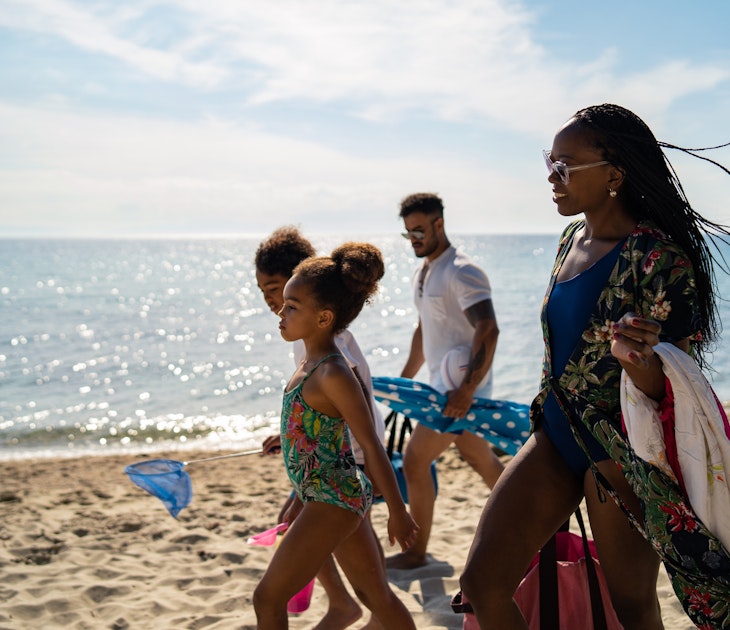
Mar 22, 2024 • 7 min read
Explore world-class ancient ruins, bathe in island sunsets and enjoy incredible food – here are the best things to do in Greece.
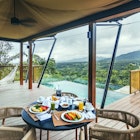
Mar 11, 2024 • 8 min read

Mar 6, 2024 • 8 min read
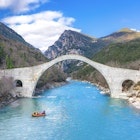
Mar 4, 2024 • 6 min read

Feb 19, 2024 • 7 min read

Feb 15, 2024 • 4 min read

Jan 30, 2024 • 19 min read
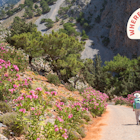
Sep 25, 2023 • 4 min read

Sep 12, 2023 • 6 min read

Aug 22, 2023 • 5 min read

CHARTER A YACHT FOR GREECE
A fabulous Greek islands yacht charter offers an escape from a busy and chaotic life. From the Ionian to Saronic and Cyclades islands, spend relaxing days exploring wild nature deserted sandy coves , pretty and harbours and white-washed fishing villages . You can visit ancient ruins: the Acropolis at Rhodes and the Olympian temples at Katákolon and sample greek food at local tavernas or buy super fresh fish from local fishermen . For top brands shopping and gourmet restaurants, discover the boho-chic Mykonos , where you can end the evening dancing in a cliffside disco overlooking the Aegean Sea .
Every part of Greece is different: the views, aromas, the light, the winds. The islands of Ionian Greece smell of olives, rosemary and stone walls. They are verdant and tranquil with attractive contours. The nature is majestic, the water transparent, the scents intense, the population hospitable and the honey delicious. The wind from the North West is constant but light; there is no strong Meltemi wind here. The sea is calm and the climate mild so the daytime is great for sailing, and at night the wind drops, giving an almost surreal calm. Here is a real treat for those who love cruising by perusing. Of the 120 islands that make up the archipelago, only about twenty are inhabited. The larger ones such as Kefalonia guarantee more services and entertainment. The smaller ones have little more than a tiny village with small restaurants by the sea and a single bar. Stay late into the night chatting, while sipping Ouzo, Metaxa or Mastika, the local liqueurs, in an atmosphere where time seems to have stopped. Every island offers a choice of marinas or coves for the night if you want to spend it under the stars. The best known islands of Ionian Greece are Corfu , Paxos , Anti-Paxos , Lefkas , Ithaca , Kefalonia and Zakynthos , but there are many others that are worth a visit. Amongst them are Meganissi , Othonoi , Skorpio , Kalamos , Kastos , Atokos . On the coast, if the conditions allow, it is worth visiting the two little gems of Parga and Mourtos . The itineraries are flexible, depending on the port of embarkation, the length of your holiday, your personal desires and of course the weather and sea conditions.
We recommend making short hops between the islands of the archipelago, because the real beauty is in discovering new and different places and bays. You must not miss the opportunity to swim each day or stop for the night to enjoy different scenery easily accessible from your charter yacht . With so many sailing destinations available, you are guaranteed a complete seagoing experience. Whether you enjoy relaxed or busy days, a weariness in the evenings would be typical of those who have experienced an emotion filled itinerary.
The Saronic islands are very popular Greek islands for summer holidays and weekend breaks. This is because they are the closest Greek islands to Athens . Aegina , Poros , Hydra and Spetses have developed tourism over recent years, while Agistri is not so famous but remains a true gem to explore. The crystal water , the relaxing atmosphere and the long history are the most distinctive characteristics of Saronic Greece . Each island has a different character; Poros is great for sailing, Hydra has amazing architecture, Spetses is known for its elegant mansions and Aegina is ideal for family vacations.
- Saronic Islands | 12-day itinerary
Interested In CHARTERING A YACHT IN THIS LOCATION?
Get in touch.
Why not get in touch with us to see what options you have for hiring a Yacht with us?
- CALL US - +44(0)7885 912 512
- [email protected]
Or send us a message
Charter a luxury yacht or catamaran.
Are you looking to charter a luxury superyacht , motor yacht, catamaran, sailing yacht or mega yacht for your next vacation?
We offer superb yachts across the world, especially in locations such as Italy and throughout the Mediterranean Sea, UK and in the USA.
Looking to buy a YACHT OR CATAMARAN?
Do you want to live the dream by owning your own yacht or catamaran?
Get started today by viewing the yachts we have for sale, at a range of specifications, sizes and prices.
- Catamarans for charter
- Mega Yachts for charter
- Motor Yachts for charter
- Sailing Yachts for charter
- Superyachts for charter
- Catamarans for sale
- Mega Yachts for sale
- Motor Yachts for sale
- Sailing Yachts for sale
- Superyachts for sale
- Luxury Yacht Holidays
- Yacht Charter for Events
- Yacht Charter Itineraries
- Yacht Charter Destinations
- Yacht Charter in Italy
- Yacht Charter in Mediterranean

©2024 West Coast Brokerage & Yachting Services. All rights reserved.
Privacy Policy | Cookie Policy | Sitemap
Site by Idio
If you want to enjoy the pleasure and comfort of a luxury yacht for your next adventure, we will make your dream come true. Sail with us, we will fulfil your desires.
- Charter A Yacht
- Buy A Yacht
- Our Charter Destinations

- Sterling House, Fulbourne Road, E17 4EE London UK
- +44 (0)788 59 12 512
- Mon – Sat: 09:00AM – 18:00PM
Privacy Overview
You can stay up to date with all the latest news, events and Yacht charter or sales opportunities from West Coast Brokerage & Yachting Services by signing up to our newsletter.
Click below to signup to our communications.

- What we Offer

West Coast Travel is a family owned tourist agency. With many years of experience in the local tourism sector, a vast network of partners and most of all, love for our beautiful region, we are dedicated to offering unique and authentic activities which will let you experience the unparalleled beauty of the West coast of Greece.

Get in touch!
Need more info? Let us help!
Nikis 7 +30 6949353576
[email protected]
destinations

travel ITINERARIES
Google pins, milos, greece: a travel guide to paradise in the aegean sea, europe , greece , milos.
A relatively off-the-beaten-path island a few years ago, Milos has quickly become a popular alternative to Mykonos and Santorini . It’s the most southwestern island in the Cyclades, home to white-washed towns, colorful fishing villages and one of the most spectacular beaches in all of Greece . Below is my complete guide to Milos that includes the best beaches, fishing villages, day trips, travel tips, photo locations, boat companies, restaurants, hotels, Airbnbs, Google Map pins and more to help plan your time on the island.
This post contains affiliate links. When you click these links I may get a small commission that won’t cost you anything, but it does help me run this website.
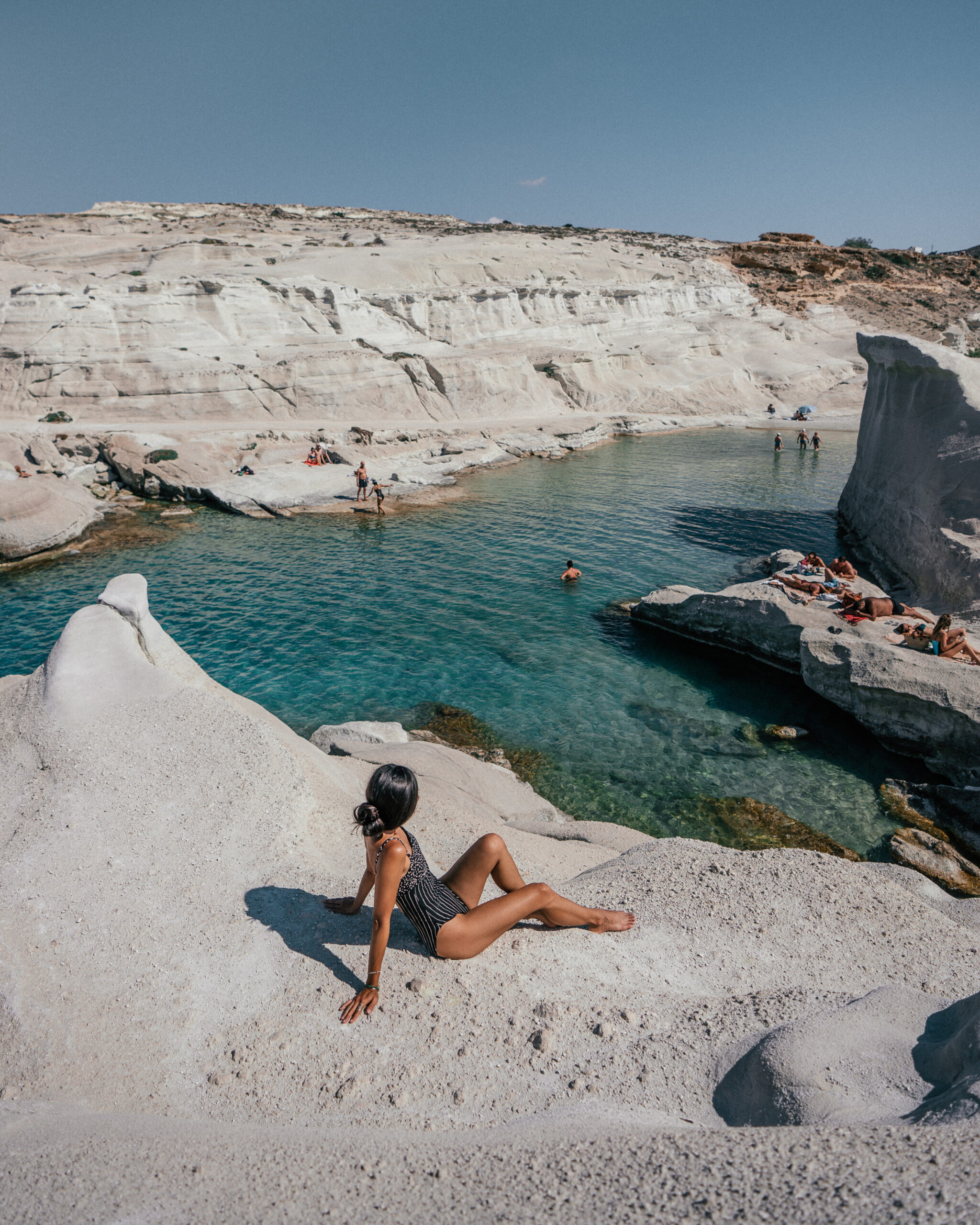
If there were beaches on the moon, I’m certain they’d look like Sarakiniko.
WHEN TO VISIT MILOS
- JUNE, JULY & AUGUST (high season) – This is high season in the Greek islands when both crowds and temperatures peak, even on little Milos. Hotel selection can be sparse and expensive this time of the year if you don’t book early.
- MAY, JUNE, SEPTEMBER & OCTOBER (shoulder season) – The month of September offers the best balance of warm weather, hotel selection and hotel prices, and it’ll be slightly less busy than the summer months. The island is not fully open in April, May and late October, and weather can be hit and miss during these three months, usually too cold to swim.
- NOVEMBER TO APRIL (low season) – Avoid visiting this time of the year. The weather is cold, and most shops and restaurants close for the off-season.
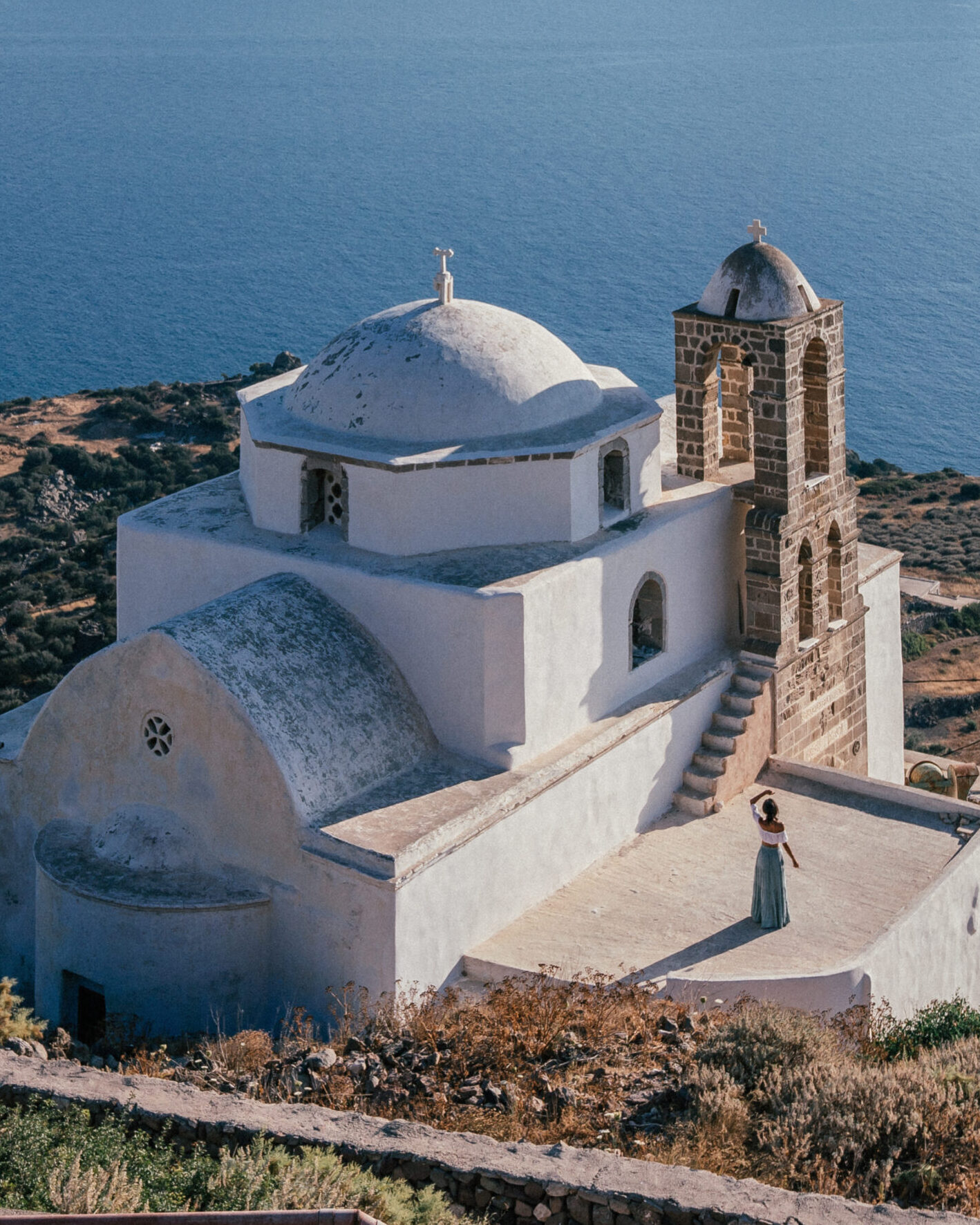
The Venetian Castle is an amazing place to watch the sunset.
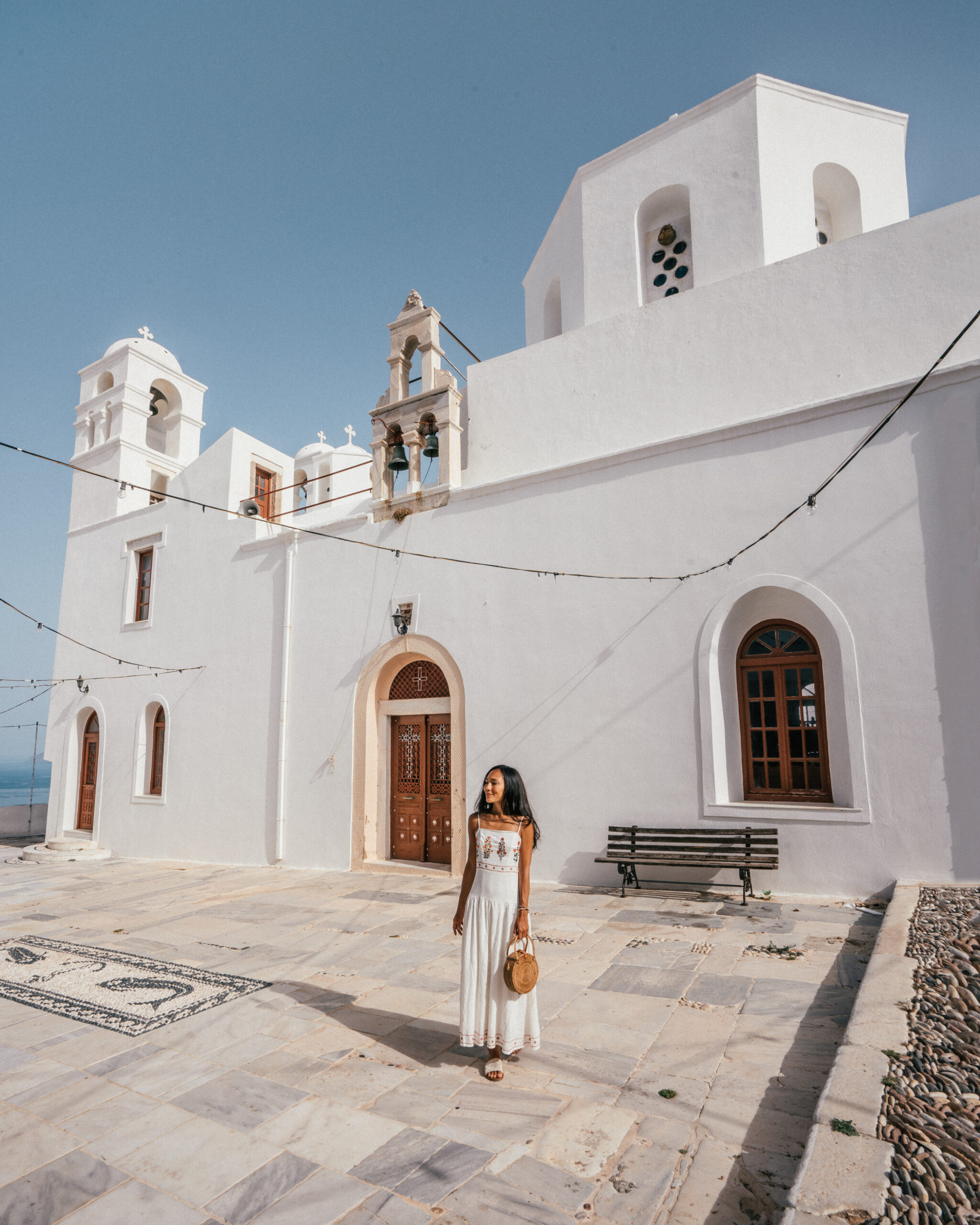
Mother of God Korfiatissa Church.
HOW MANY DAYS ON MILOS?
FIVE DAYS . Milos is a small island, but there’s a lot of coast to see. Five days is the ideal amount of time to see the prettiest beaches, eat at the best restaurants, explore the coast by boat and even take a day trip over to Polyaigos.
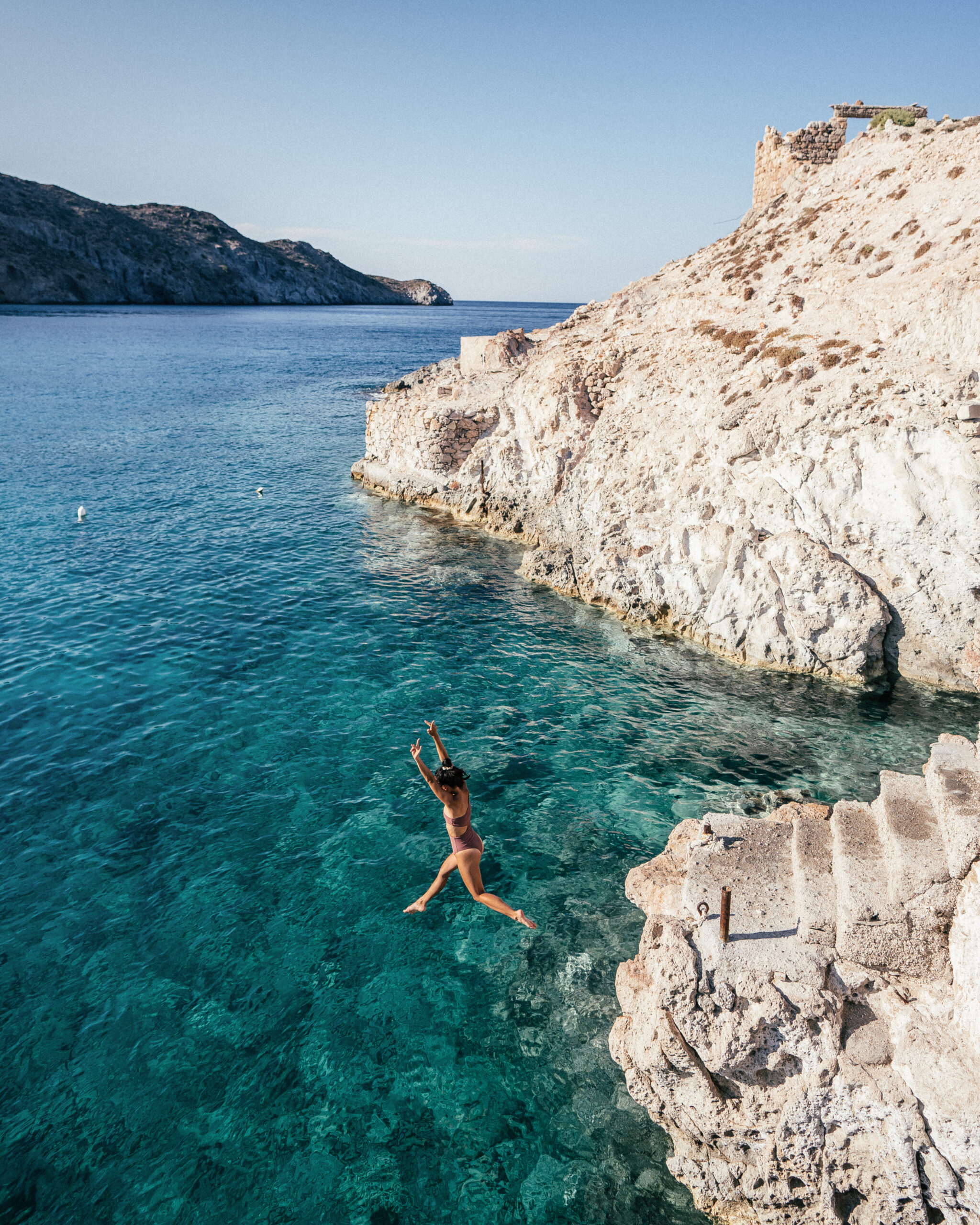
Firopotamos.

Crystalline waters surround the island.
- CURRENCY – The official currency of Greece is the Euro. Almost everywhere on the island takes credit card, but it’s always useful to have cash handy for smaller purchases.
- WATER SHOES – There are many rocky beaches on Milos. Pack a pair of water shoes to make beach walks more comfortable.
- DINNER RESERVATIONS – If you plan to visit in high season, make dinner reservations in advance. The island is small, as are the restaurants, and they fill up during the summer months.

The picturesque streets of little Plaka.
EXPLORE MILOS
FIROPOTAMOS
This quaint fishing village on the north coast of Milos has it all – a stunning bay, colorful boathouses and some of the best chill out vibes on the island. You can walk pretty far out into the bay thanks to the calm, shallow water, but like most beaches in Greece, Firopotamos is rocky. Also, make sure to explore the entire bay when you visit. From the main beach, swim out to the little rocky island to your left for cliff jumping and epic views. Also, drive past the beach to the end of the village where the road ends. Here you’ll find a cute viewpoint for photos, a small church and a more cool cliff jumping spots.
FYRIPLAKA BEACH
Popular beach located on the south coast of Milos. Fyriplaka’s soaring red cliffs serve up a sweeping backdrop, especially from the parking lot at the top of the cliffs. There are sunbeds and umbrellas available for rent, as well as a small snack shack.
This crystal blue bay is an oasis of white cliffs and stacked rock formations that give way to natural sea caves and soaring archways. Pack a swimsuit and visit midday when the water sparkles intense shades of blue, perfect for swimming, floating and kayaking. Kleftiko is best accessed by boat, so you’ll have to join a group tour, book a private tour or rent your own boat. To visit by private boat, Salty Rides runs both half-day and full-day tours – the boats are new, the crew is awesome and they take guests to all the best spots. Alternatively, there are a handful of companies on Milos that will rent out small private boats that you can drive yourself (no license required) – standard price for half-day rental is 150 euros, plus fuel.
Colorful fishing village on the west coast of Milos. It’s not my favorite village, but worth a quick stop if you have the time.
Mandrakia is another fishing village, but this one is a must-visit (my favorite on Milos). The boat houses are bright, colorful and there are a handful of pretty incredible viewpoints. Mandrakia is also home to Medusa, one of the more popular restaurants on Milos.
CHURCH OF PANAGIA KORFIATISSA
Beautiful church that sits in the middle of Plaka’s Old Town. Visit the viewpoint in front of the church for gnarly views at sunset.
PALEOCHORI BEACH
Colorful cliffs spill into the sand at Paleochori, a south coast beach famous for its orange, yellow and white rocks. The turquoise water is pretty dreamy, and there are plenty of sunbeds and umbrellas available to rent. If you’re hungry, Sirocco is located in Paleochori – a seafood restaurant famous for cooking its fish under the beach’s piping hot sand.
The oddly shaped Papafragas is part sea cave, part beach. It sits on the north coast of Milos surrounded by grottoes, rocky islets and funky rock formations. If conditions are right, Papafragas can be beautiful, but when I visited, the waves were rough and the water a dull shade of grey.
The island’s Old Town is charming, but small. There is one main pedestrian boulevard lined with a few bars, restaurants and boutiques, plus a few other lanes with shops and a couple cafes. Plaka is pretty quiet during the day, but comes to life in the evening when tourists spill into town for sunset, drinks and dinner.
KIMILOS & POLYAIGOS
From Milos, it’s possible to visit neighboring islands Kimolos and Polyaigos. There is a ferry service that runs between Pollonia and Kimolos, or it’s possible to visit both islands by daytrip. I booked our visit with Salty Rides because I wanted a private tour – more flexibility and freedom. They run both half-day and full-day tours that include both islands with stops for swimming at the prettiest blue bays, sea caves and secluded beaches. Best to visit midday when the water color is at its bluest.
SARAKINIKO BEACH
Perhaps the most iconic beach on Milos, Sarakiniko is a dazzling moonscape of volcanic white rock riddled with shallow bays, gnarly swimming holes and epic ledges that have become famous for cliff jumping. The beach is quietest in the morning, but the water color is prettiest from 11 AM to 3 PM. Beach vibes are also better midday. There is a small food truck stationed in the main parking lot.
TSIGRADO BEACH
Tsigrado is hit and miss, depending on the weather. Visit on a sunny day with minimal winds, and it’s a recipe for paradise. The little cove is reachable by boat (it’s on the way to Kleftiko if you rent a boat from Agia Kiriaki Beach), or by climbing down a series of ropes and ladders from the parking lot. On a good day, the water is calm and sparkles the prettiest shades of deep turquoise. Swim along the rocks that line the bay, and you’ll find tiny sea caves to swim through. Tsigrado is located next to Fyriplaka, so you can visit both of them on the same day.
PLAKA CASTLE
A popular spot to watch the sunset in Plaka. Plaka Castle is pretty quiet during the day, but dozens of people show up at Golden Hour to climb the rooftop for sunset.

MILOS HOTELS
ARTEMIS SEASIDE RESORT
Secluded south coast stay in Paleochori. The resort’s Cycladic architecture is lovely, and excudes all the feels of the Greek Islands. The Artemis rooms and suites are minimal, and outfitted with whites, neutrals and the occasional pops of blue. There is a lovely pool surrounded by sun beds facing the sea, as well as easy access to the beach.
CAVE SUITES MILOS
Cave Suites Milos is a new luxury boutique hotel on the island. All suites open up to balconies with plunge pools and views of the sea. The design is simple, but spacious with hints of Boho luxury. Location on the north coast is ideally situated halfway between Plaka and Pollonia.
CIVITAS MILOS
Another new luxury hotel on Milos, Civitas Milos is an adults-only property that consists of six plunge pool suites. The design embraces a white and neutral color palette – wood throughout, rounded furniture pieces and exposed stone walls.
COSTA MARE MILOS
This newly built bohemian villa sits in the quiet village of Pollonia. The three bedrooms can hold up to six guests with additional facilities including a large living space, kitchen, private pool, Pergola-shaded lounge area and barbecue. Costa Mare Milos has been meticulously designed with plush bedding, textured blankets, gorgeous ceramic vases, exposed stone walls and beautiful sculpted art pieces. An amazing stay for families or groups.
DOMES WHITE COAST
This stunning Adults-Only boutique property boasts an array of suites, all with private sea-facing plunge pools that sparkle against the matte white Cycladic architecture. The rooms at Domes White Coast are minimalist, but elegant designed with a white and grey color palette.
Dot Milos sits in Adamas, an ideal location for quick access to the airport, Plaka and waterfront restaurants. It’s a new two-bedroom luxury villa that can accommodate up to four guest. The space is an aesthetic mix of neutrals. Matte whites, warm tans, browns and blacks envelop every accent piece – rattan lampshades, ceramic vases, stools, rugs artwork, etc. A beautiful space to stay.
EIGHT FINITY RETREAT
This is one of the best Airbnb finds on the island – an absolute gem perched at the edge of town in Plaka. Eight Finity Retreat is two separate apartments (we stayed in the lower one) that are spacious, modern and loaded with minimalist design cues (lots of whites and rounded edges). Both apartment terraces are completely epic boasting unobstructed views of the sunset.
LEUKI VILLA
Leuki Villa is a lovely one-bedroom villa that opens up to a spacious private terrace and pool. The smooth design and use of white and grey is simple, but elegant. The villa is one deep room built into the rocks, and might be a bit dark for some due to lack of windows.
MELIAN BOUTIQUE HOTEL
Melian Boutique Hotel is a reasonably price sea-facing hotel option in Pollonia with 15 bright white suites that are nothing fancy, but very clean, spacious and comfortable.
Five-star boutique hotel that sits on a private beach on the island’s east coast. On a map it might seem a bit far from the main sights on the island, but everything is still within a 30-minute drive. Milos Cove is an elevated stay offering a dazzling collection of elegant suites and villas with plunge pools.
Luxurious wellness stays are popping up all over the Greek islands, and Noma Milos is one of the newest offerings on Milos. The aesthetic is simple, but this property feels particularly opulent thanks to its mix of creams and browns, high ceilings, rattan shades and beautiful flooring. This is a lovely stay on the island’s remote south coast.
SUNSET NEST
Beautiful apartment located in Plaka that sleeps three, but is better suited for two. A sunny staircase leads to a rooftop terrace that overlooks the little streets of Old Town. Sunset Nest is bright, modern, clean and bursting with character. My only complaint is the restroom – the shower sits over the toilet. If you can get past that, then everything else about Sunset Nest is lovely.
TANIA MILOS
A seaside boutique property, Tania Milos is located in Pollonia, right on the water. One of the best reviewed midrange options on the island.
THAVMA MILOS
Thavma Milos offers an incredibly special stay in an authentic boathouse in Firopotamos. The space has been completely remodeled into a two-level luxury space that sits right over the water in the little village. The interior is simple, but very clean and new. A rare find.
VOLCANO LUXURY SUITES MILOS
This boutique hotel is a neighbor to Artemis Seaside Resort down in Paleochori. This collection of suites are sea-facing Cycladic retreats. Lots of whites and neutrals at Volcano Luxury Suites , like almost all the properties on Milos.
WHITE PEBBLE SUITES
A lovely little boutique hotel located near Pollonia. The White Pebble Suites design is ultra aesthetic – curved matte white buildings surround a sparkling turquoise pool, accented by wood, marble and cement. Suites are on the smaller side, but still make for a very comfortable stay.
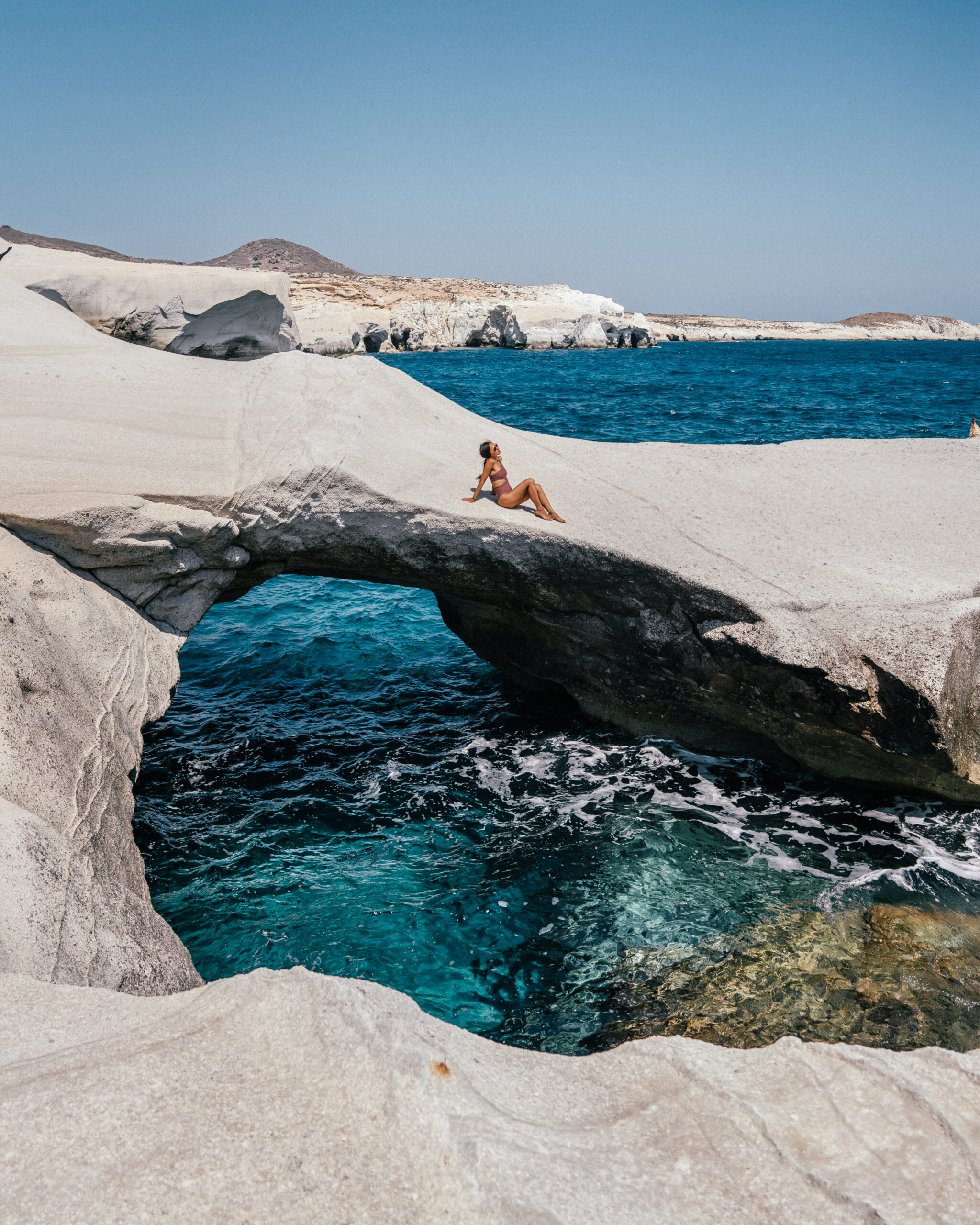
On calm days, this area at Sarakiniko Beach is popular for cliff jumping.

There are so many cool spots to swim, float and sunbathe – it’s easy to spend an entire day at this rocky beach.
GREECE GOOGLE MAP PINS
Every summer I visit the Greek Islands, and now I’m sharing more than 400 of my Google map pins across 12 islands with you guys here . The map is savable to your Google account, and easy to use for trip planning and navigation once on the ground in Greece.
Map pins include:
- must-visit destinations, churches, historic sites, viewpoints
- hotels, villas and Airbnbs
- bars, cafes, gelato shops, restaurants
- beaches, cliff jumping locations, secret coves, sea caves
- boat rental companies, ferry ports
- photos from several of these locations
Islands included in the map: Corfu, Crete, Ios, Kastellorizo, Milos, Mykonos, Naxos, Paros + Antiparos, Paxos + Antipaxos, Santorini

My 400 Google Map pins from the Greek islands are available here .
MILOS RESTAURANTS
AGGELIKI ICE CREAM SHOP
Gelato shops are far and few between on Milos, which makes Aggeliki a must-visit while on the island. The shop is located on the Adamantas waterfront, across from the port. Aggeliki serves up a variety of desert items, but the two dozen ice cream flavors are the highlight of any visit.
GYROS OF MILOS
Cheap, delicious and fresh, this gyro and souvlaki joint is located on the Adamantas waterfront.
HANABI SEASIDE SUSHI
The sushi isn’t the best, and it’s definitely overpriced. But if you are in desperate need of a change in cuisine, Hanabi Seaside Sushi will definitely do the job. And the location on the Pollonia waterfront is lovely.
KOKKINO MILOS
This charming little cafe sits in the heart of Plaka, and serves up a delicious selection of crepes, scrambles, waffles and fresh smoothies.
Medusa is a popular seafood restaurant located in Mandrakia. The outdoor seating overlooks beautiful views of the ocean – a great spot for lunch or an early dinner.
UTOPIA CAFE
Sunset bar located in Plaka – popular early evening spot for drinks.
VERINA COCKTAIL BAR
My favorite spot to hang out at night on Milos. About a dozen small tables make up this tiny cocktail bar located on the main pedestrian boulevard in Plaka.
Yialos is always the busiest restaurant on the Pollonia waterfront, and for good reason. It’s definitely the best seafood on the island. Highlights are the fresh scallops, Greek salad and grilled whole white fish with potatoes and tomatoes.
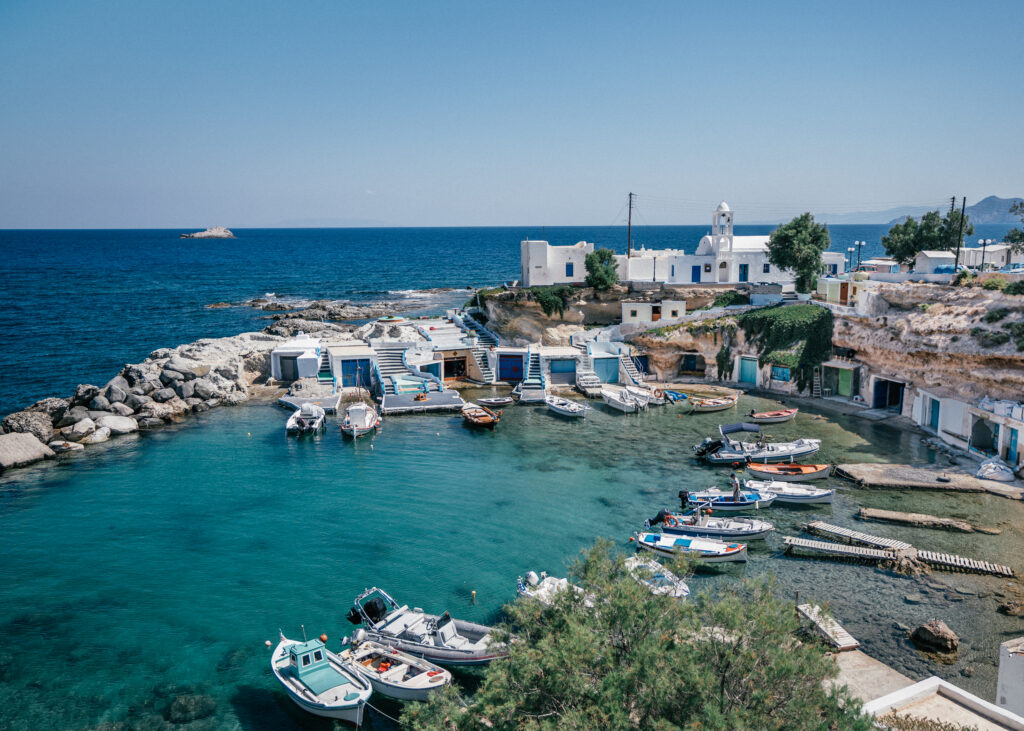
The views over Mandrakia.
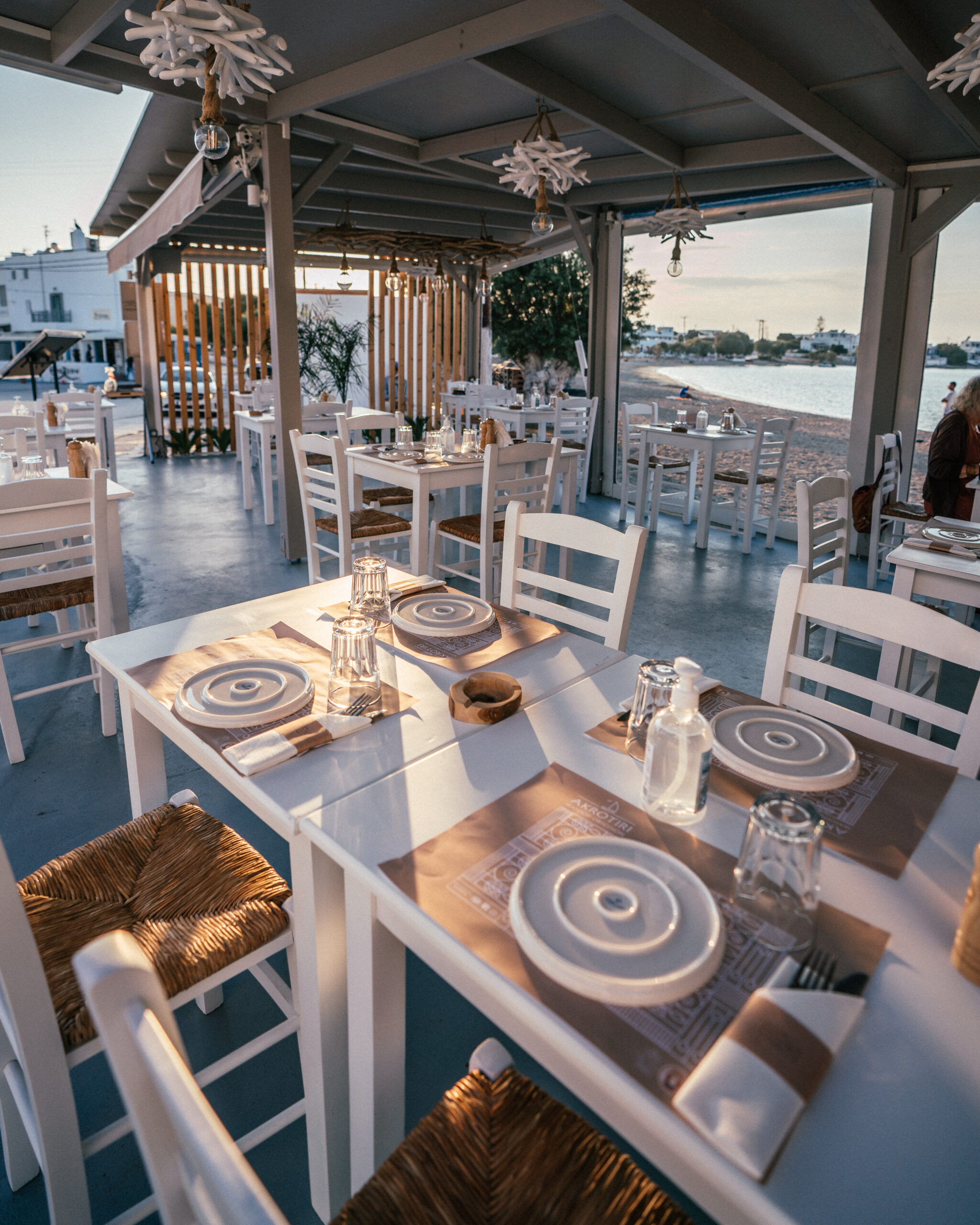
The little Pollonia waterfront is my favorite part of Milos for food.
GET AROUND MILOS
Milos is a small island, but everything is pretty spread out. You’ll maximize your time if you have a set of wheels. Rental agencies can be found all over Adamantas – cars, ATVs, scooters and e-bikes. I rented our car with Budget Car Rentals, and they were great. Almost all rental agencies will ask for an International Driver’s License, so best to be safe and get one before arriving in Greece. If you live in the USA, you can easily pick one up at AAA .
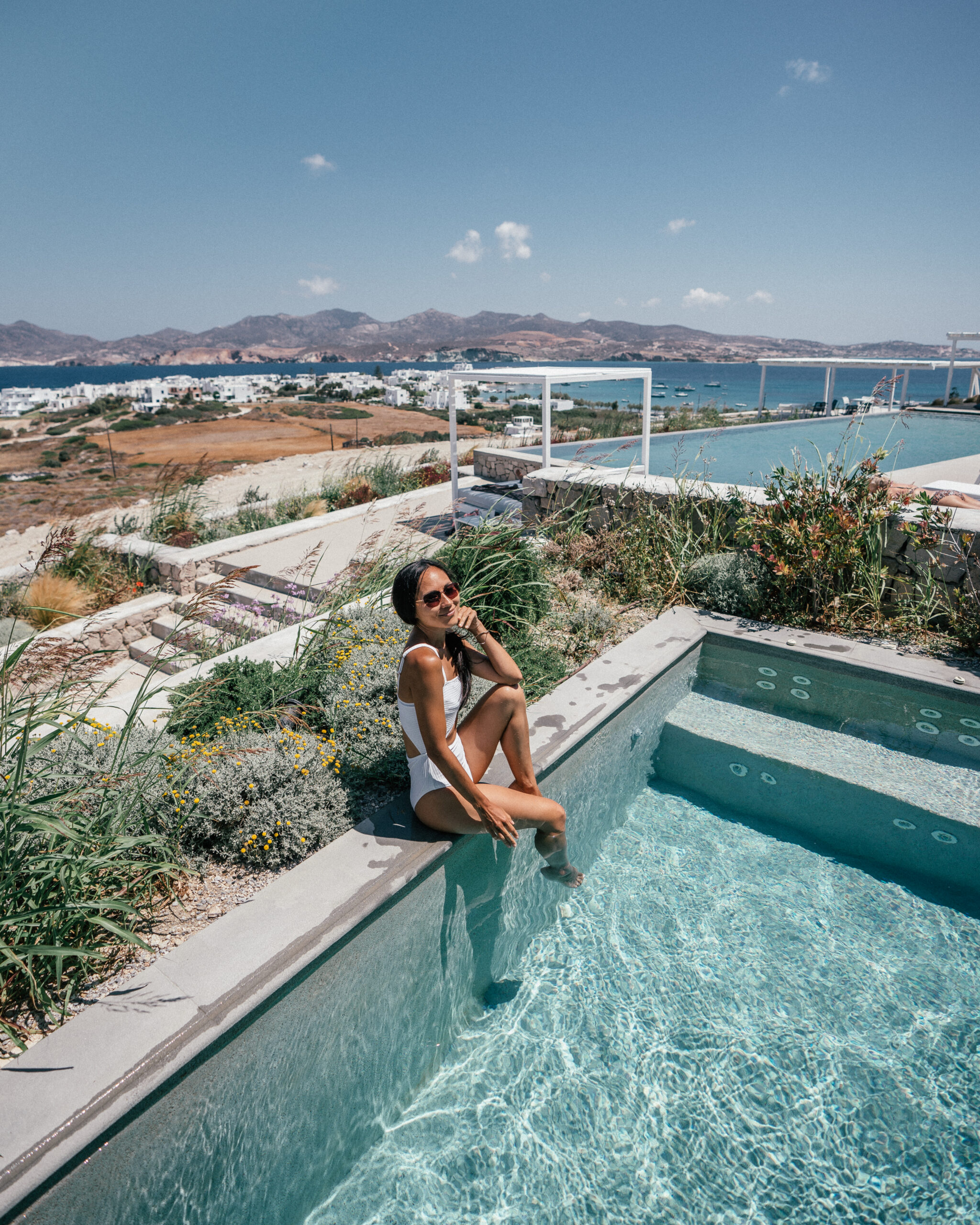
Private plunge pool with a view.
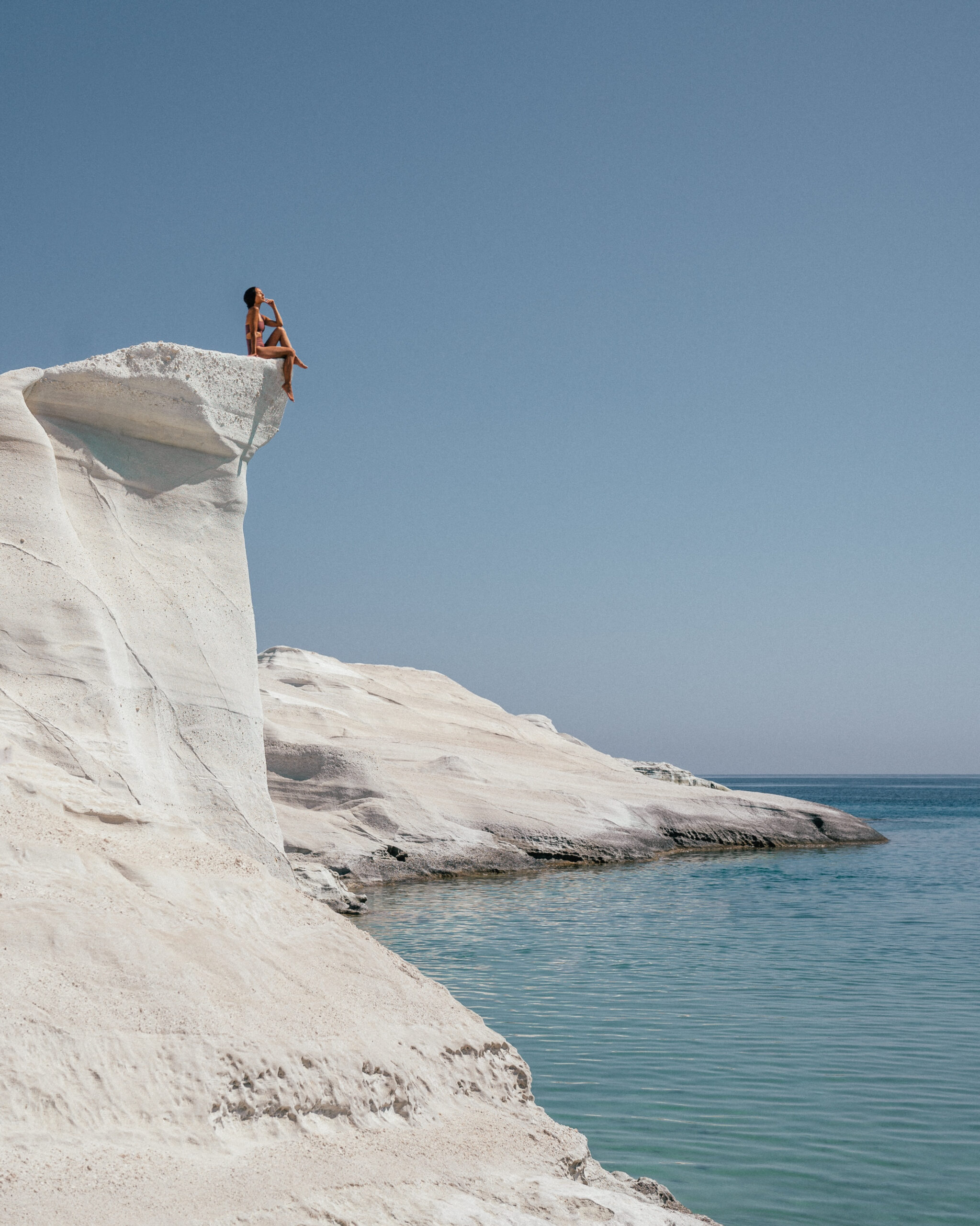
Sarakaniko Beach.
GET TO MILOS
Milos is connected to other destinations in Greece by both land and sea. All flights to Milos connect through Athens, but the ferries connect Milos directly to other islands including Ios , Paros , Santorini , Mykonos , etc. I used Ferryhopper to look up all ferry schedules and to book all my ferry tickets.
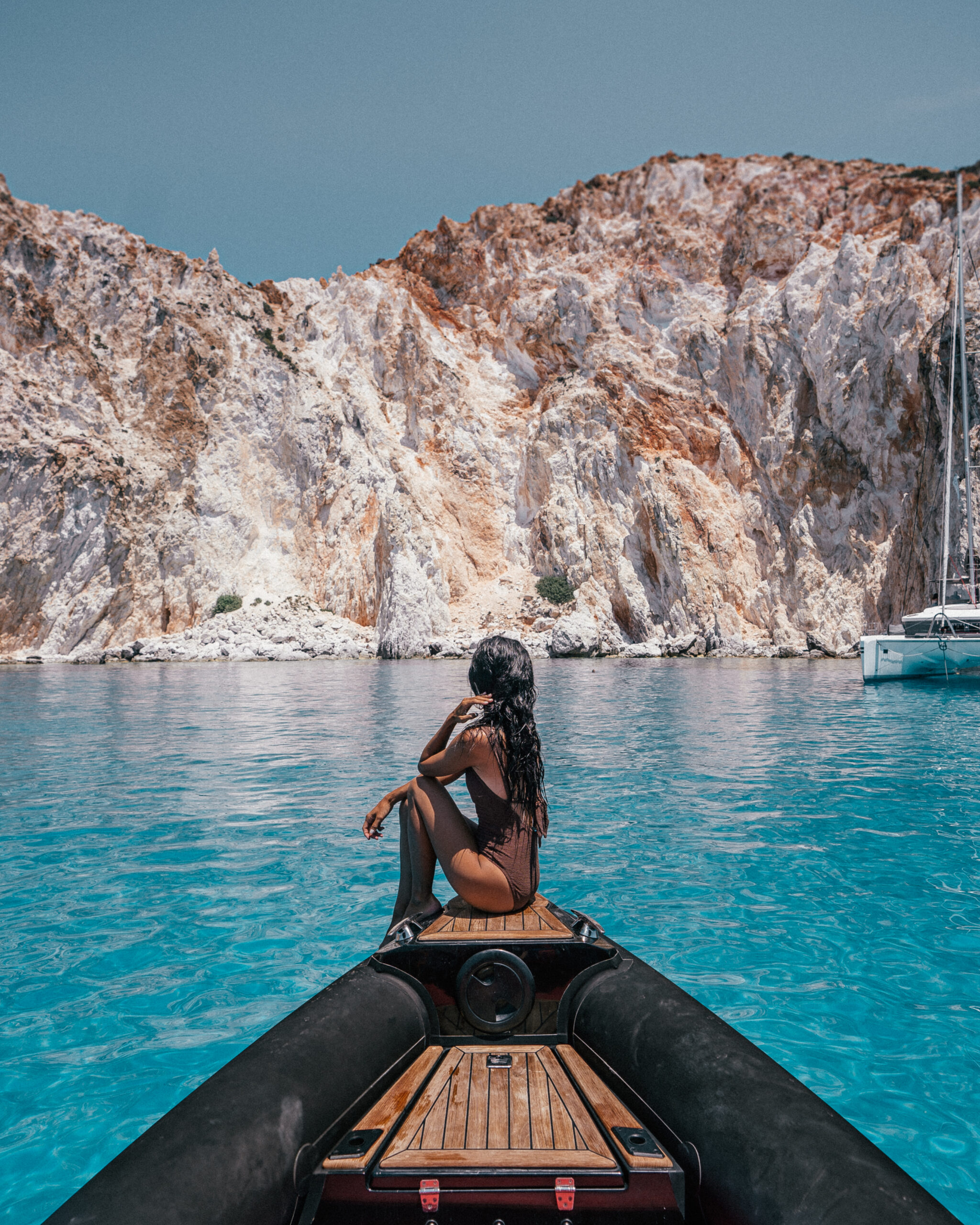
Boat day over to Polyaigos.
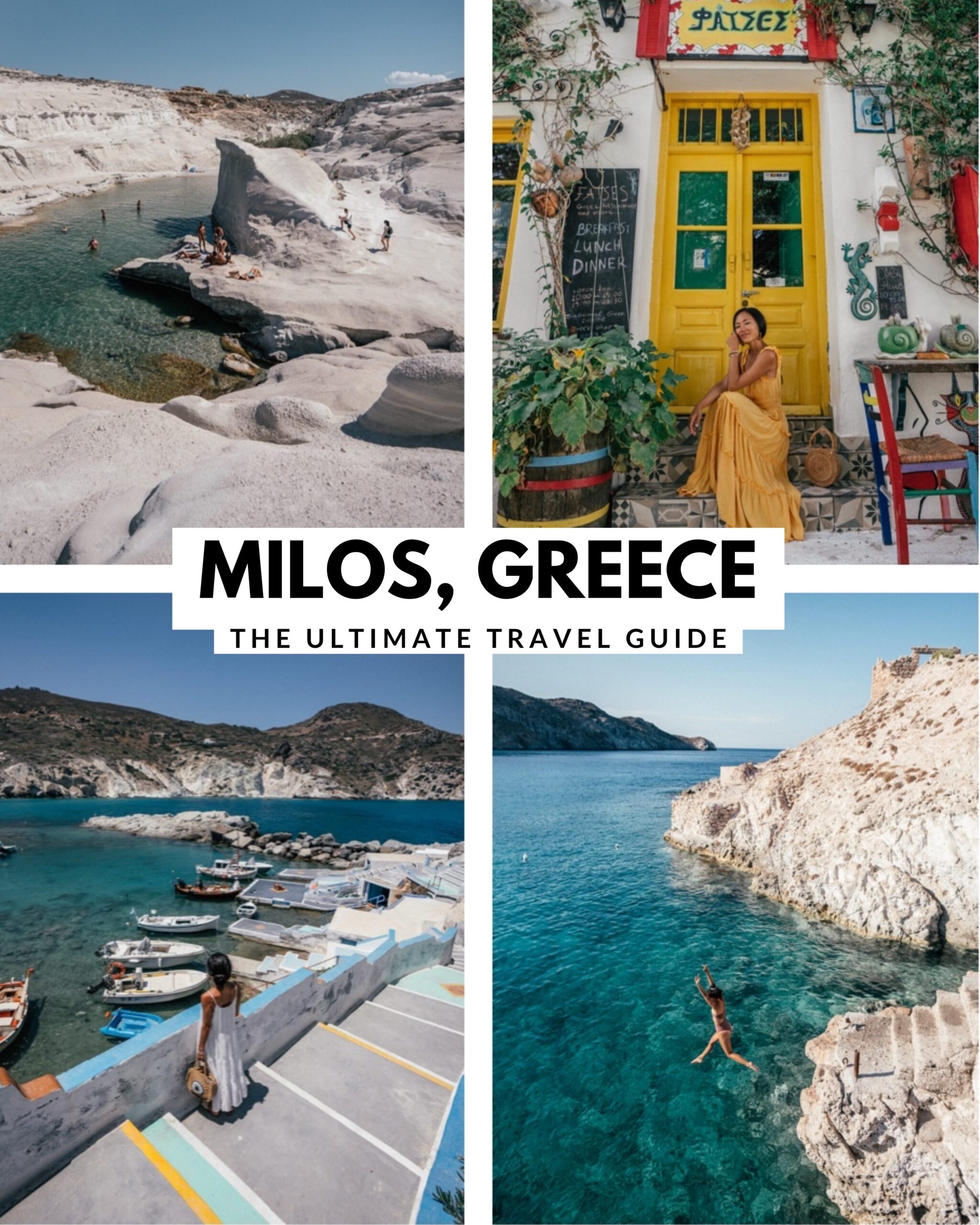
Hi,enjoyed your ‘ page ‘.My wife and I will be in Milos for 5 nights in May,we are staying in Pollonia and renting a lovely penthouse with Outside Jacuzzi. We will be in Paros and Naxos before we get to Milos,do you by any chance have information on these islands.
Many thanks John
Yes, there is a Paros Travel Guide also on my blog: https://bucketlistbums.com/single-post/paros/
Leave a Reply Cancel reply
Your email address will not be published. Required fields are marked *
Save my name, email, and website in this browser for the next time I comment.

©2023 bucketlist bums | all rights reserved site credit karima creative
Shop google pins, shop my closet, shop travel itineraries.

shop my travel ITINERARIES
Shop my favorites, shop my travel pins.
Canadian residents pay in Canadian funds at the exchange rate of 1.33

Greece & Italy 17 Days
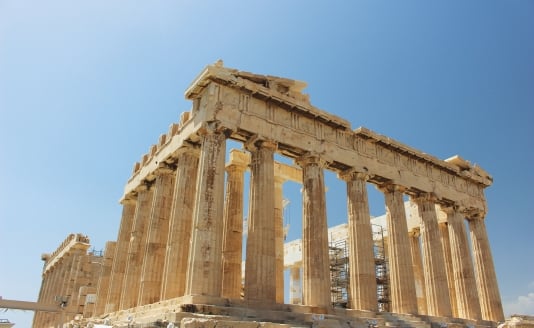
- Greece, the Islands & Italy 25 Days
- Greek Islands 10 Days
Get This Itinerary
- * First Name Last Name
- I agree with the Privacy Policy
- Yes! Subscribe me to emails about teen summer programs and special offers. Emails are generally weekly and you can unsubscribe at any time.
- Phone This field is for validation purposes and should be left unchanged.
- Your Name * First Last
- Your Email *
- Friend's Name * First Last
- Friend's Email *
Greece & Italy Adventure Tour for Teens
This summer program for high school students brings you to see incredible scenery, ancient ruins, and crystal blue waters all in one unforgettable experience! Between all the stunning views and landmarks, teens will tour Italy and mainland Greece hunting for the best espresso, browsing the local shops and art galleries, and dining in the most amazing restaurants. We group the teens on this program into co-ed, age-compatible groups that are fun and inclusive for all. After relishing in the stunning coastal views of Cinque Terre, exploring the Olympic sites, whitewater rafting and enjoying delicious food, teens on this Greece and Italy summer trip will leave with new friendships and memories to last a lifetime.
Please note that teens on some departures of this program participate in the first 17 days of the longer 25-day Greece, the Islands & Italy program.
About This Program

What it’s Like
Experience new cultures and thrilling activities in a smaller, tight-knit travel group.

Accommodation

Includes breakfast and dinner daily.

Includes all recreation & activities listed.

Transportation
Deluxe, private motor coach and a ferry.

ON TOUR Available
ON TOUR departures offer more independence and age-appropriate activities for older teens currently completing 11 th or 12 th grade.

Compatible Groupings
Separate departure dates are assigned to create compatible co-ed age groups.

Up to 26 participants.
Dietary Options
We can accommodate most dietary preferences and allergies.
Program Highlights
- • Hike the 5 villages of Cinque Terre.
- • Discover the beautiful and relaxing beaches of Sivota.
- • Enjoy watersports and tube in the Ionian Sea.
- • Prepare authentic delicacies at an Italian cooking school.
- • Venture to the Parthenon and Acropolis.
- • Enjoy an incredible whitewater rafting adventure.
- • Visit the site of the ancient Olympic games.
- • Explore the ancient Greek cities of Epidavros and Mycenae.
Flight To Milan, Italy
Fly overnight to Milan. Once you land, your orientation will officially begin with some of our favorite icebreakers and “get to know you” activities.
Milan, Italy
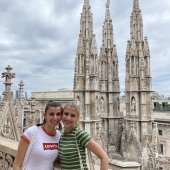
Visit the breathtaking Piazza del Duomo and marvel at the famous cathedral which took nearly 600 years to complete.
Cinque Terre, Italy
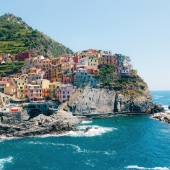
Part of the “Italian Riviera”, these five Italian villages by the sea are built into cliffs and rise from the sea looking much like they did when they were first settled in the 17th century. Enjoy some chill time in the quaint fishing villages of the Cinque Terre. Hike from village to village, stopping for amazing coastal views and irresistible pesto (this is where it was born!). Soak up the Italian sun during a relaxing day at the beach and chill with a night of group activities and bonding overlooking the Mediterranean.
Perugia, Italy

Soak up the festive vibe of Piazza IV Novembre while enjoying a gelato. Wander through the marketplaces and bargain for everything from books and crafts to local breads and cheeses. Prepare your own feast at an Italian cooking school.
Sivota, Greece
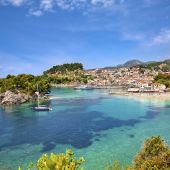
Take the deluxe ferry from Italy to Igoumenitsa, Greece and head to the picturesque coastal village of Sivota. Enjoy the incredible beaches and tube in the crystal blue waters of the Ionian Sea. Dine on authentic Greek cuisine in the neighboring village of Parga.
Monodendri, Greece
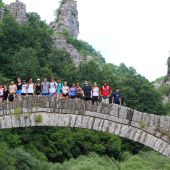
Venture into the mountainous region of Epirus, stopping at the capital city of Ionnina, famous for feta cheese and silver jewelry. Swim in the clear waters of the Papingo natural lakes. River tube the Voidomatis River and visit the many bridges that connect the small surrounding villages.
Olympia, Greece
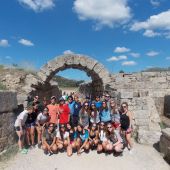
Discover the home of the first Olympic Games in 776 BC. Stop for lunch in the beautiful seaside town of Nafpaktos. Dine overlooking the hills of the Peloponnese region.
Nafplio, Greece
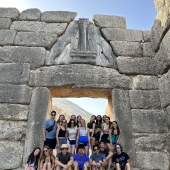
Whitewater raft the thrilling Alfeios River before continuing on to Nafplio, the first capital of modern Greece. Climb the many steps up to the Palamidi Fortress. Imagine being entertained at the Epidavros Theatre and inspired by the Mycenean citadel. Learn to dance Greek-style overlooking the Aegean Sea at dusk.
Athens, Greece
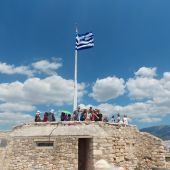
Venture to the heart and soul of Greece and its capital city of Athens. Marvel at the astounding architectural feat of the Parthenon and Acropolis. See Aphrodite amongst her friends in the New Acropolis Museum just down the hill from where she used to live. Wander through the streets of the Plaka area filled with shops and markets.
Return Flight Home From Athens, Greece
Say farewell to your new friends as you part ways for your return home. The summer might be over, but all the memories you’ve made will last a lifetime!
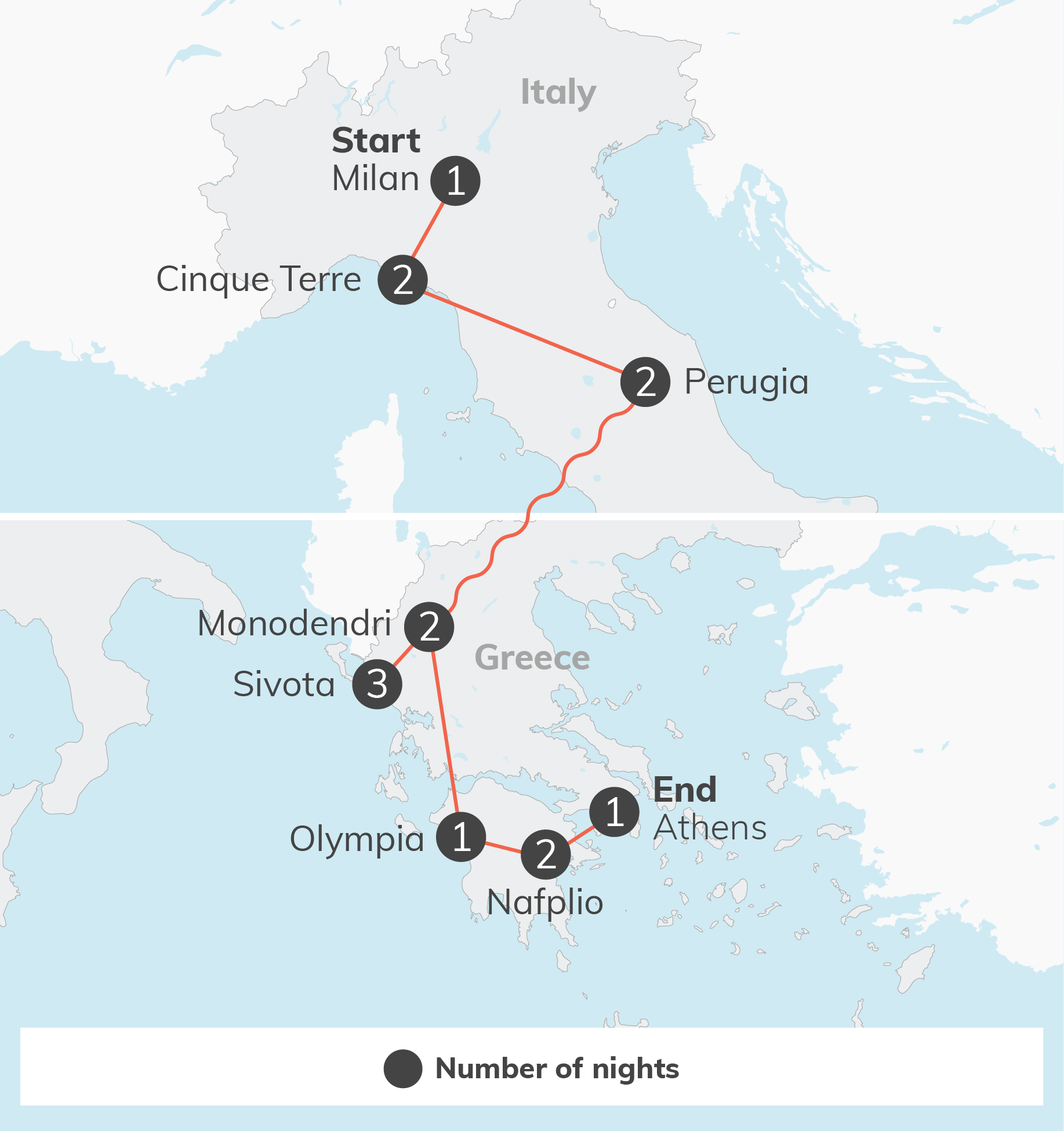
Accommodations
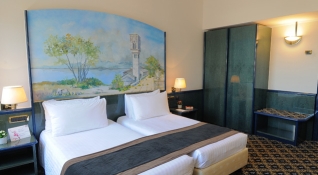
While exploring the beautiful city of Milan, you'll be staying at the IH Hotels Milano Ambasciatori , just steps away from the Duomo.
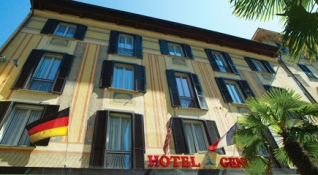
Enjoy a comfortable stay at Hotel Genova , located in the city center of La Spezia. Between sea and town, this hotel is perfectly located.
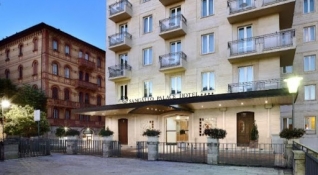
You will stay near the historical city center of Perugia at either Hotel Fortuna , Sangallo Palace Hotel or Hotel Gio Wine e Jazz Area . The hotels are a short walk from Corso Vannucci, where all major tourist attractions are located.
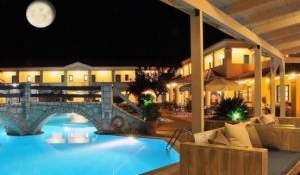
Close to the beautiful town of Sivota, the Karavostasi Beach Hotel is 150 meters from the beach. The rooms overlook the crystal blue waters of the Ionian Sea or resort pool. All rooms are equipped with air-conditioning and Wi-Fi.
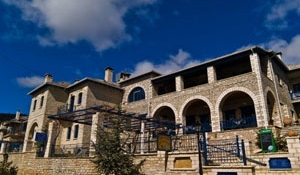
After a full day of exploring the quaint village of Monodendri, stay at the Hotel Archontiko Zarkada , conveniently situated in the hillside of the Epirus region.
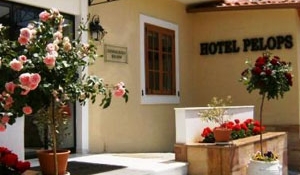
Hotel Pelops is a family run neo-classical hotel in Ancient Olympia. Just 800 yards from the Archaeological site (where the Olympic stadium is) and museums.
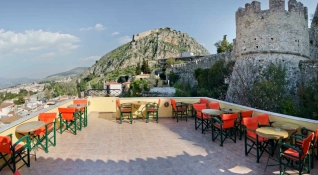
Nearby to the old city of Nafplio and the Palamidi Fortress, you will be staying at either Hotel Marianna or Amalia Hotel . Both locations are ideal for a relaxing stay in this beautiful seaside town.

You will stay in the city center, either at Acropolis Select Hotel , Hermes Hotel , or Central Hotel . Surrounded by small art museums, cafes, and galleries, enjoy the most elegant and residential blocks of Athens.
More Details
Program specifics.
Flight To Milan, Italy Participants on this trip have the option to fly overseas on our chaperoned flight that leaves in the evening from the New York area to Milan. Our leaders greet you at the airport and are with you from check-in onward. For the many travelers from outside the New York area, you can choose to join the chaperoned flight and we are happy to assist you with arranging connecting flights at suitable times into New York. You may also choose to meet us in Milan and we will help you coordinate your flight times and greet you upon arrival.
Return Flight Home From Athens, Greece For the 17-day trip return flight from Athens, our leaders help with check-in and remain in the airport until flights in designated times have departed. They then remain in Greece for the duration of the longer 25-day program and chaperone that flight home. Depending on the number of students departing after 17 days, one staff may chaperone that flight as well.
About ON TOUR This program features separate, age-compatible departure dates, including ON TOUR departures for older teens currently completing 11th or 12th grade. These ON TOUR departures offer more freedom of choice than our other TRAVEL programs by balancing the greater independence that young adults crave with the structure and safety that parents expect. Itineraries include amazing activities and sights for the more mature student, as well as a later curfew. Opportunities to do some safe exploring in smaller groups to find that local cafe or indie boutique also makes this a standout experience for older students.
Meals & New Cuisines Breakfasts in Europe are eaten at our hotels and served buffet style with a variety of options. For dinners, either the whole group goes to the same restaurant or we divide into smaller groups of your choosing with our staff. For lunch, you will enjoy eating in smaller groups and choosing from local cafés, bistros and other restaurants. Are you ready for fresh pasta and pizza in Italy, Greek frozen yogurt and delectable feta and gyros? The food in Europe is terrific, so get set to eat extremely well!
We have satisfied the choosiest of eaters and gladly accommodate most special dietary requests including vegetarian, food allergies, lactose intolerance, celiac disease, and kosher style. We welcome discussing your individual requirements with you and have extensive experience in this area.
Laundry You will only need one week’s worth of clothing as outlined in the packing list that will be sent to you prior to departure. Every week you may drop off your laundry at a local wash and fold service and then pick it up clean, folded and ready to go.
What’s Included Included in your program tuition is all lodging, breakfast and dinner daily, recreation & entertainment listed, airport transfers in designated times, gratuities & taxes.
Not included is transportation to and from the program, lunches, snacks, personal spending money for souvenirs, and laundry. We also make available optional travel insurance that is not included, but highly recommended.
Please contact us with any questions. We are happy to hear from you!
Frequently Asked Questions
Who are the staff and what are their qualifications?
Our staff are educators, guidance counselors, coaches, college and university students, former camp counselors, residence life coordinators, community volunteers, world travelers, and other leaders with diverse backgrounds. Many are former participants themselves who couldn’t get enough of the Westcoast experience! Learn more about our summer leaders .
What if I need to contact my teen during the program?
Participants may bring their cell phones so parents may call and message their kids directly. You may also contact our Communication Centers which serve as the official link between programs on the road and parents. We are staffed every day during the summer and have somebody on call for after hours emergencies ready to assist you 24/7.
What is the difference between an Active Teen Tour and a Global Adventure program?
Our Active Teen Tours offer larger group sizes (generally 35-48 participants) and travel in deluxe motor coaches. Accommodations include quality hotels and occasional fun college residences.
Global Adventures are smaller group experiences (generally up to 26 participants). Groups travel by private motor coaches and occasional public transportation internationally, and use passenger vans in the USA. The France, Switzerland and Italy itinerary travels exclusively by train and public transportation. While these programs have a slightly bigger focus on adventure travel, we stay in quality hotels and lodges, always ensuring a good night’s rest.
Westcoast Connection uses Cookies to enhance your online experience. By browsing our website, you accept the use of these Cookies as explained in our Privacy Policy.
Protect Your Trip »
Best places to visit in may 2024.
With its pleasantly warm weather and thinned crowds, May is the perfect time to take a trip before the expensive summer season. Considering sights, weather, traveler sentiment and annual events (among other factors), U.S. News rounded up the best places to visit in May. Whether you're looking for an outdoor adventure in a national park, a quick Memorial Day getaway or a leisurely beach vacation , you can't go wrong with these destinations. Vote for your favorite locales below to help determine next year's list.
Bryce Canyon National Park
Laguna beach, st. vincent & the grenadines, victoria & vancouver island, yellowstone national park.

When May comes around in Bryce Canyon National Park, the snow is nearly gone, which means the park's main road and popular trails are likely to be open. Highs are typically in the 60s during the day, too – ideal conditions for hiking and biking this Utah park's paths. Visitor numbers start to ramp up this month, but it's still early enough in the season that you're unlikely to have to jostle for a view at the popular Bryce Point, which overlooks Bryce Amphitheater, a landscape of otherworldly rock spires (called hoodoos).

This Portuguese island chain in the Atlantic Ocean offers a little bit of everything for active travelers, from geoparks and waterfall hikes to paragliding. Though the weather here is always a bit unpredictable, the chances of wind and rain are lower in May. The water temperature also begins to warm up for must-do activities like snorkeling or swimming with dolphins, and with fewer swells than the winter months, beginner surfers will feel more comfortable trying to hang ten. As an added bonus, the biggest festival in the Azores – the Feasts of Santo Cristo dos Milagres – typically occurs in May.

Travelers looking for a vacation filled with unique and heart-pumping activities should set their sights on Cappadocia. This mountainous region in central Turkey is home to a UNESCO-listed national park, centuries-old underground cities, ancient cave dwellings, magnificent rock formations and more. Plus, thanks to average temperatures in the 60s and 70s in May, activities like soaring high above the Göreme Valley on a hot air balloon tour and driving a four-wheel-drive vehicle past fairy chimneys couldn't be more pleasant.

As one of the warmest and driest times of year in Palawan, May welcomes travelers with open arms. Take advantage of the minimal rainfall by experiencing all of the outdoor activities and attractions that this Philippine island has to offer –spoiler alert, there are a lot. Spend time relaxing on Palawan's white sand beaches, island-hopping or even swimming with gentle whale sharks. Water sports are popular in this destination as well, from diving Tubbataha Reef to kayaking El Nido's Big Lagoon.

Visiting Granada, Spain, in May is a no-brainer. Average temperatures in the mid-70s, blooming flower displays (at Generalife Gardens) and a full roster of events make this Andalusian city a must-visit in the spring. Día de la Cruz and Feria del Corpus Christi, two of the city's most popular celebrations, are both held in May, and travelers won't want to miss seeing Granada come alive with music, flamenco dancers and more. Save time during your trip for a guided tour of the Alhambra and strolling through the Albaicín neighborhood.

May falls within this Peruvian city's winter season, though you probably wouldn't notice thanks to its consistently mild temperatures (highs hover in the 60s). This month rarely sees rain showers, and you'll encounter fewer tourists at archaeological wonders like La Catedral – which sits in the restaurant- and coffee shop-filled Plaza de Armas – and Machu Picchu – a bucket list destination and UNESCO World Heritage Site located about 50 miles northwest of Cusco. If you're up for a challenge, hike the Inca Trail to Machu Picchu. This difficult trek through the area's towering mountains takes about four days to complete.

With 33 beaches, this eastern Caribbean island is a sun worshipper's dream, and May temperatures in the upper 70s and 80s are perfect for basking on its white sands . Spend warm days venturing to offshore cays, exploring fishing villages and watching yacht races during the Anguilla Regatta, typically held every May. Since this is the start of the island's rainy season, the weather can be wetter and more humid than the winter months, but visitors will be rewarded with cheaper accommodations.

May is a great time for a trip to this seaside Spanish city before the heat and humidity become unbearable. Can't-miss architectural marvels to check out include Antoni Gaudí's whimsical Park Güell and the Gothic-style Sagrada Família. Budget time for visiting some of Barcelona's highly regarded museums, such as the Picasso Museum, and relax at Barceloneta beach before stopping at a nearby seafood restaurant for some of the best paella in the city. What's more, the city plays host to a number of events come May, including film and music festivals

Craggy coastline views, a world-famous aquarium and a superb farm-to-table dining scene draw tourists of all types to Monterey, California. Though temperatures here remain in the 60s for most of the year, rainfall drops significantly in May. Popular festivals also make this a great time of the year to visit. Come early in the month for the Pacific Grove Good Old Days Street Festival, which showcases local artisans and craft vendors, plus a variety of food booths. And near the end of the month, the three-day California Roots Music & Arts Festival celebrates reggae artists.

Visit Laguna Beach for a perfect sunny-and-70, laid-back beach vacation. May is part of this Southern California town's spring shoulder season, so you'll find fewer people on popular stretches of sand like Main Beach and Crescent Bay Beach. Plus, the quieter month is ideal for relaxation-focused activities, such as outdoor yoga and hiking. When travelers need a break from reconnecting with themselves or nature, they can check out Laguna Beach's thriving art scene, which includes hundreds of galleries, studios and public works of art.

Bright turquoise water, gorgeous white sand and lush green vegetation await vacationers in St. Vincent and the Grenadines. Composed of 32 islands and cays, this Caribbean archipelago is perfect for a tropical getaway. May falls between the country's peak winter season and its hurricane-prone low season, making it an ideal time for scuba diving and snorkeling in the Tobago Cays Marine Park, swimming and soaking up some rays at Canouan's beaches and hiking to beautiful waterfalls like Dark View Falls. Travelers will also want to check out the country's 20-acre Botanical Gardens, the oldest available in the Western Hemisphere.

Victoria, British Columbia's capital city, sits on the southern portion of Vancouver Island. Not only does this Canadian destination boast comfortable highs in the low 60s in May, it is just a short ferry ride from Seattle (less than three hours), making it perfect for a quick weekend getaway . Spend your visit strolling through the 55-acre Butchart Gardens, which are bursting with colorful tulips and cherry blossoms come May, then get out on the water on a whale watching tour. Before heading home, don't forget to shop for souvenirs along Government Street.

Considered the birthplace of democracy and drama, Athens boasts a historical legacy that is hard to top. The main reason to visit is to see the ancient city's impressive ruins, which you'll find at the Acropolis and Ancient Agora. For an additional look at Athens' past, check out the incredible Greek artifacts on display at the National Archaeological Museum and the Benaki Museum of Greek Culture. May vacations are especially enjoyable thanks to comfortable daytime temps hovering in the mid-70s.

By late May, most of Yellowstone's trails and must-see attractions are open, welcoming eager nature enthusiasts seeking a breath of fresh air. The average 50-degree temperatures provide a brisk but comfortable atmosphere for a hike on one of the Old Faithful area's trails or a kayaking excursion on Yellowstone Lake. For a glimpse of wildlife, head to Lamar Valley to view wolf pups emerging from their dens. Keep in mind that if you visit during Memorial Day weekend, you'll likely run into crowds.

With warm weather year-round (average temperatures sit in the 80s), there's never a bad time to visit Singapore. But in May, this Asian city-state on the southern tip of the Malay Peninsula welcomes events such as the Singapore Cocktail Festival, the Singapore International Festival of Arts and the Singapore HeritageFest. When you're not enjoying your time at one of Singapore's cultural events, check out top attractions like Gardens by the Bay, a futuristic nature park that is home to the Supertree Observatory and the Cloud Forest.
Vote to Add these Destinations to the Rankings

Kruger National Park

Mont-Tremblant

Miami Beach

Newport, RI

Mexico City

Indianapolis
You may be interested in.

Best Places to Visit in Spring

Best National Parks in the World for 2024

Best Places to Visit in April 2024

Best Spring Break Destinations for Families

Best Places to Visit in June 2024

Best Beaches in the World for 2024
If you make a purchase from our site, we may earn a commission. This does not affect the quality or independence of our editorial content.
Recommended
The 50 Best Hotels in the USA 2024
Christina Maggitas February 6, 2024

The 32 Most Famous Landmarks in the World
Gwen Pratesi|Timothy J. Forster February 1, 2024

9 Top All-Inclusive Resorts in Florida for 2024
Gwen Pratesi|Amanda Norcross January 5, 2024

24 Top All-Inclusive Resorts in the U.S. for 2024
Erin Evans January 4, 2024

26 Top Adults-Only All-Inclusive Resorts for 2024
Zach Watson December 28, 2023

Solo Vacations: The 36 Best Places to Travel Alone in 2024
Lyn Mettler|Erin Vasta December 22, 2023

26 Cheap Beach Vacations for Travelers on a Budget
Kyle McCarthy|Sharael Kolberg December 4, 2023

The 50 Most Beautiful White Sand Beaches in the World
Holly Johnson December 1, 2023

The 26 Best Zoos in the U.S.
Rachael Hood November 16, 2023

44 Cheap Tropical Vacations That Feel Expensive
Holly Johnson|Alissa Grisler November 10, 2023

- International edition
- Australia edition
- Europe edition
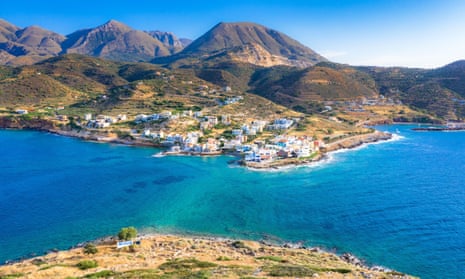
Retreat to Crete: why the Greek island is a perfect escape
The unspoilt northeast of Greece’s largest island offers a restorative mix of uncrowded beaches, authentic tavernas and extraordinary views
S ometimes, when you travel, you arrive somewhere so ridiculously picturesque, so dictionary-definition of how you expect the country to look, that you half suspect it was built as a film set, or has been “Disneyfied” specifically for tourists.
I get this feeling when I walk on to the small, horseshoe-shaped bay at Mochlos, Crete. Half a dozen restaurants, all cobalt wooden chairs, whitewashed tables and blackboards offer gyros and freshly caught fish. On the slim strip of stones that fringes the low sea wall, a handful of locals is towelling off after a late dip, the last two heads bobbing in the metallic blue water, the small, humpy island behind them backlit by the apricot-gold light of the sun, slowly dipping beneath the horizon.
I settle in with a cold Mythos and order up a plate of crispy gyros, fresh pitta and tzatziki. As I gaze out over the slowly darkening Gulf of Mirabello, I feel sure that a week here, doing nothing but pottering the 10-minute walk between my hotel, the Mochlos Blue, and this ramshackle clutch of tavernas, would be more restorative than a luxurious spa hotel.
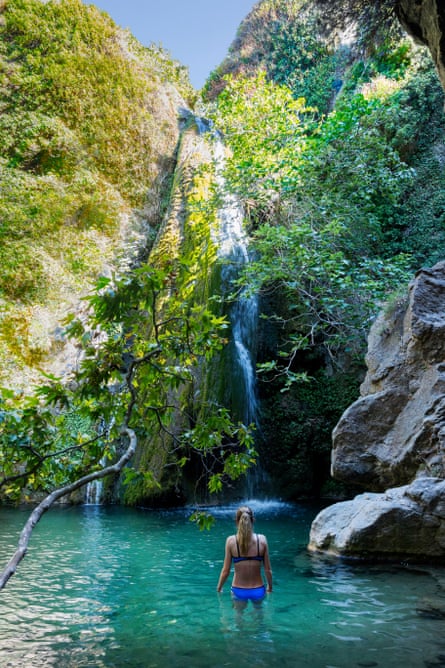
But this quiet corner of Crete is well worth exploring. The northeast, home to the Dikti mountains, is one of the island’s last unspoilt stretches of coastline, and a world away from the luxury resorts that scatter the coast around Elounda, and the 1980s sprawling hotels and apartments that characterise places such as Agios Nikolaos.
After a lazy first day, I set out to discover a good local beach (the one thing Mochlos doesn’t have), and follow a recommendation to Tholos, hidden away 3km from the main road.
It turns out to be an absolute treat of a beach: a long strip of sand that is free of sun loungers and parasols, the only shade thrown by a cluster of tamarind trees sheltering a handful of cars. As I step into the water, only one other couple is swimming. The water is sparklingly clear, shoals of tiny fish whisking through the shallows. The mountains loom to the southern end of the beach past one whitewashed house on the small road that leads over the headland to the north.
The swimming is really only an excuse for over-indulgence. Cretan food is arguably the best in Greece, the island’s diverse landscapes producing everything from mountain herbs, greens and tangy cheese to grassily delicious olive oils, freshly caught fish and crispy pastry snacks, such as spanakopita – golden flaky pastry, stuffed with salty feta and herbs. Best of all, because this area of Crete is off the mainstream tourist trail, even the most spectacularly situated taverna rarely gets overrun.
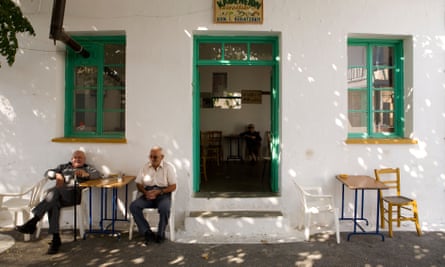
I head to the village of Mirsini, where a huddle of whitewashed houses clambers up the mountainside and Mochlos is little more than a vague white fringe along a small strip of sea, hundreds of metres below. As I climb the steps of the Taverna Kathodon , I pass circular trays of tomatoes, slowly drying in the sunshine. I emerge on to a series of small terraces, crammed with terracotta pots and mismatched chairs and tables. The bright yellow walls are covered with everything from straw hats to fake flowers and old cooking implements.
The view is so spectacular – great, scrub-faced mountains, the distant outline of Crete’s jagged northern coast like a huge sleeping alligator beside the sea – that it wouldn’t matter if the food was average. Instead, I eat crispy mizithropita – a flatbread stuffed with cheese, hot off the pan and drizzled with honey, and dolmadakia – the most succulent vine leaves I’ve ever tasted.
At the table next to me, an elderly couple is making their way through a carafe of wine, taking pictures to send to their grandchildren. On the other side of the terrace, a Greek family is squabbling over vast plates of meatballs and calamari. Beneath it all, the cicadas keep up their rhythmic chorus. It strikes me I may have reached peak Greek.
after newsletter promotion
All the eating pushes me into deciding to tackle the Richtis Gorge , a short half-hour drive from Mochlos. I take the easy option (although it’s all relative) and drive the steep, twisting road from the upper car park down to the beach, reducing the hike from two hours to about 40 minutes (and cutting out most of the uphill stretches). Even so, it’s quite a clamber and more like a rainforest walk than a gorge. Small waterfalls rush through gashes in the rock, understudies for the main event – a shimmering, aquamarine pool with kinetic tendrils of water hurling down over the rock face above.

The Richtis proves to be quite the adventure, justifying my last day of doing little except lazing by the Mochlos Blue’s tranquil pool. The hotel is adults-only (apart from summer school holidays), and with just six rooms it feels more like a spacious villa; the honesty bar is well stocked with snacks, cold beers and local wine, and the small breakfast buffet is complimented each morning by a traditional, homemade treat – scrambled eggs with tomato, spanakopita and, my absolute favourite, loukoumades – deep-fried dough balls, drenched in honey and nuts.
On my last evening, I drive up from the village for supper at the Taverna Natural , where tables are set out in a charming, tree-dotted garden. The view across the Gulf of Mirabello is perhaps one of the most stunning on the whole island. I time it just right for the sunset and watch, transfixed, as the sky flames through an extraordinary palette of colours, the sun burning slowly down towards the purple-auburn mountains. I order a tomato salad and moussaka, the aubergines lying across the dish like silk. The view is extraordinary, the food delicious, the beer perfectly chilled… Would it be wrong to stay another week?
A week at the Mochlos Blue costs from £899, including car hire and B&B accommodation, through Simpson Travel. For more details, go to simpsontravel.com
- The Observer
- Greek food and drink
- Greece holidays
- Crete holidays
Most viewed
Mountain View, CA
Mountain View
Around the Globe
Hurricane tracker.
Severe Weather
Radar & Maps
News & features, winter center, news / weather news, minor damages reported after 6.6 magnitude earthquake hits japan.
By Doug Cunningham, UPI
Published Apr 18, 2024 4:38 AM PDT | Updated Apr 18, 2024 4:38 AM PDT

Partner Content

(Credit: Getty images)
April 17 (UPI) -- A 6.6 magnitude earthquake hit Japan at 11:14 p.m. Wednesday local time, off the west coast of Shikoku Island.
Initial reports said there was no threat of tsunami and only minor injuries and damage reported.
The quake's epicenter, where the 6.6 magnitude was recorded, was in a strait called the Bungo-Suido Channel between Kyushu and Shikoku Islands.
According to news conference statements from Chief Cabinet Secretary Yoshimasa Hayashi, light injuries were reported, along with minor damage like broken water pipes, downed streetlights and some landslides onto a national highway.
The 6.6 measurement was on the Japanese scale of zero to 7.
The strongest measured impacts were in Ainan Town, Sukumo City, and Uwajimia City, according to Japan's Meteorological Agency.

Weather News

The disastrous power of tornadoes

WATCH: Here's what it was like inside a tornado in Iowa

How to keep frost from killing your garden
Top Stories
Trending Today
Accuweather early, accuweather prime, solar eclipse 2024.
Severe weather threat to rebound in central US

Meteor shower drought to end as Lyrids peak this weekend
22 hours ago

Weather Forecasts
Downpours, flooding risk to return to soggy south-central US

Winter Weather
Potentially damaging frosts and freezes coming to Midwest, Northeast

Indonesia's Ruang volcano erupts in spectacular fashion
5 hours ago

Featured Stories
AccuWeather Ready
Top 3 tips on lightning safety from a leading safety expert
3 hours ago

More than 100 killed across Pakistan and Afghanistan as flash floods a...

Camels evolved from a cold-weather ancestor

Maui wildfire report: Wind-swept smoke trapped residents

5 ways the Columbia disaster changed spaceflight forever

We have updated our Privacy Policy and Cookie Policy .
Get AccuWeather alerts as they happen with our browser notifications.
Notifications Enabled
Thanks! We’ll keep you informed.
Watch CBS News
Solar eclipse maps show 2024 totality path, peak times and how much of the eclipse people could see across the U.S.
By Aliza Chasan
Updated on: April 9, 2024 / 5:00 AM EDT / CBS News
A total solar eclipse crossed North America Monday with parts of 15 U.S. states within the path of totality. Maps show where and when astronomy fans could see the big event as skies darkened in the middle of the day Monday, April 8.
The total eclipse first appeared along Mexico's Pacific Coast at around 11:07 a.m. PDT, then traveled across a swath of the U.S., from Texas to Maine, and into Canada.
About 31.6 million people live in the path of totality , the area where the moon fully blocked out the sun , according to NASA. The path ranged between 108 and 122 miles wide. An additional 150 million people live within 200 miles of the path of totality.
Solar eclipse path of totality map for 2024

The total solar eclipse started over the Pacific Ocean, and the first location in continental North America that experienced totality was Mexico's Pacific Coast, around 11:07 a.m. PDT, according to NASA. From there, the path continued into Texas, crossing more than a dozen states before the eclipse enters Canada in southern Ontario. The eclipse exited continental North America at around 5:16 p.m. NDT from Newfoundland, Canada.
The path of totality included portions of the following states:
- Pennsylvania
- New Hampshire
Small parts of Tennessee and Michigan also experienced the total solar eclipse.
Several major cities across the U.S. were included in the eclipse's path of totality, while many others saw a partial eclipse. These were some of the best major cities for eclipse viewing — though the weather was a factor :
- San Antonio, Texas (partially under the path)
- Austin, Texas
- Waco, Texas
- Dallas, Texas
- Little Rock, Arkansas
- Indianapolis, Indiana
- Dayton, Ohio
- Cleveland, Ohio
- Buffalo, New York
- Rochester, New York
- Syracuse, New York
- Burlington, Vermont
Map of when the solar eclipse reached totality across its path
The eclipse began in the U.S. as a partial eclipse beginning at 12:06 p.m. CDT near Eagle Pass, Texas, before progressing to totality by about 1:27 p.m. CDT and then moving along its path to the northeast over the following few hours.
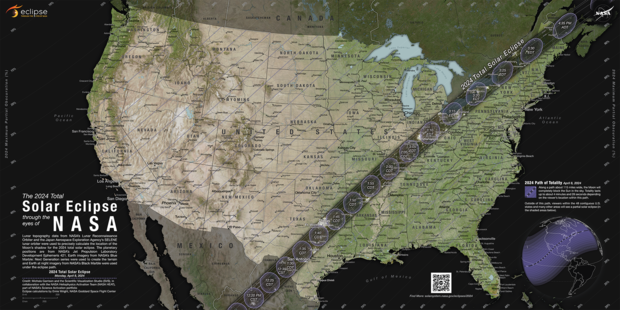
NASA shared times for several cities in the path of totality across the U.S. People could have also checked their ZIP code on NASA's map to see when the eclipse was to reach them if they were on, or near, the path of totality — or if they saw a partial eclipse instead.
How much of the eclipse did people see if they live outside the totality path?
While the April 8 eclipse covered a wide swath of the U.S., outside the path of totality observers may have spotted a partial eclipse, where the moon covers some, but not all, of the sun, according to NASA. The closer they were to the path of totality, the larger the portion of the sun that was hidden.
NASA allowed viewers to input a ZIP code and see how much of the sun was to be covered in their locations.
Could there be cloud cover be during the solar eclipse?
Some areas along the path of totality had a higher likelihood of cloud cover that could interfere with viewing the eclipse. Here is a map showing the historical trends in cloud cover this time of year.
You could have checked the latest forecast for your location with our partners at The Weather Channel .

Where did the solar eclipse reach totality for the longest?
Eclipse viewers near Torreón, Mexico, got to experience totality for the longest. Totality there lasted 4 minutes, 28 seconds, according to NASA.
Most places along the centerline of the path of totality saw a totality duration of between 3.5 and 4 minutes, according to NASA. Some places in the U.S. came close to the maximum; Kerrville, Texas, had a totality duration of 4 minutes, 24 seconds.
What is the path of totality for the 2044 solar eclipse?
The next total solar eclipse that will be visible from the contiguous U.S. will be on Aug. 23, 2044.
Astronomy fans in the U.S. will have far fewer opportunities to see the 2044 eclipse they had on April 8. NASA has not yet made maps available for the 2044 eclipse but, according to The Planetary Society , the path of totality will only touch three states.
The 2024 eclipse will start in Greenland, pass over Canada and end as the sun sets in Montana, North Dakota and South Dakota, according to the Planetary Society.

Aliza Chasan is a digital producer at 60 Minutes and CBSNews.com. She has previously written for outlets including PIX11 News, The New York Daily News, Inside Edition and DNAinfo. Aliza covers trending news, often focusing on crime and politics.
More from CBS News

Object that crashed through Florida home's roof was from space station

NASA seeks to reign in costs of Mars Sample Return mission

911 outages reported in 4 states overnight

Governors decry UAW push to unionize car factories in Southern states
Why the New Jersey earthquake was felt several hundred miles away

Wendy Bohon, an earthquake geologist, was reading a budget report Friday morning at her home in Chesapeake Beach, Md., when she felt the unmistakable light shaking of an earthquake . The cat didn’t wake up. The dog looked around. A plant swayed.
The tremors traveled about 160 miles to Bohon’s home from a 4.8-magnitude earthquake near Whitehouse Station, N.J. It was a moderate earthquake from a geological point of view, with similar-sized quakes happening frequently all over the globe. But it marked a relatively infrequent event on the East Coast — one that jostled people across the Mid-Atlantic and Northeast from their daily routines.
More than 150,000 people reported feeling the New Jersey earthquake, some from several hundred miles away, according to the United States Geological Survey , which collects reports of shaking. While the number of reports reflects the population density of the area, it also highlights a fundamental geological difference between the tectonically active West Coast and the East Coast, which is covered by old faults that occasionally get reactivated.
The underlying rock in the East Coast is old, cold and dense, and the faults have had time to heal, meaning that seismic waves travel farther than on the West Coast, where the crust is broken up by faults.
A 4.8-magnitude earthquake “is not generally big enough to cause damage, but big enough to be widely felt,” said Susan Hough, a seismologist with USGS. “Once an earthquake happens, the waves travel more efficiently in the east than in the west — the crust is older, colder and less broken up — that’s something we’ve seen over and over. You put a [4.8] in California, and it won’t be felt nearly as far as this one.”
East Coast earthquakes
Several geologists said that while an earthquake greater than 4 magnitude was not a frequent event on the East Coast, such events aren’t unexpected. In 2017, a 4.1-magnitude earthquake struck near Dover, Del. A 2011 5.8-magnitude earthquake near Mineral, Va., was believed to be felt by more people than any earthquake in U.S. history and resulted in significant damage, including to the Washington Monument and Washington National Cathedral in D.C. A 4.6-magnitude earthquake struck near Reading, Pa., in 1994.
The New Jersey earthquake, which struck at 10:23 a.m. Friday, was relatively shallow, just three miles below the surface. The investigation into the quake will continue, but Christopher Carchedi, a seismologist at the Carnegie Institution for Science in Washington, said a common cause of such earthquakes on the East Coast is the shifting of Earth’s surface after being weighed down by ice sheets from the last Ice Age.
“It’s otherwise an inactive fault, readjusting to the loss of the ice, most likely,” Carchedi said.
Hough said the region is generally considered a “passive margin” between North America and the Atlantic Ocean, meaning there’s no active fault or plate boundary. But she notes that one of her colleagues calls it a “passive-aggressive margin — because it will occasionally bite you.”
“Moderate earthquakes in the East are always uncommon enough to be interesting,” Hough said, noting that Friday’s will be intensely studied.
Shaking travels far
As soon as she felt the tremors, Bohon began counting down. Earthquakes unleash multiple kinds of seismic waves that travel through the Earth at different speeds. Measuring the time between the first shaking and the next set of waves can give a rough estimate of how close it was — similar to measuring the time between a flash of lightning and the rumble of thunder.
Bohon got to eight seconds, so she knew that the epicenter of the quake wasn’t very close. Then, she began looking up local seismic reports to make sure she hadn’t imagined it.
I swear I just felt in earthquake in Maryland, — Wendy Bohon, PhD 🌏 (@DrWendyRocks) April 5, 2024
It has long been known that earthquake shaking travels farther on the East Coast than on the West Coast. The USGS says earthquakes can be felt over an area 10 times larger on the East Coast.
On the West Coast, “the rocks are warmer, so they are more active, they’ve experienced activity more recently — so they’re warmer and will attenuate or absorb some of the seismic energy as they pass through that rock,” Carchedi said.
By contrast, the rocks are cold and brittle on the East Coast, and they transfer seismic energy much better than the West Coast.
Friday’s temblor is a reminder, Bohon said, that while people think of earthquakes as a West Coast phenomenon, they can happen anywhere.


The 5 best Arctic cruise itineraries, from someone who has tried them all
MSN has partnered with The Points Guy for our coverage of credit card products. MSN and The Points Guy may receive a commission from card issuers.
There is an emptiness to the Arctic that is mesmerizing.
Traveling across it by ship, you’ll encounter patches of snow-covered ice that stretch for miles, an endlessly white landscape punctured only by the occassional seabird and, if you’re lucky, the sight of a far-off polar bear.
In some parts of the Arctic, there are rocky islands so windswept and desolate that you’d think you’re on the moon; in other areas, there are islands covered with the most spectacularly beautiful mountains and glaciers. The common theme between them all is that they are rarely visited by humans.
For more cruise news, guides and tips, sign up for TPG’s cruise newsletter .
Not that there aren’t any humans in the Arctic. There are some, including Inuit who have lived in the region for centuries. But huge swaths of the Arctic lack a human presence, and the wildlife is equally sparse. Spotting the most famous denizens of the Arctic — the polar bear and the Arctic fox — is a rare moment to treasure.
As someone lucky enough to have traveled by ship to almost every corner of the Arctic over nearly 30 years as a cruise writer, I can say that the region is one of my favorite places to visit — maybe my very favorite. But it’s not for everyone. It offers a subtle sort of beauty that reveals itself slowly.
Depending on the itinerary, an Arctic cruise might include days of bumping through icy waters covered by a fog so soupy that all you see out the window is a light greyish bubble all around. For all you know, you could be in a simulation.
But give the Arctic a chance, and it can be life-changing.
If you’re unsure how to begin thinking of which Arctic itinerary might be the right choice, take a look at my picks for the five best Arctic cruise itineraries, chosen after a lifetime of trying just about every possible route in the region. As is typical for Arctic sailings, they are all itineraries that can only be done on polar-class expedition cruise ships — a specialized type of small, hardy cruise vessel built for polar travel and carrying its own landing craft for exploring.
A circumnavigation of Spitsbergen
If you only have time for one Arctic cruise, this is the one I recommend. Consider it a sort of “greatest hits of the Arctic” itinerary. You’ll get a little taste of everything the Arctic has to offer on a single, relatively easy-to-do sailing as short as a week or 10 nights.
On a voyage around Spitsbergen, the biggest of a cluster of rugged islands that make up the Svalbard archipelago, you’ll likely see many of the Arctic’s best-known wildlife — polar bears, whales (if you’re lucky), walruses, and giant colonies of Brunnich’s guillemots and other Arctic birds — over the course of a few days. Compared to some places in the Arctic, this region is relatively rich with wildlife.
Related: TPG’s ultimate guide to expedition cruising
Spitsbergen is also about as scenic a place as you’ll find in the Arctic, covered in mountains and glaciers. It’s easily accessible by air through Longyearbyen, a settlement of about 2,500 people on the island’s west side.
Located 600 miles north of the northernmost tip of Norway, which administers the Svalbard archipelago, Spitsbergen is also home to a few cultural oddities. Barentsburg is a semi-abandoned mining town operated by Russia under the terms of a century-old treaty, and Ny Alesund is a small mining camp that has been turned into a scientific research station. Spitsbergen itineraries sometimes include visits to both.
Ny Alesand, notably, was the spot where legendary explorer Roald Amundsen set off on a record-setting expedition flight to the North Pole by airship in 1926. Visitors to the outpost can see the still-standing remnants of the expedition, which include a tower that held the airship before it departed and a telegraph hut that broadcast news of the flight to the world.
Who goes there: Norway-based Hurtigruten is the best-known brand for Spitsbergen circumnavigations. It offers voyages out of Longyearbyen every summer. Most other expedition cruise operators, including Lindblad Expeditions and Seabourn, offer sailings to just a portion of Spitsbergen (usually the north and west coasts) combined with stops in Iceland and/or Greenland.
The west coast of Greenland
If you want to see icebergs and glaciers on a truly epic scale, a voyage along Greenland’s west coast should be your pick.
It is home to what are, without a doubt, some of the world’s most spectacular glaciers and snow-topped mountains.
On a trip down the west coast of Greenland, you will sail past huge icebergs that have shorn off the massive Greenland ice sheet on your way to visit at least a few of the coast’s colorful Arctic settlements.
These settlements, notably, include Ilulissat, site of an iceberg-jammed fjord that is a marvel of the northern hemisphere.
Related: 8 things you need to know about Arctic cruises
If you’re lucky during a visit to Ilulissat, you’ll get to do two amazing things. One is to hike to an overlook near the town that reveals a massive pile-up of giant ice blocks that are slowly flowing down the fjord from a glacier. The other is a Zodiac ride to get close to some of the biggest icebergs that are stuck in the bay just offshore.
It is a landscape of icebergs at a scale that you can’t imagine until you see it.
Who goes there: Seabourn, Lindblad, Silversea Cruises , Ponant , Viking and several other expedition cruise companies offer sailings down the west coast of Greenland. These voyages often include a visit to the eastern side of Canada’s Northwest Passage or Iceland.
The Northwest Passage
For cruisers who love the history of exploration, a trip across the Canadian Arctic’s Northwest Passage might be the ultimate Arctic adventure. That’s because it offers a chance to follow in the footsteps of some of the greatest polar explorers of the 18th and 19th centuries, for whom finding the long-hidden Arctic route between Europe and Asia was one of the biggest (and deadliest) challenges of the age.
Stretching more than 2,000 miles from the Davis Strait near Greenland to the Bering Strait off Alaska, the still-often-iced-in Northwest Passage famously swallowed up the two-ship, 128-man Franklin Expedition of 1845 (a massive and massively equipped British exploratory party that disappeared into the ice, never to be seen again), as well as other explorers. It was finally conquered in 1903 by Norwegian explorer Roald Amundsen — who also was the first human to reach the South Pole.
Until just the last couple of decades, traveling through the Northwest Passage remained almost as daunting as it was during Franklin and Amundsen’s time. But rapidly shrinking ice coverage across the Arctic, driven by global warming, has been making it more accessible. In recent years, half a dozen expedition ships or more have sailed into the passage annually during the warmest summer months.
Still, even now, only a handful of the hardiest expedition vessels make a full transit of the Northwest Passage in any given year, while other vessels only offer partial transits.
Related: I loved my 1st Arctic cruise — here’s why
Note that the Northwest Passage is a relatively desolate part of the Arctic. A typical landing by Zodiac during a trip across the passageway might bring a visit to a forlorn, windswept island covered in boggy fields of lichen-covered rocks and low-lying grasses. That is, if the island isn’t covered in drifting snow.
But such trips also include stops at iconic historic sites related to the region’s early explorers. These include the ruins of the last known camp of the Franklin Expedition at snowy Beechey Island and the remnants of a short-lived Hudson’s Bay Company outpost on Somerset Island.
Stops at Inuit settlements such as Arctic Bay and Gjoa Haven are also common.
Who goes there: Most major expedition cruise operators, including Ponant, Hurtigruten, Silversea, Seabourn and Adventure Canada (a specialist in Canadian Arctic trips), offer sailings that transit at least part of the Northwest Passage. Complete crossings are rare.
The North Pole
When it comes to bragging rights, it’s hard to argue that any trip to the Arctic tops an expedition cruise to the North Pole.
The first undisputed expedition to reach the North Pole wasn’t until 1926, when a team of explorers led by Roald Amundsen overflew the destination on the airship Norge. Even today, few humans have ever visited the northernmost point in the world — some put the number at just a few thousand.
Since the 1990s, working (and spartan) Russian icebreakers chartered by expedition travel companies have occasionally taken tourists in small groups to the world’s northernmost spot. But since 2022, adventure-seekers have a more upscale option for a trip to 90 degrees north: A voyage on Le Commandant Charcot — the first built-for-tourists icebreaker.
Operated by Ponant, a French company known for upscale expedition cruises to far-off places, the 245-passenger ship is the first and only built-for-tourists cruise vessel capable of traveling to the most remote, ice-filled parts of the polar regions, including the North Pole.
Related: I just snowshoed at the North Pole — here’s how you can, too
Named for a famed French explorer, Le Commandant Charcot is unlike any other vessel that has traveled across the polar ice cap. It has all the elements of the most elegant hotels on land: spacious suites, stylish lounges, fine dining (including a restaurant with a menu designed by Michelin-starred chef Alain Ducasse) and a spa.
In other words, you’ll not just be traveling to the North Pole, you’ll be traveling to the North Pole in high-end comfort.
Who goes there: The only way for an American to reach the North Pole by ship is aboard the new Le Commandant Charcot, which is operating three or four trips to the destination each summer. A Russian icebreaker that expedition travel companies have chartered in the past for such voyages, the 50 Years of Victory, still is occasionally making the trips, but it is not bookable for now by travelers from the United States and most other Western countries.
The Northeast Passage
A voyage across the Arctic’s Northeast Passage is surely the most off-the-beaten-path Arctic cruise you can do — even more off-the-beaten-path than a trip to the North Pole.
Rarely offered and typically about 30 days long, these are true explorers’ journeys across the almost unvisited Arctic territory that stretches across the top of Russia from Arctic Norway to Alaska.
These sailings cross five frigid seas — the Barents, Kara, Laptev, East Siberian and Chukchi — that in some parts traditionally freeze over during much of the year and only partially thaw during the late summer. Along the way, sometimes spread apart by hundreds of miles, are glacier-topped, often mountainous archipelagos and island groups that passengers can explore during Zodiac landings.
Highlights of these trips include seeing the Arctic’s iconic wildlife — polar bears, Arctic fox, walrus, seals and musk ox — and historic sites related to the region’s early exploration. Among them is Cape Amundsen, where you can still see the ruins of a small stone hut built by the Norwegian explorer Roald Amundsen during a failed attempt to reach the North Pole. Amundsen’s ship became stuck in the ice at the Cape for more than a year.
Only true icebreakers or the toughest ice-strengthened expedition cruise ships can make a Northeast Passage journey. Historically, they have occurred only occasionally. (I was on what was only the fourth voyage by any expedition cruise ship across the Northeast Passage, and that was as recently as 2018.)
Alas, for now, such trips are on hold, due to Russia’s invasion of Ukraine. The invasion has brought all cruising to Russia by Western companies to a halt. But, in theory, these expeditions could resume in the coming years.
Who goes there: While Northeast Passage voyages are on hold for now, the trips traditionally have been offered by Hapag-Lloyd Cruises, an upscale German cruise brand that was a pioneer of expedition cruises in the Russian Arctic, and New Zealand-based Heritage Expeditions. The latter company traditionally chartered an ice-class Russian research vessel that can hold 50 people, the Akademik Shokalskiy, for the trips.
Planning a cruise? Start with these stories:
- The 5 most desirable cabin locations on any cruise ship
- The 8 worst cabin locations on any cruise ship
- A quick guide to the most popular cruise lines
- 21 tips and tricks that will make your cruise go smoothly
- 15 ways cruisers waste money
- 15 best cruise ships for people who never want to grow up
- What to pack for your 1st cruise
SPONSORED: With states reopening, enjoying a meal from a restaurant no longer just means curbside pickup.
And when you do spend on dining, you should use a credit card that will maximize your rewards and potentially even score special discounts. Thanks to temporary card bonuses and changes due to coronavirus, you may even be able to score a meal at your favorite restaurant for free.
These are the best credit cards for dining out, taking out, and ordering in to maximize every meal purchase.
Editorial Disclaimer: Opinions expressed here are the author’s alone, not those of any bank, credit card issuer, airlines or hotel chain, and have not been reviewed, approved or otherwise endorsed by any of these entities.
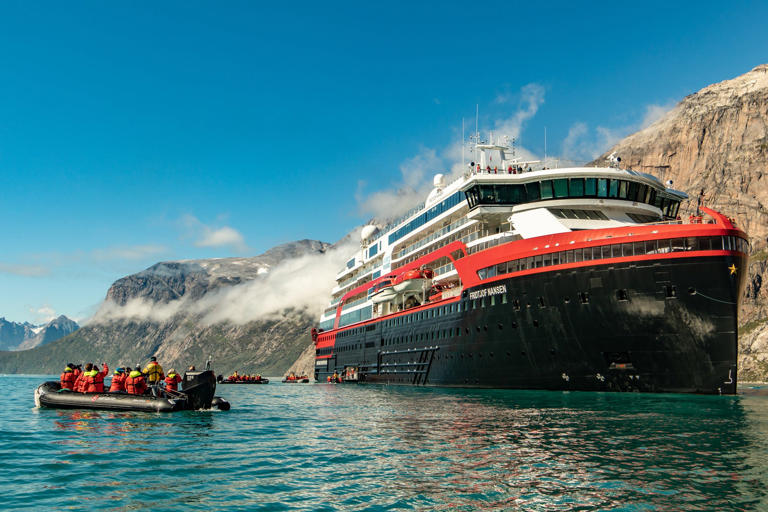

IMAGES
VIDEO
COMMENTS
3. Along the river Kalamas. (60k | 1h20m from Syvota) Running for approximately 115k, the Kalamas is one of the longest rivers in Epirus. It rises near Nemertsika Mountain in the Ioannina region and flows down to the Ionian Sea, forming an impressive delta between Igoumenitsa and Sagiada.
The Bay of Plataria. Plataria is one of the first towns you will encounter when coming from the north. Whilst it is not as picturesque as some other small coastal towns, its location makes it worth a stopover. Sheltered inside a large sweeping bay, it has a long sandy beach and a nice port. There are still a number of plots left in town with no ...
Lefkada. Lefkada is an island in the Ionian group primarily known for its natural beauty, watersports, and some of the most epic beaches in Greece thanks to the steep limestone cliffs that are a feature of its vertiginous west coast. Head to Nidri for sailing, Vasiliki for windsurfing, or the beaches at Egremni, Porto Katsiki, Milos, and Kathisma.
As we move towards the borders of Ilia and Messinia, changing region for the last time in our Peloponnese road trip, we come across a hidden sanctuary, the Neda waterfalls. Leave the car in the parking lot, and start descending the dirt road. After a few minutes of walking, you will be at the entrance.
The Greek island of Corfu (also known as Kerkyra) in the Ionian Sea, off the west coast of Greece, is one of the most beautiful island destinations in Greece. Here's how to find the best of Corfu - both on and off the beaten track. Get the lowdown here on the island's vibe, beaches, food and drink, unmissable sights, activities and hidden ...
10 of the best crowd-free Greek islands and coastlines. Andros island's picturesque main town is on a narrow peninsula on the east coast. Photograph: Free artist/Alamy. Greece is the word on ...
Greece's Ionian Islands: Athens, Kefalonia & Corfu. with Nafplio & the Athens Riviera extension. 12 or 15 days. from $3,619*. A Week in Ancient Greece: Athens, Delphi & Olympia. with Crete & Athens extension. 9 or 12 days. from $2,689*. The Greek Dodecanese Islands: Kos & Rhodes.
Flight time from Athens to Heraklion and Chania is approximately 45 minutes. The ferry connects Crete to several Cycladic islands including Santorini, Naxos, Paros and Mykonos. Ferry timetables and tickets are available on Ferry Hopper. A travel guide to western Crete including Old Town Chania, the best beaches, gorge hikes, waterfalls, hotels ...
West Coast Travel is a family owned tourist agency. With many years of experience in the local tourism sector. T he best activities in the west side of Greece. Preveza, Ioannina, Zagoria, Parga, Paxoi, Sivota, Lefkada are locations that we are offering activities and we can help you organize the best trip ever.
Lefkádha's west coast can compete with anywhere in Greece in its display of dramatic coastal scenery. On both sides of Áï Nikítas, the only real resort, mountainous roads rise and descend from the sea, offering tantalizing glimpses of the stunning sandy beaches, sandwiched between imposing cliffs and turquoise lapping waves.
The largest of the Ionian islands off Greece's west coast, this enchanting, uncrowded place offers beach lovers coves with sandy beaches and azure seas. Always a bit stubborn, set apart, and eccentric, Cephalonia won hearts after Louis de Bernières's 1994 novel Captain Corelli's Mandolin chronicled the island's occupation during World ...
Beyond this incredible profusion and density of cultural monuments, the Peloponnese is also a superb place to relax and wander. Its beaches, especially along the west coast, are among the finest and least developed in the country, and the landscape inland is superb - dominated by forested mountains cut by some of the most captivating valleys and gorges to be imagined.
The 10 Best Beaches in West Greece. 1. Agios Gordios Beach, Corfu. Image Credit: Kritzolina via Wikimedia Commons ( license) Agios Gordios Beach is a hidden gem that has somehow managed to fly under the radar for most tourists. The beach is both soft sand and pebbly, with each end of this stretch of the coast showing a different landscape.
Epirus is a rugged and mountainous region on Greece's west coast. It isn't on most people's Greece travel radars which is a shame as it offers a little something for every type of traveller. Start your Epirus adventure in the charming beach town of Parga. This is a favourite summer getaway for domestic Greek travellers.
West Coast Travel is a family owned tourist agency. With many years of experience in the local tourism sector. T he best activities in the west side of Greece. Preveza, Ioannina, Zagoria, Parga, Paxoi, Sivota, Lefkada are locations that we are offering activities and we can help you organize the best trip ever.
Santorini's east coast is lesser known than the celebrated, elevated west coast. Here, the caldera-edge heights have sloped down to sea level, and volcanic-sand beaches and resorts offer a very different drawcard. ... 16 of the best things to do in Greece. Mar 22, 2024 • 7 min read. Explore world-class ancient ruins, bathe in island sunsets ...
The best known islands of Ionian Greece are Corfu, Paxos, Anti-Paxos, Lefkas, Ithaca, Kefalonia and Zakynthos, but there are many others that are worth a visit. Amongst them are Meganissi, Othonoi, Skorpio, Kalamos, Kastos, Atokos. On the coast, if the conditions allow, it is worth visiting the two little gems of Parga and Mourtos.
West Coast Travel is a family owned tourist agency. With many years of experience in the local tourism sector. T he best activities in the west side of Greece. Preveza, Ioannina, Zagoria, Parga, Paxoi, Sivota, Lefkada are locations that we are offering activities and we can help you organize the best trip ever.
A relatively off-the-beaten-path island a few years ago, Milos has quickly become a popular alternative to Mykonos and Santorini.It's the most southwestern island in the Cyclades, home to white-washed towns, colorful fishing villages and one of the most spectacular beaches in all of Greece.Below is my complete guide to Milos that includes the best beaches, fishing villages, day trips, travel ...
From clear skies to vast seas, a teen travel adventure in Greece will always surpass your expectations. Greece is a country touched by many empires and past civilizations. Ancient ruins, classical sculptures and archaeological treasures are at every turn. Enjoy a swim in the crystal waters, a walk through the cobblestone villages and maybe stop ...
More than 27 million travelers made their way to Greece in 2022, visiting the country's gorgeous islands and coastlines, rural towns, and historic capital city of Athens.One look at its landscapes ...
Program Highlights • Relax in the geothermal waters of the famous Blue Lagoon. • Whitewater raft the Hvítá river. • Venture to the Parthenon and Acropolis. • Spot whales and dolphins on a whale watching experience. • Stand-up paddleboard off the coast of Paros. • Sea kayak to volcanic black and red sand beaches. • Venture below the surface on your lava cave expedition.
Greece & Italy. 17 Days. TRAVEL global adventures. Dates Grades 9 & 10 June 27 - July 13. July 2 - July 18 Waitlisted. July 8 - July 24 Waitlisted. July 15 - July 31 Waitlisted. July 20 - August 5 ON TOUR 11 & 12. June 28 - July 14 Waitlisted.
Many retirees dream of settling down in beautiful West Coast destinations like California, Oregon and Washington for the pleasant climate, coastal access, cultural amenities and relaxed pace of ...
These fun destinations make traveling on your own simple and spectacular. Lyn Mettler|Erin Vasta December 22, 2023 26 Cheap Beach Vacations for Travelers on a Budget
The northeast, home to the Dikti mountains, is one of the island's last unspoilt stretches of coastline, and a world away from the luxury resorts that scatter the coast around Elounda, and the ...
A 6.6 magnitude earthquake hit Japan at 11:14 p.m. Wednesday local time, off the west coast of Shikoku Island.
The total eclipse first appeared along Mexico's Pacific Coast at around 11:07 a.m. PDT, then traveled across a swath of the U.S., from Texas to Maine, and into Canada.
The underlying rock in the East Coast is old, cold and dense, and the faults have had time to heal, meaning that seismic waves travel farther than on the West Coast, where the crust is broken up ...
The west coast of Greenland. ... A Russian icebreaker that expedition travel companies have chartered in the past for such voyages, the 50 Years of Victory, still is occasionally making the trips ...